REQUEST INFORMATION
Don't know which tour is suitable for you.
Let us help you. Please tell us more about your interests. We will send some suggestions based on your needs.

- Trip Finder
- Saved Tours
- Our California office it's now
- 18:50 PM(Tue) - We Are Close
- Tel: 1-909-988-8885 Toll free : 1-855-325-2726 (USA & CANADA)

- Monday to Friday 8:30AM - 5:30PM (PST) Saturday 8:30AM - 3:00PM (PST)
TRAVEL | Where to Go

RURAL JAPAN: 15 OF THE MOST BEAUTIFUL PLACES IN THE WORLD
Article | |--> Dayna Hannah
Share to friends

SEE THE BEST OF RURAL JAPAN IN THESE BREATHTAKINGLY GORGEOUS PLACES ACROSS THE LAND OF THE RISING SUN!
We might be a little biased, but we believe the most beautiful places in the world are in Japan! In the land of the rising sun's countryside, you can experience the passing of the seasons as they paint the lands with spring flowers, autumn leaves, snowy winter scenery, and emerald summers. If you're a nature lover, you can't miss these cities and sightseeing destinations in rural Japan on your next vacation.
1. MOUNT FUJI AND HAKONE - A DAY TRIP FROM TOKYO TO JAPAN’S COUNTRYSIDE

If you don’t have a lot of time, but need an escape from Tokyo , take a day trip to Hakone . One of the best things to do in this little town is to ride the Hakone Ropeway up to Owakudani Valley. On the way up, you’ll get a breathtaking view of Mount Fuji . The climbing season for Mount Fuji is from July to September when the snow melts. Those who brave the summit usually start at Mount Fuji’s 5th Station at night so that they can greet the sun at the peak. If hiking in the dark doesn’t sound appealing, you can rest in a mountain hut.
2. HELLS OF BEPPU HOT SPRINGS - A DESIGNATED NATIONAL SITE OF SCENIC BEAUTY IN OITA, JAPAN

The “Hells” of Beppu are seven gorgeous natural hot springs, which are for viewing and not bathing . You might not feel at one with nature here as the Hells attract visitors from all over the world, but the trails are accessible for any age and ability. One of the prettiest Hells is Umi Jigoku, which is a pond of boiling blue water surrounded by spacious gardens , orange hot springs, and lotus flowers .
3. ITSUKUSHIMA SHRINE ON MIYAJIMA ISLAND - THE MOST BEAUTIFUL PLACE TO VISIT IN HIROSHIMA PREFECTURE

Established by Taira no Kiyomori in 1168, Itsukushima Shrine is best known for its iconic “floating” torii gate and cherry blossoms . After visiting the shrine , take the time to explore the abundant nature and untouched forests of Miyajima Island . You can also climb Mount Misen on one of three hiking trails and take in the view of Hiroshima Bay.
4. SHIRAKAWAGO - A UNESCO WORLD HERITAGE SITE WHERE YOU CAN STAY THE NIGHT

One-hundred-eighty farmhouses make up Shirakawago Village . What separates these from other ancient homes in Japan are their distinctive thatched roofs, which come together like hands in prayer. This so-called gassho-zukuri architecture made it possible for farmers to live through the region’s harsh winters centuries ago. Now, you too can experience staying in this type of house as about a dozen are open for travelers to book.
5. TAKACHIHO GORGE IN MIYAZAKI JAPAN - A NATURAL WONDER OF THE WORLD

Sheer cliffs on the Gokase River make the narrow chasm of the Takachiho Gorge —the treasure of Miyazaki Prefecture. If you rent a rowboat, you’ll come across the cascading Minainotaki Waterfall. You can also see it from above on a paved path. Spotlights illuminate the area from sunset to 10:00 pm on warm summer nights.
6. MOTONOSUMI INARI SHRINE - 123 TORII GATES ON THE SEA OF JAPAN

The secluded Motonosumi Inari Shrine sits on the picturesque cliffs of Yamaguchi’s coast. The red torii gates lead you down a footpath that stretches over 100 meters. The end of the trail takes you to a viewing area over the shoreline. Weathered grooves and holes riddle the cliff face, and water bursts up through them like geysers when the waves hit.
7. THE BLUE POND IN BIEI JAPAN - SEE BEAUTIFUL SCENERY YEAR-ROUND

After the eruption of Mount Tokachidake, Biei City built the Blue Pond to control the erosion. Without meaning to, they created one of the most scenic places in Japan . A mixture of natural minerals in the pond’s water creates an iridescent blue that shines through even when it freezes in winter. Surrounded by autumn leaves in fall and lush greens in summer , the Blue Pond is well worth the trip any time of year .
8. OIRASE NATIONAL PARK’S MOUNTAIN STREAM - HIKING IN JAPAN’S BEAUTIFUL LANDSCAPE

The Oirase Mountain Stream in Aomori Prefecture is the only outlet from Lake Towada . Over a dozen waterfalls pour into a gorge, which creates the stream. It’s particularly striking when the autumn leaves reach their peak colors from late October to early November. An easy day hike leads you through the upper passage, which takes most people around two and a half hours to complete.
9. MATSUSHIMA - ONE OF THE MOST SCENIC PLACES IN JAPAN

For centuries, Japanese people have considered Matsushima Bay as one of the top three most beautiful places in the country. Over two-hundred small islands dot the crystal water, and thousands of pine trees color the land. The best way to see the bay is by boarding one of the many sightseeing cruises . It takes around five to ten minutes to walk from Matsushima Kaigan Station to the pier, and you can choose short or long routes to remote regions.
10. KINOSAKI ONSEN - ONE OF THE BEST HOT SPRINGS IN JAPAN

Kinosaki has been the premier place to relax and recharge in the Kansai region since the 8th century. The healing waters that pump into the town's traditional ryokans are one reason to visit, but the atmosphere separates Kinosaki from other onsen areas. Nearly everyone walking along the willow-lined river wears a cotton yukata kimono as they scurry from bathhouse to bathhouse.
11. TAKEDA CASTLE - THE RUINS OF THE SKY PALACE

Although there aren’t any buildings left of Takeda Castle , you can explore the foundations of the central fortress and three wings. The best time to go here is in October and November at sunrise. On these days, clouds form around the ruins, and Takeda Castle seems to float on top of them. The most attractive viewing points take about thirty or forty minutes to reach on foot.
12. TOTTORI SAND DUNES - THE DESERT OF JAPAN

While the rest of the country boasts mountains, forests, and rivers, dunes span the coast in Tottori . Some measure at two kilometers wide and fifty meters high, but the tides and coastal winds continuously change the landscape. You can ride a camel, board a horse-drawn cart, or try paragliding and “sandboarding.” Near here, you can also find the Sand Museum, where Japanese and international artists create statues from the sand.
13. SHIMANAMI KAIDO - WHERE TO TAKE A BIKE RIDE IN JAPAN

The Shimanami Kaido bridge connects Honshu and Shikoku, and you can cross it either on foot or by bicycle. The 60-kilometer route passes through six small islands that have small towns and a few attractions. Travelers can rent bikes at one of many terminals. Most people prefer to cycle here in early November when the weather is warm and mild.
14. AMANOHASHIDATE - THE BRIDGE IN HEAVEN

In the northern region of Kyoto Prefecture , 8,000 pines grow on a sandbar that rises out of Miyazu Bay. The treeline stretches over the ocean from one coast to another. If you bend over and stick your head between your legs, they look like a bridge in the sky. Along with Matsushima Bay and Miyajima Island, Amanohashidate is one of the top three most scenic views in Japan.
15. SHIRETOKO PENINSULA CRUISE - A TOUR OF JAPAN’S WILDLIFE

The rugged Shiretoko Peninsula is part of an unspoiled national park in Hokkaido. From April to November, you can take sightseeing cruises along the coastline to cliffs and waterfalls that are otherwise inaccessible. The highlight of the journey is the wildlife on the rocky beaches and in the ocean. Depending on the season, you might spot dolphins, whales, brown bears, and more.
SEE JAPAN’S COUNTRYSIDE ON OUR SAMURAI, GARDENS, & ARTS TOUR
Blog categories.
Food & Drinks
Special Events
Subscribe for Blog
Don't know which tour is best for you let us help you..
- Request Information
- share trip finder saved tours inquiry book now

Email Signup
Rural Discovery Tour
Discover the Hospitality of Rural Japan
Tour Highlights
brief explanation of what this Tour offers goes here.
Tour highlights
- Home-Stay in Kameoka, A Unique Opportunity to Discover the Japanese Culture in Depth
- Explore Rural Japan with Your Host
- Kyoto, the Ancient Imperial Capital
- The Great Buddha of Nara in Todaiji Temple
What's Included
- Airport Pick-up and Orientation
- Destination Transfers
- Accommodations
- Meals, Guides and Activities as detailed
- Assistance from our Japan Office
Our Commitment
- Trips of Experience
- Personal Service
- Commitment to Excellence
- Responsible Travel
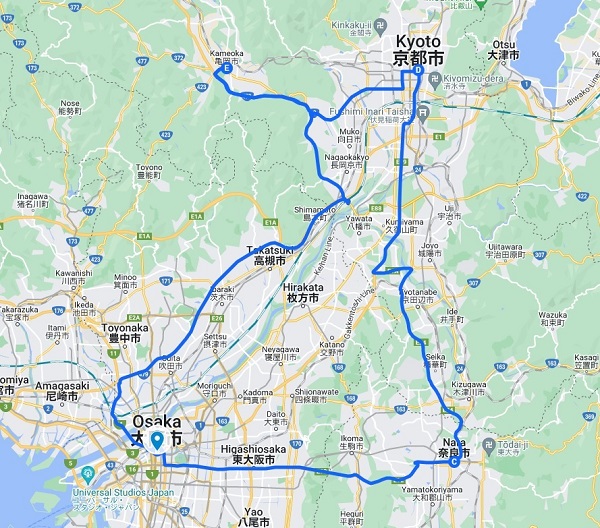
Our Rural Discovery Independent Tour will introduce you to rural Japan and its people while staying with a Japanese family. Of course, you will see some amazing sights but the point is to sit down and talk with Japanese people, learn how Japanese live, and experience something beyond traditional sightseeing. Our rural home-stay tour will give you stories that you will remember long after your photos have faded.
During your rural home stay opportunities are endless…
*Learn to cook traditional Japanese dishes
*Explore the village by bicycle or on foot, visit Izumo Daijingu Shrine and the Anao Temple which usually do not welcome tourists
*Experience a traditional tea ceremony, try Japanese ikebana (flower arrangement), write Japanese calligraphy, and try to play the Koto (traditional Japanese stringed instrument) with our local cultural experts and artisans
*Ride riverboats through the Honzu River Gorge, an ancient trade route to Kyoto
*Tour a local sake brewery, a tofu maker, a pottery studio, a antique shop
*Relax at the Hiyoshi Hot Springs, treat yourself to a Shiatsu massage
*Bonsai workshop
*Visit the world’s best whetstone excavation site
*Journey through rice paddies and farmlands to the historic mountain village of Miyama
This tour can be fully customized. The below itinerary is an example of a Classical custom tour. Price per person based on double occupancy for two travelers: Classical : from US$2,710 Superior : from US$3,810 Luxury : price upon request
Sample Itinerary
The tours featured throughout our website are intended to give you ideas for what's possible when you travel with us. Treat them simply as inspiration, because your trip will be created individually by one of our specialists to match your tastes and budget.
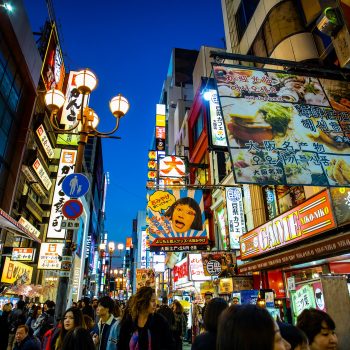
Your airport pick up will meet you at Kansai International Airport (assuming your flight arrives after 8:00am and before 21:30) and will take to your hotel in Osaka by public transportation. They will give you an orientation, hand you your transportation tickets, give you your rental pocket internet device, check you into your hotel, and answer any of your questions. You will be on your own for dinner but your airport pick up will make a few suggestions. Osaka is huge city with down to Earth people who are very proud of their cuisine, most notably okonomiyaki (a pancake-based dish containing vegetables, meat, and/or seafood), takoyaki (octopus dumplings) and udon noodles. These dishes are not fancy but are like the people of Osaka, friendly and open. The train from Kansai Airport to Namba Station in Osaka will take about 45 minutes.
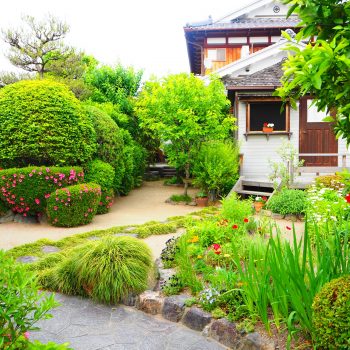
Rural Kyoto
Today you will take a train to Kyoto and then to the rural town of Kameoka. You will meet your guide/host at Kameoka Station who will take you to your home for the next 2 nights. This quaint rural town is located on the other side of the mountains that surround Kyoto but is a world away. You will stay in your guides home and they will show you around their neighborhood before settling in for the evening dinner and conversation. If the weather is nice you may consider an evening stroll before heading to bed. The train from Namba Station in Osaka to Kameoka Station will take about 1 hour.
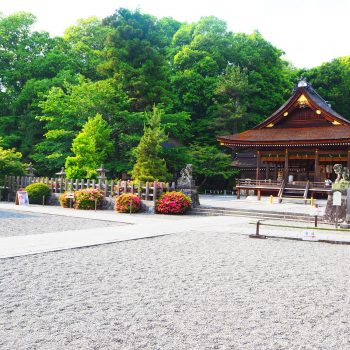
Today you will start your in depth exploration of Kameoka along with your guide/host. Here the possibilities are endless: you can explore Kameoka by bicycle or on foot and also learn about Japanese cooking, flower arrangement, pottery, and much, much more. If you are interested your guide may introduce you to some of their artisan friends which will further expand your understanding of Japan. For lunch (not included) you will stop in a local restaurant that tourists could ever find. In the evening you will head back to your host’s home for dinner. This is really the best way to experience Japan.
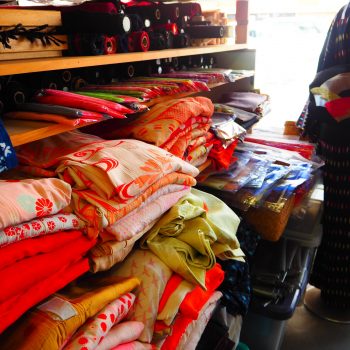
Rural Kyoto & Kyoto
Today you will cross the mountains and head to Kyoto, formerly the imperial capital of Japan. If you are traveling in Japan during the warmer months you may consider taking a traditional boat ride from Kameoka to the Arashiyama area of Kyoto. These boat are expertly guided down the river much as they were during the Edo Period. While in Arashiyama you will take a stroll through Kyoto’s famous bamboo forest before exploring other areas of this amazing part of the city. For accommodations you can chose from a ryokan inn, machiya townhouse or hotel. The trip from Kameoka to Arashiyama by train take only 15 minutes.
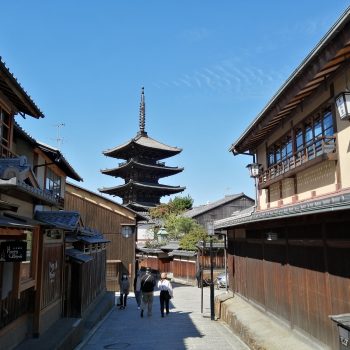
Your private local guide will meet you at your hotel and will show you the ancient imperial capital of Kyoto. Your guide will not work from a predetermined itinerary and will show you sights that are interesting to you. They are also very flexible and can make on the fly changes to fit your style, mood, weather and crowds. Possible sights in Kyoto include Higashiyama, Kiyomizudera, Gion, Nishiki Market, Kimono Museum, National Museum, Manga Museum, and many other possible temples, gardens, museums and so on. Only the best local guides can offer this kind of flexibility. Due to the flexible nature of your sightseeing, we do not include transportation, entry fees or meals while you are with your guide. If you have any specific sights you want to visit with your guide please let us know.
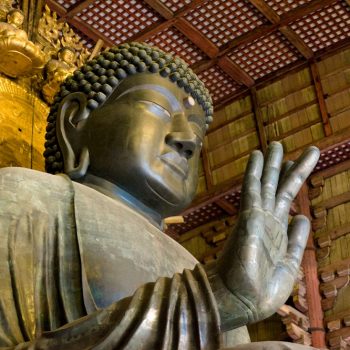
Nara is located near Kyoto and was the imperial capital from 710 until 784 before it was moved to Heijo-kyo (Kyoto). During this period, a large number of shrines and temples were erected under the protection of the imperial family and aristocrats. However, the monks in the surrounding hills started ro gain too much influence and eventually tried to seize power from the Shinto emperor. It was decided to move the capital to Heian-kyo, nowadays known as Kyoto. Many of the temples built at the height of Nara power, like the Todaiji and Horyuji temples, are currently registered as World Heritage Sites. Both Japanese and foreign tourists visit the city to see these temples, to walk among the free-roaming deer of Nara park or to visit some of the beautiful scenic mountains surrounding the city. You will return to Kyoto for the evening. The train from Kyoto Station to Nara Station will take about 45 minutes.
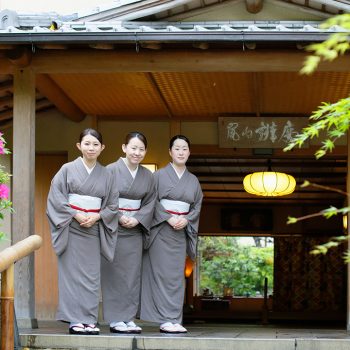
Today will be your last day in Japan and your last chance for sightseeing and shopping. You will take a train from Kyoto Station to Kansai Airport following the directions in your personalized tour organizer.
Other Tours Similar To Rural Discovery Tour

Cultural Diversity Tour
Experience the diverse cultures of japan.
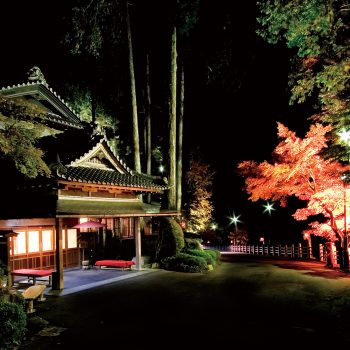
Ancient Japan & Shodoshima Tour
Traditional japan and shodoshima.
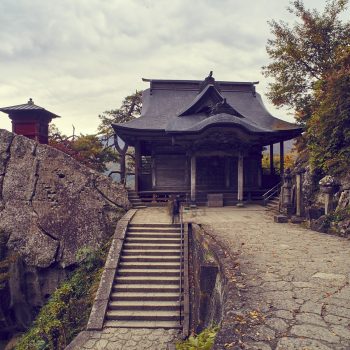
Best of Northern Japan
Fine cuisine, temples and hot springs.
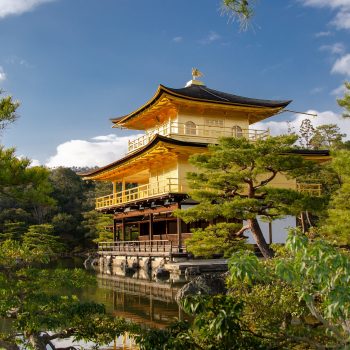
Classical Japan Tour
Must see sights of japan, virtual map tour.
Open Iframe
Rural Discovery Tour In Pictures

What Our Customers Have To Say
John moawad.
It was our first trip to Japan. Working with Jeff was a pleasure. His knowledge of the country and local contacts were very helpful. Choice...
Marina Boyer
North central exploration.
Working with Jeff at Rediscover Tours was a wonderful experience. He helped me plan a 10 day trip of a lifetime to Japan with my mother...
Shoguns and Samurai
I would like to take this opportunity to commend and thank you for the marvelous vacation we recently enjoyed in Japan. The entire experience exceeded...
Our Team Of Local Experts
Our team of Japan experts have all lived in Japan for years and know its the hidden treasures. Our team is here to answer all your questions and to build your tour just the way you want it.
Jeff Aasgaard
Jeff was born in a south suburb of Chicago named South Holland and lived in Japan for 14 years. He now lives in Commerce Township, Michigan with his wife Yoshimi, son Shota, and daughter Mina. He enjoys playing with his kids, volunteering with his daughter’s marching band, cycling and training and teaching Aikido.

Michiyo Kakiuchi
Michiyo was born in Noboribetsu, Hokkaido Prefecture though currently lives in Takarazuka, Hyogo Prefecture. Her main passions in life is traveling all around the world and enjoying their cultures.

Izumi Yamauchi
Izumi has spent most of her life in the Kansai region, except for the 10 years that she enjoyed in the UK. Living abroad has made her appreciate her own culture and local beauty even more. She currently lives in Osaka with her family, including two cats and two dogs.
Why Rediscover Tours
Great trips don't just happen; it takes expert knowledge and years of experience to create a truly memorable holiday. You can rely on Rediscover Tours to make your perfect Japanese experience. Our dedication to excellence makes the difference.

Trips Made for You
Your Japan travel expert will create your trip just for you
Your interests and travel style will be front and center when designing your tour
Accommodations will be selected based on your style and we will inform them of all your special meal and physical requirements
Japan Experts
Your Japan expert has lived in Japan or is Japanese
They know the hidden treasures of Japan that you will love and most tourists miss
Most of our team lives in Japan giving them first hand knowledge of the latest trends and experiences for you to enjoy
Finest Guides
Private local guides add a whole new depth to your Japanese tour
We only hire the best guides and review each trip with them insuring excellent experience
Your private guide will listen to you, show you sights of interest and will make on the fly changes to match the weather and crowds
With Confidence
Our office in Japan is here to assist and support you
Rediscover Tours has been organizing travel to Japan since 2000
You will arrive comfortable in the knowledge that all details are taken care of and that our Japan office is just a call away
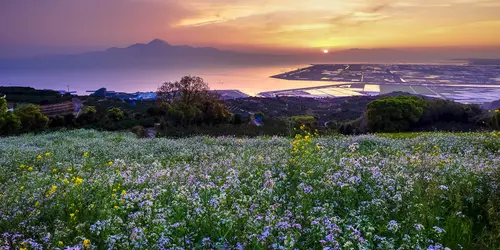
Japanese countryside on the island of Kyushu in Japan, near Kumamoto
©Pxfuel / DMCA
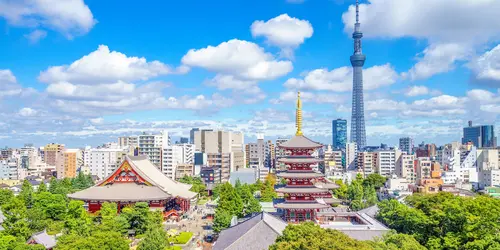
Asakusa: the Senso-ji temple and the Tokyo Sky Tree: a fascinating Tokyo district that's a must-see
chan Richie/123RF

Twin room at the equivalent 4* Metropolitan Ikebukuro hotel in Tokyo
metropolitan Ikebukuro
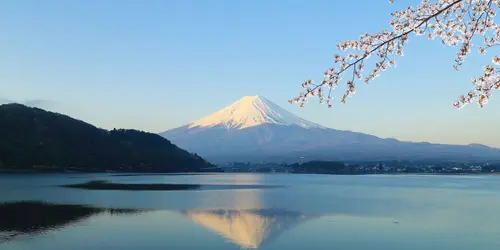
Mount Fuji during cherry blossom (Sakura)
©geargodz/123RF
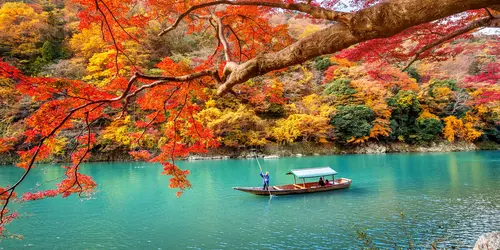
River in Arashiyama during fall : famous touristic site to visit in Kyoto
©Tawatchai Prakobkit/123RF
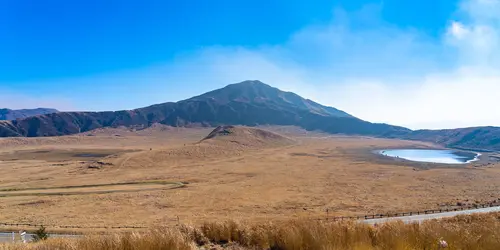
Mount Aso on the island of Kyushu is the largest of Japan's volcanoes, but also one of the most active.
©shawnccf/123RF
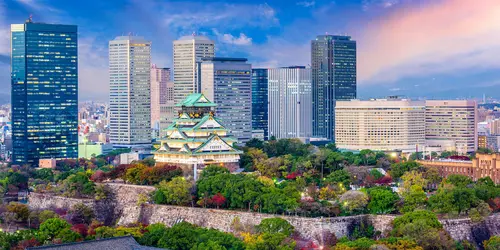
Osaka Castle in Japan is surrounded by the skyscrapers of the city's central business district
©Sean Pavone/123RF

Some of the hotels on the tour offer rooms with a fusion of Western and traditional Japanese styles
- Travel insurance
- JAPAN EXPERIENCE
Urban and Rural Japan
- Duration : 21 days
- Locations : Tokyo, Hakone Mt Fuji, Kyoto, Nara, Naoshima, Osaka, Kobe, Takachiho, Kumamoto, Nagasaki, Hiroshima, Miyajima
- Add to favorites
This 3 week, comprehensive guided tour will take you on a journey through a Japan of contrasts, both historical and rural.
After Tokyo, Kyoto, Mount Fuji and Koyasan, take a boat trip to discover the Japanese countryside on Kyushu. Finish off with the sacred island of Miyajima.
Small group of 8 people, accompanied by an English-speaking guide and specialist. An unforgettable trip.
3 week itinerary in Japan (21 days) :
- Tokyo (4 days)
- Hakone - Mount Fuji (1 day)
- Kyoto (5 days)
- Nara (1 day)
- Sacred valley of Koyasan (1 day)
- Osaka & Kobe (2 days)
- Bateau Osaka/Kobe -> Kyushu (1 night)
- Kyushu ( Takachiho, Kumamoto, Nagasaki (4 days)
- Hiroshima & Miyajima (2 days)
- Osaka (1 day)
Please find below the itinerary details.
WARNING : The tour departure and end dates presented on this page relate to your stay in Japan. On departure, you will have to leave Europe on the day before. The return flight is on the same day due to the time difference. For further details, refer to "More about your trip".
Why this trip to Japan
- Supervision by a bilingual English-speaking guide, a specialist in Japanese culture
- Almost full package : guide, accommodation, transport and most meals
- Small groups of between 6 and 8 people maximum.
- A visit to the must-sees on a first trip to Japan, and the little-known Kyushu Island.
- 3 and 4* hotels , 4 nights in traditional accommodation (ryokans, temple) and 1 night on a boat
- Variety of visits, activities, gastronomy and transport (Shinkansen, mini-bus, boat...)
- Three free days in Tokyo, Kyoto and Nagasaki can be organized
- 40 years of expertise from Japan Experience , European leading travel agency in Japan
Your trip in detail
Day 1 : sunday - yokoso - welcome.
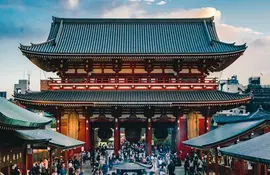
Senso-ji temple in Asakusa, Tokyo
©Moiz K. Malik/Unsplash
Arrival at Tokyo airport (Narita or Haneda). Welcome to Japan! Yokoso 日本へようこそ!
Welcomed out of customs by our airport assistant. Unaccompanied transfer from the airport to Tokyo (see details).
This transfer is done in a shared shuttle or bus, with other guests departing for the same hotel or a hotel close to yours. These transfers depart between 1.5 and 3 hours after your scheduled flight arrival and stops can be made before your hotel.
If you would like a private, non-stop transfer directly after the actual arrival of your flight, feel free to take the "Private Taxi from the Airport" option.
Accommodation at Hotel Metropolitan Ikebukuro or an equivalent 4* (rooms available from 3:00pm).
Welcome by the guide at 7:00pm. Introduction of the tour by the guide during a welcome dinner.
Dinner provided by Japan Experience.
Day 2 : Monday - Traditional and Modern
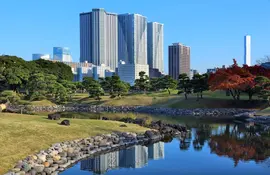
Hamarikyu gardens : One of Tokyo must see
©tupungato/123RF
Breakfast at the hotel.
Departure around 8:30 am, guided tour of Tokyo : - Ginza , Tokyo's chic district - Hamarikyu, the Japanese garden amongst Tokyo's buildings - Asakusa , a traditional district and place of pilgrimage - Sensô-ji Buddhist temple, one of the city's oldest - Tokyo Sky Tree and its panoramic view of Tokyo, reaching a height of 643m.
Meals (lunch, dinner), provided by Japan Experience.
Transportation for the day on public transport, and on foot (about 8 km in total).
Day 3 : Tuesday - The effervescent metropolis
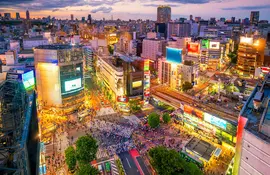
Tokyo's famous Shibuya intersection - probably the world's largest crosswalk
©Wasin Pummarin/123RF
Continue to visit Tokyo with your tour guide - Visit to Ueno district : The park full of cherry trees and the lotus pond Shinobazu ; - The trendy district of Harajuku ; - The imperial Meiji Jingû yemple ; - The young and crazy Takeshita-Dori alley ; - The Japanese "Champs-Elysées": Ometesando, fashion capital ; - Shibuya and its famous “crossing”.
Day trips by public transport and on foot (about 10 km in total).
Day 4 : Wednesday - Free day
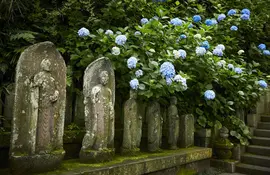
The Hasedera temple, in Kamakura: flower garden, sea view or even an eleven-headed statue!
Free day , which you can spend seeing many other monuments and interesting sites of the capital and its surroundings: your guide will be able to advise you.
breakfast at the hotel is provided by Japan Experience . The other meals, transport and visits are your choice.
Day 5 : Thursday - On the road to Mount Fuji
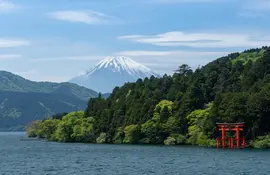
Mount Fuji from Hakone lake
©Alessandro Pacilio/123RF
Baggage transfer to Kyoto organised by Japan Experience (1 bag per person). Take a small bag for the night in Hakone - Mount Fuji.
Travel by train and Shinkansen to your hotel in the centre of Hakone - Mount Fuji (around 1 and a half hours).
Depart by minibus to the heights of Hakone for a breath-taking view of Mount Fuji (If weather conditions allow it) - Promenade along the old Tokaido road which linked Tokyo to Kyoto ; - Lake Ashi-no-ko and its Japanese portico torii with feet in the water ; - The incredible volcanic site of Owakudani (The sight can be inaccessible due to volcanic activity).
Stay in your ryokan (traditional Japanese hotel).
Daily trips by train, minibus and on foot (about 2 km in total).
Day 6 : Friday - From Mount Fuji to the former capital
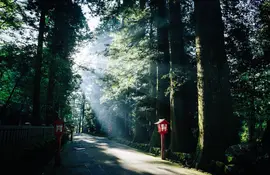
Komorebi on old Tokaido road in Hakone : the scattered light when sunlight shines through trees
©Syukei Inoue/Unsplash
Traditional Japanese breakfast at Ryokan (quite salty).
Depart on foot and public transport to open air sculpture museum in Hakone .
At the end of the morning, leave for Kyoto by Shinkansen (2 hours).
Check-in at General Kyoto Takatsuji Tominokoji hotel or similar.
Day trips by public transport, ultra-fast Shinkansen train, and on foot (about 5 km).
Day 7 : Saturday - Millennium treasures
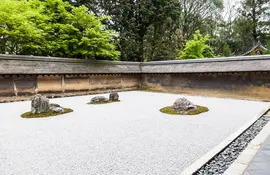
Visit Ryoan-ji, Kyoto, the most famous rock and zen garden in Japan
©Philippe Voisin
Visit Kyoto by minibus : - Ryoan-ji zen garden ; - Kinkaku-ji ( Gold Pavilion ) and Ginkaku-ji ( Silver Pavilion ), the bewitching path of philosophy ; - The charming village of Ohara, in the suburbs of Kyoto : the Sanzen'in green temple and visit the surrounding Japanese countryside (rice field, Japanese vegetable fields: tsukemono, shiso, etc.).
Day trip by minibus.
Day 8 : Sunday - Free day
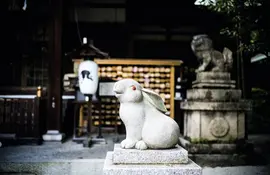
Okazaki Shrine in Kyoto
Free day : enjoy the former capital’s incredible sights at your own pace. Your guide will be able to advise you.
Please note only breakfast at the hotel is provided by Japan Experience . The other meals, transport and visits are your choice.
Day 9 : Monday - Castle and traditions
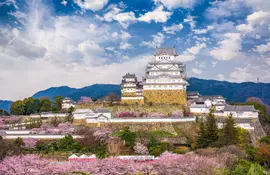
Himeji Castle, UNESCO world heritage, easy access from Kyoto for a 1-day excursion
- Excursion by Shinkansen (50 minutes) to Himeji castle (UNESCO heritage sight) ; - Lunch at Himeji and return to Kyoto by Shinkansen ; - Visit the fabulous sanctuary of Fushimi Inari with 10,000 torii; - Evening stroll in the Pontocho district.
Meals (lunch, dinner), provided by Japan Experience.
Day trips by Shinkansen, taxi and on foot (around 7 km in total including ascent and descent of Fushimi Inari).
Day 10 : Tuesday - Country Escape
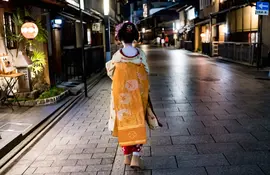
A geisha walking in Gion, Kyoto old town
- Depart by minibus for Miho Museum* built on the top of a mountain by the architect I. M. Pei. (Famous for his design of the Louvre Pyramid) ; - Excursion off the beaten track , in the Kyoto countryside , to discover the fields and tea producer ; - Evening walk through the picturesque Sannen-zaka & Ninnen-zaka streets of the Gion district.
We must draw your attention to the fact that it is strictly forbidden to take photos in the historic district of Gion.
Daily trips by minibus and by foot in the evening (around 3km).
*On certain dates, not currently defined, the Miho Museum will be temporarily closed to renew their collections.
Day 11 : Wednesday - The first capital
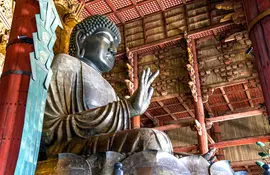
Todai-ji temple and its imposing statue of the buddha : a must-see in Nara
©Surachet Shotivaranon/123RF
Breakfast at the hotel in Kyoto.
Baggage transfer to Osaka organised by Japan Experience (1 bag per person). Take a small bag for your two nights in Nara and Koyasan : Train journey to Nara (50 minutes).
Visit Nara , the first Japanese capital in the 8th century. - The Shinto Kasuga Taisha temple and its thousands of lanterns; - The Todaiji , its large bronze Buddha and the imposing Nan-Daimon gate; - The Kofukuji temple and its lovely pagoda.
Meals (lunch, dinner) provided by Japan Experience.
Check-in at the Daiwa Roynet Nara hotel or similar.
Day trips by train and on foot (about 4 km in total).
Day 12 : Thursday - Attack on the Sacred Mount
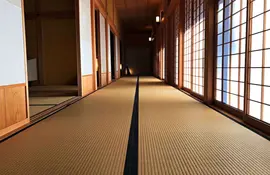
Shukubo - Hotel temple in Japan
©SOE AUNG LIN/123RF
Depart on train and cable car to the sacred mountain of Koyasan (2h30). - Visit the sumptuous Kongobuji temple; - Visit Danjo-Garan , one of the main religious sites of the village.
Day trips by train and on foot (about 3 km in total).
Enjoy a unique experience with a traditional vegan dinner and overnight in a temple with the monks. Due to the altitude, the temperature in Koyasan is often lower than other cities visited previously.
Please note: In most temple hotels, bathrooms and toilets are shared, apart from the traditional Japanese room. However, we have selected the few temples that offer a toilet and washbasin in the room. In very high season, these rare temples may be full and we may be obliged to book 'classic' rooms without a bathroom or washbasin.
Day 13 : Friday - the gastronomic capital
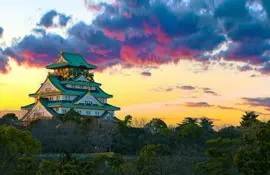
Osaka castle is surrounded by a park full of cherry and plum trees
©Josemaria Toscano/123RF
Traditional vegan breakfast served in the temple. Depending on availability of the monks, possibility to attend a Buddhist ceremony (availability not guaranteed currently).
- In the morning, discover the fabulous mystical necropolis of Okunoin .
- Head to Osaka by train (2 hours), afternoon shopping, and night tour of the city : the lively district of Namba and Dotonbori street.
Day 14 : Saturday - Take off
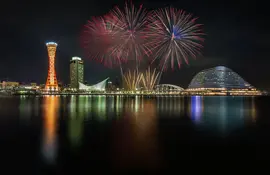
You can spend nice evening visiting Kobe city and port, close to Osaka and Kyoto by train
©pat138241/123RF
Breakfast at the hotel. Depart for Kobe , cosmopolitan city : - Sannomiya and Kitano districts ; - Visit the Hanshin earthquake museum , depending on the time left. Board the ferry and cruise overnight to the port of Oita on Kyushu island. Meals (lunch, dinner), provided by Japan Experience. The Sunflower company reserves the right to move the departure to Osaka, Japan Experience may have to modify the program for the day. The visit to Kobe can be replaced by this city: vintage Shinsekai district (Tsutenkaku tower) and Keitakuen garden. The ferry will arrive in Beppu in this case, the group will visit two of the most famous offshore lighthouses ( j igoku) there, before continuing on the normal route (Usuki). Day trips by minibus, on foot and ferry.
Day 15 : Sunday - Spiritual et natural
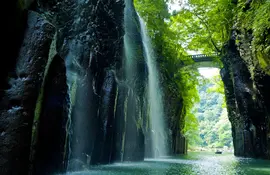
Takachiho Gorge, one of the hidden gems of Japanese nature
©Payless images/123RF
Breakfast aboard the ferry Route to Usuki : visit to stone Buddha sights. Route to the sacred Takachiho sight, mountain village known for its Japanese legends and magnificent ravines. Takachiho : - Gokase river gorges one of the most beautiful natural sites in Kyushu ; - Amanoiwato Jinja Shinto temple, Japan's second most sacred site ; - Evening show of sacred dances (divine gestures) Iwato Kagura.
Overnight stay at Solest Takachiho or equivalent . Meals (lunch, dinner), provided by Japan Experience. Day trips by minibus and by foot.
Day 16 : Monday - To Aso !
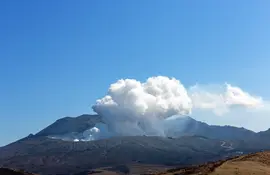
©danielvfung/123RF
Breakfast at the family-run hotel. Before going to Kumamoto , visit the famous Mount Aso on the road. It’s the largest volcano in Japan, and has an unmissable caldera and its volcano museum. In Kumamoto, the magnificent Suizen-ji garden.
Overnight at REF Hotel Kumamoto or equivalent . Meals (lunch, dinner), provided by Japan Experience. Day trips by minibus, public transport and by foot.
Day 17 : Tuesday - The Venice of Kyushu
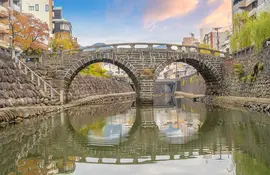
Nagasaki has always been Japan's gateway to the world
Breakfast at the hotel. Heading towards Shimabara , the setting of the heroic Shimabara Rebellion in the 17th century, followed by an exploration of Mount Unzen , an active volcano with fascinating geothermal wonders. Depart from Shimabara to Nagasaki via Okawachiyama, birthplace of pottery and ceramics. In Nagasaki, discover the Megane Bashi “glasses” bridge.
Accommodation at Richmond Hotel Nagasaki Shianbashi or equivalent . Meals (lunch, dinner), provided by Japan Experience. Daily trips by ferry, minibus, and on foot.
Day 18 : Wednesday - Free day
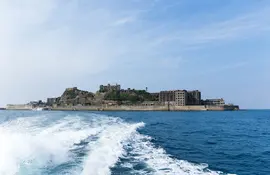
The ghost island of Gunkanjima, near Nagasaki. Former coal mine, it housed more than 5,300 workers
©Leung Cho Pan/123RF
Breakfast at the hotel. Free day* : enjoy the charms of the old port, gardens, churches and temples at your own pace. Your guide will be able to advise you. Please note: only breakfast at the hotel is provided by Japan Experience . The other meals, transport and visits are your choice and not organized by Japan Experience.
Day 19 : Thursday - A historic city

The sacred island of Miyajima and its famous torii with feet in water, worth a visit off Hiroshima in Japan
Breakfast at the hotel and baggage transfer to Osaka organised by Japan Experience (1 bag per person). Take a small bag for the night in Miyajima. In the morning, take the Shinkansen train to Hiroshima (3 hours) : The Peace Memorial Park and its museum (Hiroshima Peace Memorial Museum) ; The peace monuments (the dome , the memorial to the young Sadako Sasaki, one of the many victims of the radiation). Ferry to Miyajima , sacred Shinto island. Visit to Itsukushima-jinja sanctuary and its big entrance gate (ootorii)*.
Accommodation at ryokan or hotel. Meals (lunch, dinner), provided by Japan Experience. Daily trips by public transport, by shinkansen, by boat and on foot. Please note : the ootorii is under construction until an indefinite date.
Day 20 : Friday - The sacred island
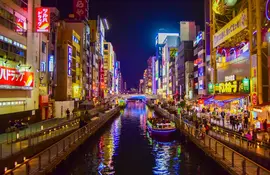
Dotonbori is one of the principal tourist destinations in Osaka, running along the canal in Namba.
©Juliana Barquero/123RF
Breakfast at Ryokan Visit to Miyajima : between temples and deer. - Folklore museum (Egami house) ; - Senjôkaku Shinto temple and pagoda ; - Shopping street for your final purchases. Depart for Osaka : ferry to Miyajimaguchi (Miyajima), train then Shinkansen (2 hours 50 minutes).
Accommodation at Hiyori Hotel Osaka Namba Ekimae or equivalent . Meals (lunch, dinner), provided by Japan Experience. Day trips by public transport, by Shinkansen, by boat and on foot.
Day 21 : Saturday - Sayonara - See you next time
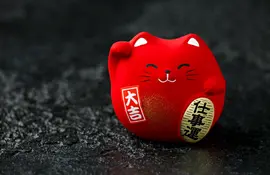
Sayonara - bye bye Japan !
©Maksims Grigorjevs/123RF
Transfer to Kansai International Airport (KIX) by direct train or shuttle bus, depending on the location of your hotel.
Transfer to Itami Airport (ITM) is not provided by Japan Experience. Meals not covered by Japan Experience. Return flight to Europe.
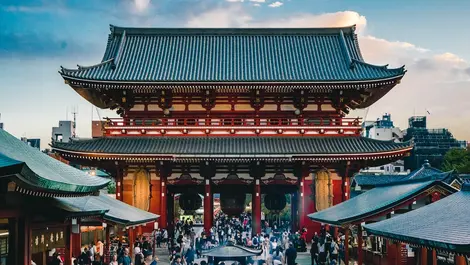
Included in your guided tour
Accommodation
- 15 nights in 4* and 3* hotels equivalent
- 2 nights in a ryokan at Hakone - Mount Fuji (room with private bath and toilet)
- 1 night in a Buddhist temple at Koyasan
- 1 night on the Sunflower ferry
The basic rate includes a twin room for two people.
- Transfer airport <> Tokyo
- Prepaid public transport card
- Other transport during your stay, except on free days
- Luggage transfer (see details of the stages)
Experiences and meals
- Guidance from an English-speaking specialist on Japan
- Tours and activities mentioned in the programme
- Almost full package : all meals (except free days and half of the dinners during the stay)
Additional services
- Unlimited Wi-Fi access, except on free days
- Power adapter for Japanese plugs (not for UK plugs)
- Complete travel diary sent 20 days before your departure
- An informative meeting 1 to 2 months before your departure, in our agency or at a distance
- 24/7 telephone assistance in English; in addition to the guide's assistance during the day
Not included in the price of your trip
- Flights Europe <> Japan
- Optional insurance policies
- Personal expenses (including 5 dinners at your leisure and expenses for the two free days)
- Drinks with meals (except water and sometimes tea)
- Anything not included in the "included in your tour" section
À propos du risque d’annulation de votre circuit accompagné
Même s’il y a très peu de risque que votre circuit accompagné soit annulé, ce risque existe. Il est habituellement de 4%.
Si vous êtes malheureusement dans ces 4%, vous êtes informé 3 à 2 mois avant et nous vous proposons TOUJOURS un autre circuit, à la même saison et la plupart du temps aux mêmes dates. Nous proposons également, en alternative, 100 % de remboursement du circuit (hors vols).
En 2023, sur 300 clients circuits accompagnés, 12 ont été ré-orientés sur un autre circuit et 0 sont restés chez eux.
More about your trip
Your tour :
- The tour guide can modify the programme according to the day's constraints.
- The prices displayed on this page may vary according to the exchange rate of the Japanese ¥.
- Unfortunately, this tour is not accessible to people with reduced mobility.
- Children and babies accepted. It should be noted, however, that the program may be difficult for these people to follow. From 3 to 11 years old a child rate is offered. In each accommodation, a standard adult bed will be offered to them, and a standard seat will be allocated to them in transport. From 0 to 2 years old inclusive, a "baby" rate is offered. This price corresponds to the allocation of a cot in the majority of the accommodation of the chosen tour. However, we cannot guarantee a baby cot in each accommodation.
- Pets are not allowed
- For vegetarians, vegans or people with a strict diet: there are few vegetarian or even fewer vegan restaurants in Japan. Therefore, and as it is a group trip, Japan Experience will not be able to adapt to the diet of each person. The guide will, however, be able to help within each restaurant in choosing the dishes that best suit each person.
- Your travel documents will be given to you as follows:
- Travel diary given during the information meeting 1 month before your departure. If you cannot make it to this meeting, it will be sent to your home 2 weeks before departure.
- The e-travel diary, as well as your e-documents of travel will be sent to you by email 3 weeks before departure.
- The airport transfer tickets will be given to you by our airport assistant on your arrival.
- The other physical documents necessary for the trip will be given to you by your tour leader when you meet at 6PM in your hotel on the first day.
- This programme is subject to change due to circumstances such as weather conditions or any other case of force majeure. The order of visits may also be modified. Please note that due to the current circumstances, any information mentioned is subject to change or modification.
Your accommodation :
- Double room : Rooms for two people in western hotels have 2 single beds (twin rooms) by default, which can usually be joined together.
- Single room : People travelling alone and wishing to book a single room must pay a supplement at the time of booking. This supplement can be waived, on request, if a twin room is shared with another participant. The single room supplement is compulsory for orders with an odd number of participants. Please note the size of the single room, between 15 and 20m2(161sq ft to 215sq ft).
- Traditional accommodation : in the ryokan at Hakone Mount Fuji, the room has a private bathroom (Western or Japanese) and toilet. At the same time, access to the ryokan's non-mixed collective Japanese baths ("onsen") is free, subject to the schedules in force on site. These baths are often not accessible to people with visible tattoos.
- In the Buddhist temple in Koyasan and the Takachiho hostel, the rooms do not have private sinks and toilets. The Japanese baths ("onsen") are shared bathrooms with showers, hot tubs, sinks and toilets. They are freely accessible, according to the schedule of the site (for the onsen only). The baths are often not accessible to people with visible tattoos.
- On the Sunflower ferry, the standard class cabins have a washbasin. There is a single communal toilet and bath on the upper deck. Rooms do not have windows.
- Names of the hotels : The names given on the site are for information only. In the event of unavailability, an establishment of equivalent standing will be scheduled. Hotels, corresponding to local standards, are given as an indication and may be changed on site for hotels of a similar category.
- Due to the very low number of hotel temples 4* in Koyasan, there is a possibility, depending on availability, that you will be accommodated in a 2/3* temple of equivalent comfort.
Your transports :
- Flights are not included in this tour. Do not hesitate to contact us if you would like to include flights in your order: Flights in economy class with stopovers or direct flights, eco-premium or business air upgrades, provincial departures or abroad: we will be able to advise you.
- The departure and end dates shown on this page are for your stay in Japan. You will arrive in Japan via Tokyo (Narita or Haneda airports) and will depart from Osaka (Kansai international airport KIX, not Itami ITM or Kobe). You will have to leave Europe the day before and land at 2:30pm at the latest to be present at your hotel at 6:00pm to meet your tour guide. However, the return flight is on the same day due to the time difference. Please do not hesitate to consult us for any uncertainty or need for precision in the choice of international flights.
- If the flights have been purchased by your care without the intervention of Japan Experience, it is necessary to send us by mail 1 month before your departure your flight information (flight number, airport, date and time of arrival) to allow us 'Organize your welcome and airport transfer.
- Airport Transfers: The shared limousine bus leaves from the airport and stops either in front of your hotel or at a stop within 1-15 minutes walk from your hotel. Our airport assistant in Tokyo will drive you to the platform to pick up the airport transfer. The transfer to the hotel is unassisted. If you wish to be accompanied from the airport to your hotel reception, please choose the option "Accompanied Airport Transfer". This transfer is done in a shared shuttle or bus, with other clients leaving for the same hotel or a hotel close to yours. These transfers leave between 1.5 and 3 hours after your flight's scheduled arrival and stops can be made before your hotel. If you would like a private, non-stop transfer directly after the actual arrival of your flight, feel free to take the "Private Taxi from the Airport" option. Please note: due to the many changes in flight schedules by the airlines, if the airline notifies you of a change in arrival time less than 72 hours before your departure, and if it exceeds 45 minutes, we cannot guarantee your airport shuttle. You will then have to take a taxi at your own expense, requesting a refund from your airline for abusive schedule changes. The same applies to your return journey: 72 hours before your return flight, we cannot change the shuttle schedule. Similarly, you will have to take a taxi booked with the hotel, at your own expense, with reimbursement procedures with the airline company being the only solution. Japan Experience is not responsible for last minute schedule changes.
- The public transport prepayment card must be returned to the guide at the end of your stay, except in the case of an individual post-extension organized by Japan Experience.
When you buy, Japan Experience offers you 2 types of protection:
Japan Experience Flex : Cancellation insurance before departure under conditions.
Japan Experience Protect : Pre-departure cancellation insurance under conditions and on-site assistance under conditions. COVID protection included.
Frequently asked questions
Do I need a visa? Do I need vaccinations?
As of October 11, 2022, Japan will open its borders to all Europeans (including the European Union, the United Kingdom and Switzerland) and North Americans (Canada and the United States) without requiring a visa.
Only non-triply vaccinated travelers need a negative PCR test performed within 72 hours prior to departure.
Do I still need a visa to travel to Japan as a tourist?
No, no visa is required for blue countries including all European countries (European Union, United Kingdom and Switzerland included) and North American countries (Canada and United States). List of blue countries: https://www.mofa.go.jp/j_info/visit/visa/short/novisa.html . If you have another nationality, please contact the Japanese embassy in your country of residence to obtain this visa.
Do I still need a PCR or antigen test to go to Japan?
No, if you are triple vaccinated with the vaccines approved by Japan (Pfizer, Moderna, ...exhaustive list here : https://www.mofa.go.jp/ca/fna/page24e_000317.html ) there is no need for any test.
I do not have 3 doses of vaccine or I am not vaccinated against COVID, can I enter Japan?
Proof of Covid vaccines is no longer required for travelers from "blue" countries. Therefore, unvaccinated travelers can enter Japan if they live in blue countries. But a negative PCR test is required at embarkation for travelers who are not vaccinated 3 times.
Is there still a quarantine upon arrival in Japan?
Quarantine and testing on arrival have been eliminated for travelers from blue countries.
Is insurance mandatory?
No, but it is recommended. Japan Experience, as an option of its tours, provides appropriate travel insurance solutions.
What anti-covid measures are still in place in Japan?
The mask must be worn indoors (except in exceptional cases) and in transportation.
What applications should I download before entering Japan?
For tracking the evolution of the coronavirus epidemic, the Japanese government recommends downloading several applications:
MySOS, the health and location tracking app (it will be used to confirm your location, health status and accommodation).
COCOA, the COVID-19 contact confirmation app (this will be used to notify you of possible contact with a COVID-19 positive person).
For more information, please visit: https://www.hco.mhlw.go.jp/manual/pdf-en/summary.pdf
How do I book a tour?
It's very simple and easy, just book directly online through our website: (1) Choose the tour of your choice, your departure date and indicate the number of participants. Several options are available to you. (2) Pay a deposit of 35% of the total amount* online and confirm your reservation. (3) You will then receive an e-mail confirming the conditions of your registration. (4) Book your flight ticket, either with Japan Experience or by yourself (taking into account the necessary schedules for your tour) (5) One month before departure, settle the balance of your booking. For more information on the tours or to make a reservation, please contact our advisors on +33 (0)1 42 61 60 83 or at [email protected] , or come and visit us at our agency in Paris. * travel insurance and options included
Guided or self-guided tour... what type of tour should you go for?
Whether you want to discover new things or discover yourself, stay in a fully organised tour or take a leisurely one: at Japan Experience, you will find a tour to suit your needs! Discover our 3 tour formulas now: guided, self-guided or personalised tour: Guided tours: Travelling with a specialist Would you like to travel with a small group of 8 to 12 people, accompanied by a private English-speaking guide? Classic destinations or off the beaten path, Japan Experience offers many guided tours, for all kinds of budget. Offering several departure dates throughout the year, these tours start at €2,890 per person. Self-guided tours: Independent travel These tours, with pre-planned itineraries, include accommodation, flights, transport, 24-hour assistance and optional guided activities. From €540 per person, plan your days as you wish, following the recommendations in your travel diary. Tailor-made tours: Travel according to your desires Design the trip you've always dreamed of! Our specialist advisors are available by email, telephone or directly in one of our agencies to answer all your questions and help you design your own customised tour.
Where should you start your tour in Japan? Where should you finish?
Most Japan Experience tours begin in Tokyo. This is because it is the gateway to both modern and traditional Japan. Tokyo allows a traveller to enter Japan step by step, whilst getting used to the time difference. Tokyo also has Japan's top two airports in terms of traffic. A few of our tours end in the Kansai region (Kyoto or Osaka). The return flight then goes from from Kansai International Airport (KIX), the 3rd largest airport in Japan, offering many possibilities for return flights to Europe without any real extra cost compared to a return flight from Tokyo. On these tours, the Japan Rail Pass does not cover the whole tour, allowing you to reduce the total price of the tour. And this without losing any transport possibilities as the Japan Rail Pass is of little use in Kansai. However, tours are available from Tokyo and sometimes other cities in Japan.
When is the best time to see the cherry blossoms? And the autumn leaves?
Recommended dates for seeing the spring flowers: - plum blossoms: mid-February to mid-March - cherry blossoms (sakura): between 20 March and 15 April (dates vary from year to year) - wisteria, iris, azaleas: mid-April to end of May - hydrangeas: June - lotus flowers: August Recommended dates outside of spring : - Autumn leaves: mid-November - Observation of Zen gardens under the snow: mid-December to mid-February
Do Japanese people speak English?
Few Japanese speak English, even in the tourism sector. With the exception of hotel staff in the major tourist cities, few Japanese are fluent in English. However, this does not prevent them from doing everything to help tourists in need. One or more guided activities are included in all Japan Experience tours. This will allow you to get a closer look at Japan's thousand-year-old culture. Feel free to add one or more optional guided days. Guided tours are led by bilingual Japanese guides, for total immersion without effort!
Our commitments as Japan Experience, Europe No. 1 travel in Japan
- The guarantee of the first tour operator specialised exclusively in Japan for 40 years
- A wide range of products to let you Experience Japan from the inside
- Competitive prices thanks to a single team in UK, Europe, USA and Japan, with no intermediaries
- Assistance available in Japan throughout your trip
- A specialised team is available 7 days a week by phone or email
- The best advice thanks to the 3,500 articles available on our website
Optional services
TOU-GGT-URJ-TOU-OPT-IN2-description
TOU-GGT-URJ-TOU-OPT-IN1-description
TOU-GGT-URJ-TOU-OPT-APT-description
TOU-GGT-URJ-TOU-OPT-NE1-description
TOU-GGT-URJ-TOU-OPT-1NE-description
TOU-GGT-URJ-TOU-OPT-PWI-description
Our other Guided tours
Discover other guided tours like « Urban and Rural Japan »
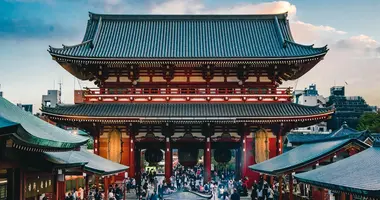
Japan In a Week Group Tours in Japan
- Duration : 9 days
- Locations : Tokyo, Hakone Mt Fuji, Kyoto
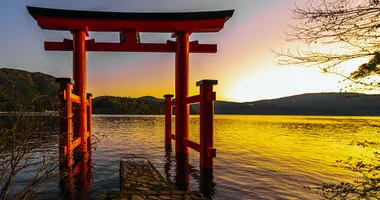
Discover Japan Group Tours in Japan
- Duration : 13 days
- Locations : Tokyo, Hakone Mt Fuji, Kyoto, Nara, Hiroshima, Miyajima
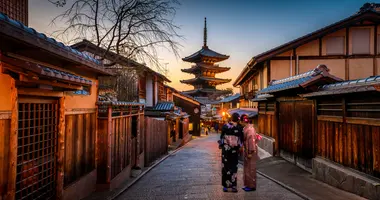
The Tokaido Road Group Tours in Japan
- Duration : 14 days
- Locations : Tokyo, Hakone Mt Fuji, Kyoto, Nara, Naoshima, Osaka
Our activities in Tokyo, Hakone, Kyoto, Nara, Naoshima, Osaka, Kobe, Takachiho, Kumamoto, Nagasaki, Miyajima
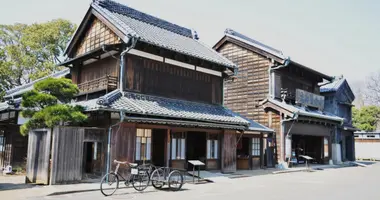
Edo-Tokyo Open Air Architectural Museum Activities in Tokyo
- Duration : 3 hours
- Location : Tokyo
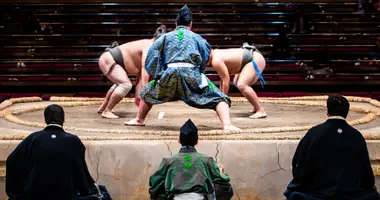
Tokyo Sumo Tournament (January, May and September) Activities in Tokyo
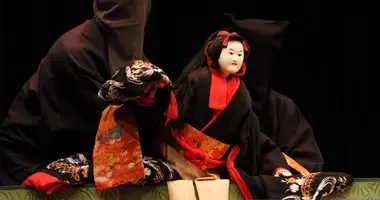
Bunraku, the traditional art of Japanese puppetry Activities in Osaka
- Duration : 2 hours
- Location : Osaka
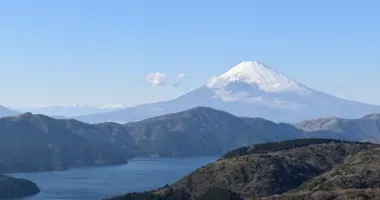
Hakone Discovery Hakone
- Duration : 8 hours
- Location : Odawara
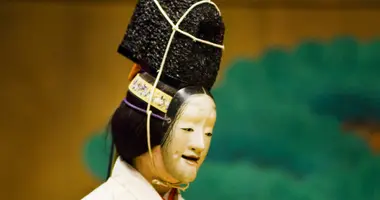
Noh, Ancient Japanese Theatre Activities in Tokyo

Tokyo Game Show Activities in Tokyo
- Duration : 5 hours
Please select your country on the list below:
- Switzerland
- United Kingdom
- Other countries

Destination
- Sao Tome & Principe
- South Africa
- New Zealand
- French Polynesia
- United Kingdom

Australasia & South Pacific
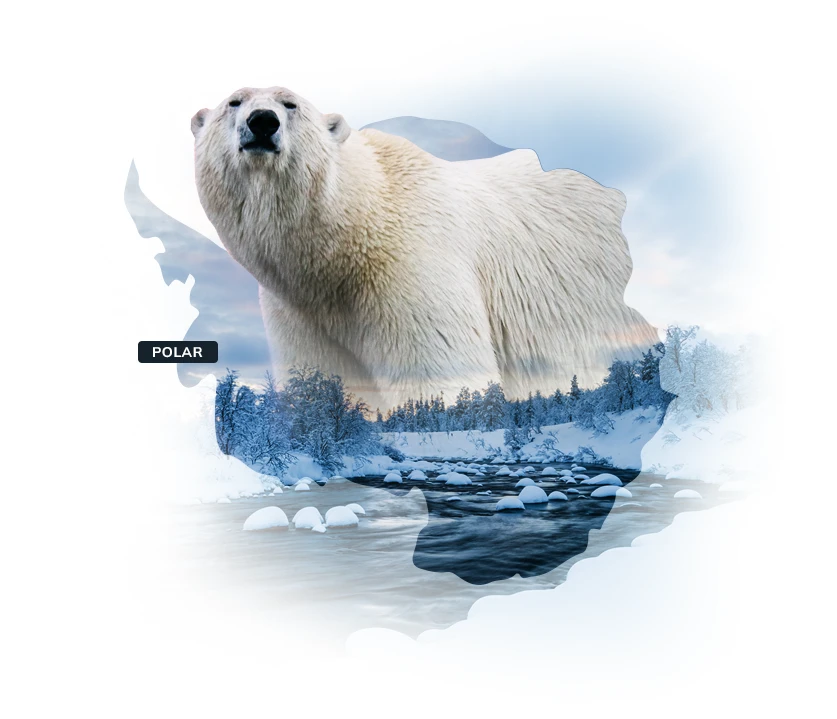
Latin America

Middle East
- Wayfairer Experience
- Responsible Travel
- Eco by Wayfairer
- Eco Gold by Wayfairer
- Luxury Holidays
- Beach Holidays
- Conservation Focused Holidays
- Family Holidays
- Safari Holidays
- Adventure Holidays
- Travel Inspiration Travel Inspiration
- Get in touch +44 117 313 3300 [email protected]
Two-Week Rural Japan Explorer
Tailor made from £8705 per person, osaka, kyoto, hiroshima, shikoku, naoshima, himeji, trip itinerary.
Please select any day below to view that destination
Day 1 – Arrival, Osaka and Kyoto
Day 2 – private tour of kyoto, day 3 – zazen meditation at gesshin-in temple, day 4 – kyoto to hiroshima, day 5 – exploring miyajima, day 6 - miyajima to matsuyama, day 7 – matsuyama to takamatsu, day 8 – day trip to naoshima island, day 9 – drive from takamatsu to iya valley, day 10 – exploring iya valley by car, day 11 – iya valley to himeji, day 12 – himeji to mount koya, day 13 – mount koya to osaka, day 14 – cycling tour of osaka, day 15 – departure from osaka kansai airport.
Start planning your perfect holiday with Wayfairer today!
An off-the-beaten-path adventure through the Japanese countryside, ideal for those seeking an authentic experience in the heart of rural Japan.
Explore rural Japan in two weeks! This curated adventure covers off-the-beaten-path gems to uncover another layer of Japan rarely seen by tourists, and experience rural life in Japan, from Kyoto's ancient charm to Hiroshima's poignant history and Miyajima's iconic Torii Gate. Discover Shikoku's hot springs, Takamatsu's gardens, and art in Naoshima. Drive through the dramatic Iya Valley, visit Himeji Castle, followed by a spiritual stay with monks on the plateau of Mount Koya, and bike through Osaka's culinary delights. Personalise your journey for an authentic Japanese experience!
What's Included:
- Meals and drinks mentioned in full itinerary
- Accommodations as stated in the itinerary
- Private airport transfers
- Professional local staff with fair salaries
- 2-Day Kansai Thru Pass and other train tickets between destinations
- 3-Day car rental for a drive around Iya Valley
- Private guided tours of Kyoto and Hiroshima
- Zazen mediation experience.
- A cycling tour of Osaka.

Days 1-3: Kyoto
Arriving at Osaka Kansai Airport, you’ll take a private vehicle transfer to the city of Kyoto. A former ancient capital and certainly the cultural capital of Japan, Kyoto is a must-see for any Japan tour and a great place to start your Japan adventure.
You’ll be staying at the Villa Sanjo Muromachi Kyoto (breakfast included), tucked away in the backstreets of one of the city’s quieter districts, just behind Karasuma Dori Street’s many bars and restaurants. The hotel features traditional details, such as handmade karakami paper local to Kyoto, artisan fabrics and furnishings, organic toiletries, as well as local tea and coffee. The property is run by a city guide publisher, so the staff are always full of useful travel tips and recommendations.

After breakfast at your hotel, a professional English-speaking guide will meet you to take you on a private tour around the city. With 17 UNESCO World Heritage sites, it can be difficult to know what to see first in Kyoto, so our friendly guide will help introduce the ancient capital, and Japanese culture, to you from a local perspective.
Today, Kyoto is a modern city, but its traditions and charm can be found just underneath the surface, with tranquil walks through the cherry blossoms, the sacred shrines nestled between office buildings and the teahouse district of Gion, where you may be lucky enough to spot a mysterious geisha.

From Kyoto, you’ll take a trip east to the foot of the Higashiyama Mountains to visit the Gesshin-in temple. This spiritual place is where you will take part in a traditional Zazen meditation.
Teramae Join, the head priest at the temple complex, will guide you through positioning, breathing and focus before you embark on a 10-minute journey through meditation. When the bell rings and time is up, you’ll also have the chance to learn more about Zen and ask any questions you may have.

Days 4-5: Hiroshima
Your two-week Japan itinerary continues to Hiroshima via the Shinkansen bullet train, offering a swift 236-mile journey in just over an hour and a half. In Hiroshima, a private guide will showcase the city's vibrant culture and business growth post-World War II. Highlights include visits to The Peace Park and Museum, the Baseball Stadium, Hiroshima Castle, The Hiroshima Prefectural Museum of Art, and Shukkei-en Gardens.
Don't miss trying the local delicacy, okonomiyaki, a customisable cabbage pancake cooked at your table. The afternoon includes a ferry ride from Hiroshima Peace Park to Miyajima Island, featuring UNESCO sites like the A-Bomb Dome and the iconic red torii of Itsukushima Shrine.

Miyajima Island is home to the UNESCO World Heritage Site of the Itsukushima Shrine, which is one of Japan’s Top Three Sights. However, this magical island is also one of the most charming rural areas of Japan to visit, with deer roaming free in the island fauna.
One must-do activity on Miyajima is a hike or cable car ride up to the peak of Mount Misen for fantastic views of the Seto Inland Sea and Hiroshima Bay. It takes two hours to climb the 500-metre summit by foot, but you’ll be rewarded with scenic vistas and possibly a monkey encounter. Another great thing to do on the island is to hire a bike from the JR ferry pier and cycle around Miyajima’s many bike paths, which wind along the coast. Pedal to Tsutsumigaura Beach: a quiet stretch of white sand that attracts windsurfers and swimmers in the summer.

Days 6-11: Shikoku & Naoshima
The next stop on your two-week Rural Japan adventure is Matsuyama, a quiet castle town located in the Ehime Prefecture, which is well-known as the home of the Dogo Onsen hot springs, the oldest in Japan. Visit Matsuyama’s impressive samurai castle for gorgeous views of the landscape, then soak in the invigorating waters of the hot springs. First mentioned in Nihon Shoki, the oldest book in Japanese classical history, a dip in the baths of the Dogo Onsen is a quintessentially Japanese experience. Look for the white heron decoration and listen for the 6.30 am drum announcing the bath’s opening.
You’ll stay one night at ANA Hotel Matsuyama (breakfast included), a four-star hotel close to Matsuyama Castle. The property features a range of restaurants, serving up cuisine from all around the world, as well as its own three-storey shopping mall.

From Matsuyama, you’ll take a direct train to Shikoku Island and the city of Takamatsu. This garden city is the largest in the Kagawa Prefecture and was once an important port, linking Shikoku to nearby Honshu. The highlight of Takamatsu is the exquisite gardens of Ritsurin Koen, considered to be one of the most beautiful landscape gardens in the whole of Japan. Other attractions include Yashima Mountain and Shikoku-Mura’s traditional houses and local architecture.
You’ll be staying at JR Hotel Clement Takamatsu (breakfast included), a 20-floor property with views of the harbour and the Seto Inland Sea on one side, and the town on the other. The hotel’s five restaurants serve Japanese, Chinese and Italian dishes, while the bakery produces delicious snacks.

The next leg of your two-week Japan itinerary takes you to Naoshima Island. This quirky oddity was once another fishing island, but now Naoshima is home to a creative art project with an impressive collection of art galleries, installations and exhibits. The works on display are scattered all over the island, ranging from sculpture to architecture to painting.
The two largest galleries, Chichu Art Museum and Benesse House are the work of renowned architect Tadao Ando, housing big names like Andy Warhol and Claude Monet. Explore this floating art space at your leisure, on foot or by rental bike, before taking the ferry back to Takamatsu. But, before you leave, we highly recommend a dip in the onsen bath at the kitschy I Love Yuu bath house in Miyanoura.

Today, you’ll pick up a rental car in Takamatsu for a three-day road trip around the incredible scenery of Iya Valley. The recommended route through the dramatic Iya Valley is the two-hour Route 32, which involves spectacular views of some of Japan’s most scenic countryside. Be aware that the road is mostly one lane with winding twists around steep cliffs, as you would expect from mountainous terrain.
You’ll stay at the Iya Onsen Hotel, which has its own natural hot-spring baths that you can reach via a scenic ride in a private cable car. Breakfast and dinner are included in your stay, with meals lovingly created using local, seasonal ingredients.
*Note that you will need to obtain an International Driving Permit (IDP) before you travel - we can help to arrange this for you. Your rental agreement includes fully comprehensive insurance, and non-operation and excess waiver fees are also covered.
Shikoku’s Iya Valley is one of the three “hidden regions” of Japan - a green expanse of river gorges and lush mountains, cut off from civilisation by near-impossible terrain. The domineering cliffs of Iya Valley, once impassable, certainly put the skyscrapers of Japan’s big cities into perspective.
You have a full day to explore Iya Valley at your leisure: vine bridges, hot springs, villages of traditional thatched-roof houses and, of course, unlimited epic mountain vistas. You can go further to the undeveloped Iya Gorge, located at the lower end of the valley. We also recommend a visit to the charming and traditional Ochiai Hamlet.

Take a leisurely drive back to Takamatsu along Route 32, with stops at the Peeing Boy statue, a cable car ride, and a dip in the Iya Onsen baths. Then, head to Okayama to explore the famous Koraku-en Gardens and Okayama Castle, with its beautiful garden views. Don't miss the rock formations, water features, and cherry trees. Next, hop on a Shinkansen to Himeji to marvel at the iconic "White Heron" Castle and stay at the Nikko Hotel Himeji, a modern hotel with a pool, gym, and great dining options.

Days 12-15: Osaka
Next, you’ll head to Mount Koya, starting with a 30-minute Shinkansen bullet train to Osaka. Once you reach the mountain’s plateau, you can use your Kansai Thru Pass to take a bus to your accommodation or take a seven-minute taxi.
Your night in Mount Koya will be a particularly memorable experience, as you’ll be staying at the Shojoshin-in temple, which was founded by the first religious settlers in this region. A shojin-ryori (vegetarian) feast of dinner and breakfast is included in your stay, featuring local tofu dishes. Your room may not have a bathroom (you’re well off the beaten path now!), but you can immerse yourself in the waters of the Shukubo’s traditional bathhouse. Dinner is served at 5 pm and breakfast at 8 am, preceded by the morning sutra reciting at 7 am.

Koya-san is a sacred mountain with a religious history dating back to 816 AD. Today, the peak is home to over 100 different monasteries and temples, as well as the headquarters of the Shingon sect, which is an esoteric school of Buddhism with millions of followers across Japan. The religious site was founded by Kukai, a monk who decided to set up a religious community here after studying away in China. The spiritual atmosphere is heightened by the enchanting natural surroundings, which include many beautiful walking routes.
After a while, you’ll head back to Osaka, and your final two nights will be spent at the Marriott Miyako Osaka (breakfast included). This hotel covers the 38th to the 57th floors of the Abeno Harukas building in the Tennoji District. The property includes several restaurants serving a range of cuisine, as well as a bar and an open-air atrium on the 58th floor, while the lower floors of the building are home to a department store and an art gallery.

Osaka is Japan’s second city, though a little more laid back than its big brother Tokyo and not as focused on tourism, which is part of what makes the city so interesting to visit. Osaka is a great representation of modern Japan.
You’ll take a three-hour cycling tour of the city with an English-speaking guide. The tour starts on the banks of Nakanoshima Island and follows the river, passing pre-war buildings that survived the firebombing of World War II, ending at the reconstructed Osaka Castle. However, Osaka shows its true colours after dark, with its creative culinary scene and vibrant nightlife. Be sure to visit the restaurant and bar district of Dotonbori, down by the canals, where you’ll be able to try local delicacies such as takoyaki (octopus dumplings).
Your Two-Week Rural Japan Tour comes to an end with a private car ride to Osaka’s Kansai Airport, only an hour away from your hotel.
We hope that by the end of your action-packed two weeks, probing deep into Japan’s countryside oases, you feel equal parts exhausted and ready to go again! Hopefully, this trip off the beaten path has shown you a side of Japan that you truly didn’t expect.

Interested in this trip?
Call us on +44 117 313 3300 to start planning your perfect vacations
Call us on +44 117 313 3300 to start planning your perfect holiday
Why Wayfairer
All Wayfairer holidays have the objective of having a positive impact on the natural environment and local communities. The local guides we work with are paid fairly, the accommodation providers we work with must be committed to responsible initiatives and our tour activities have a strong emphasis on cultural experiences. This tour of rural Japan includes mostly transfers via public transport, with the aim of cutting carbon emissions where possible. Activities are focused on the natural world and cultural experience, including cycling tours, a stay at a Koya-san monastery and destinations often overlooked by tourists.

More Japan travel inspiration from Wayfairer customers and travel specialists
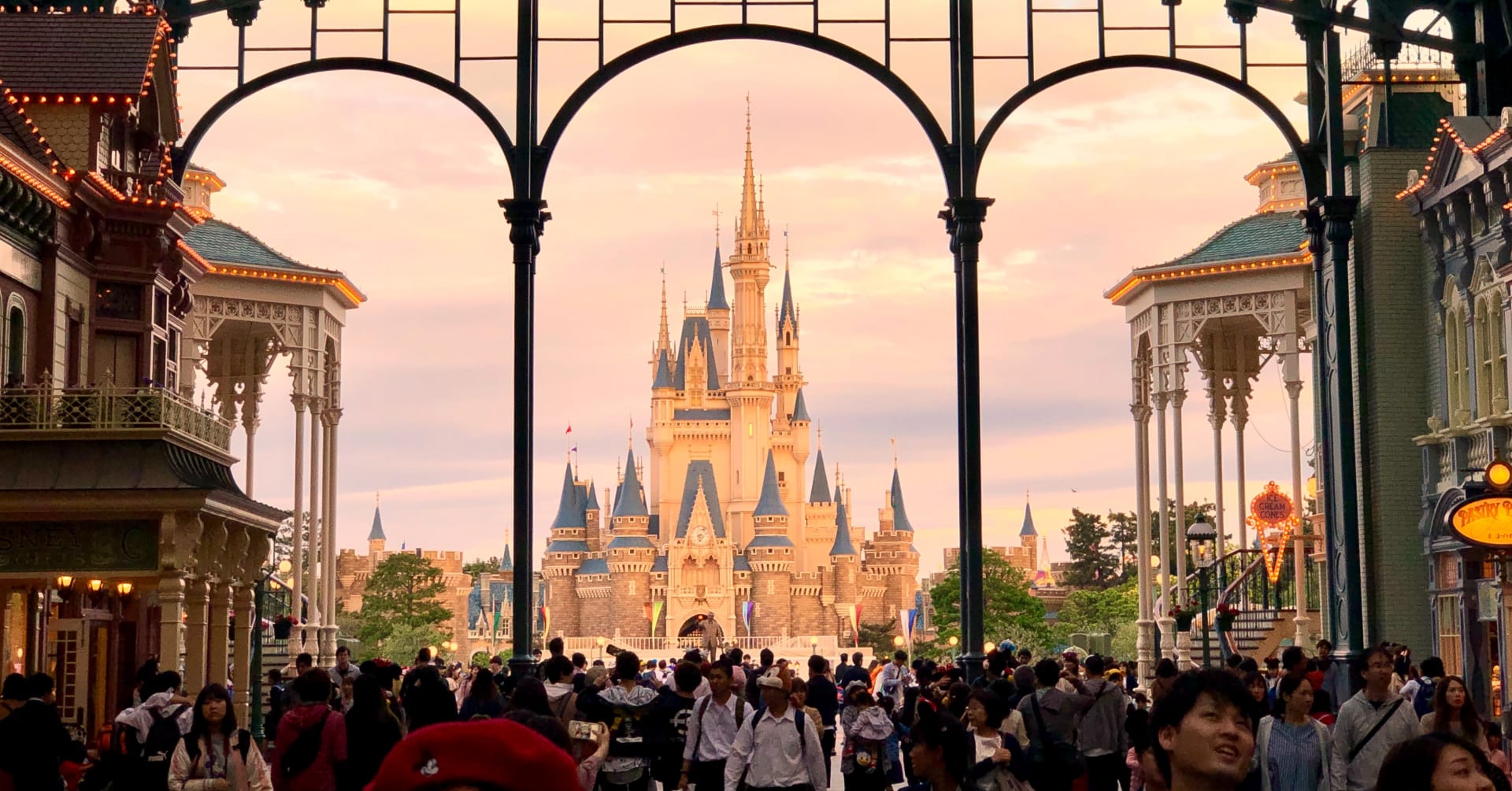
Best Places to Visit in Japan for Families
December 11, 2023
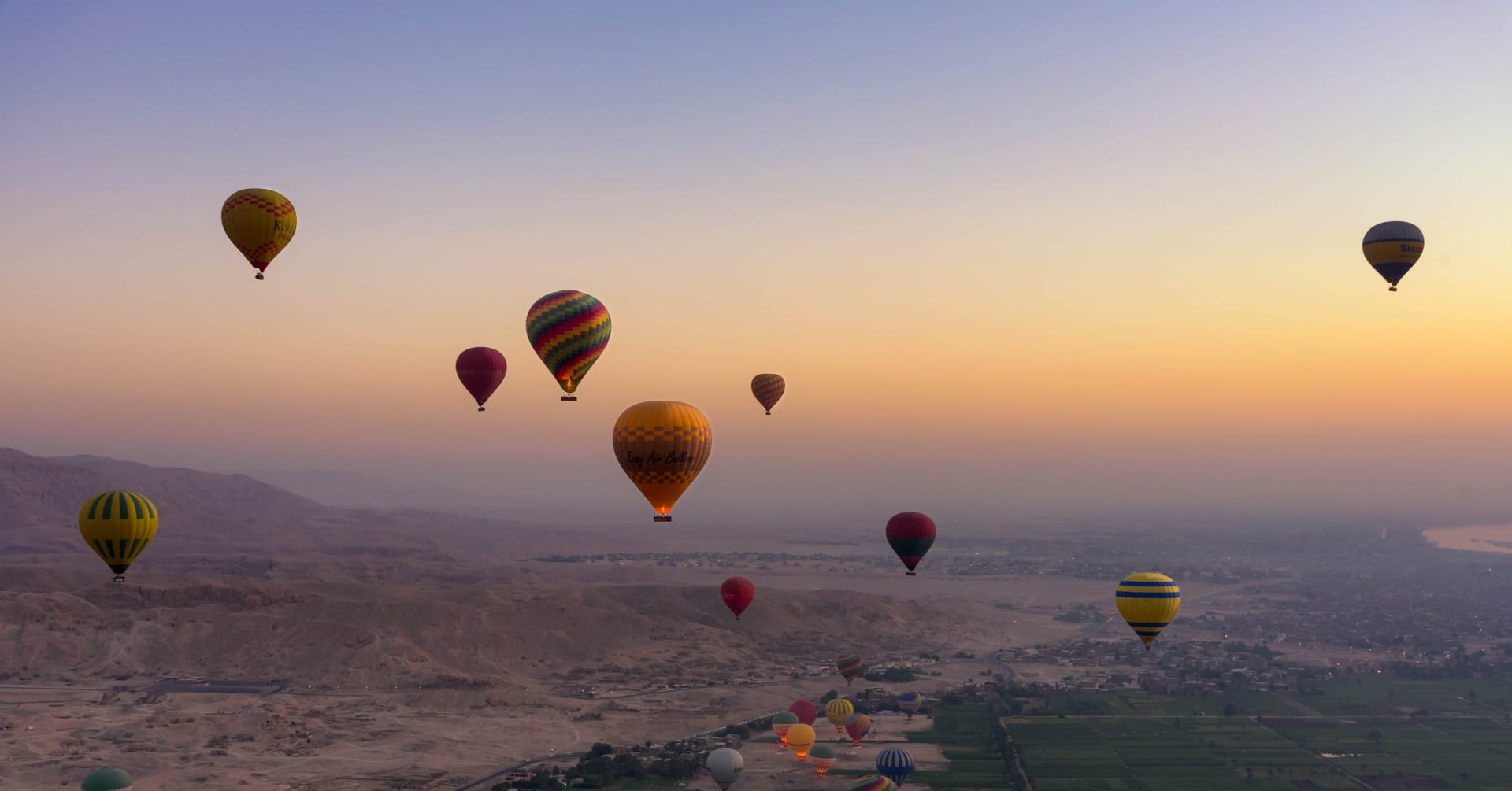
7 Best Places to Visit in November 2023
November 05, 2023
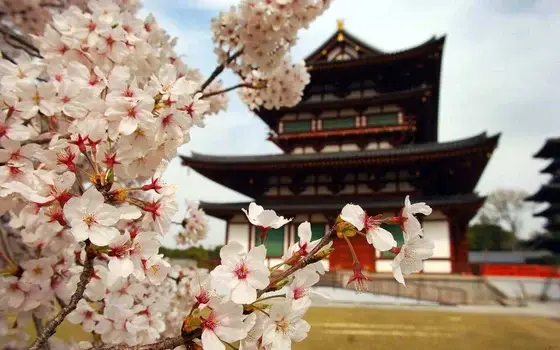
How to Enjoy Cherry Blossom Viewing in Japan
April 14, 2023
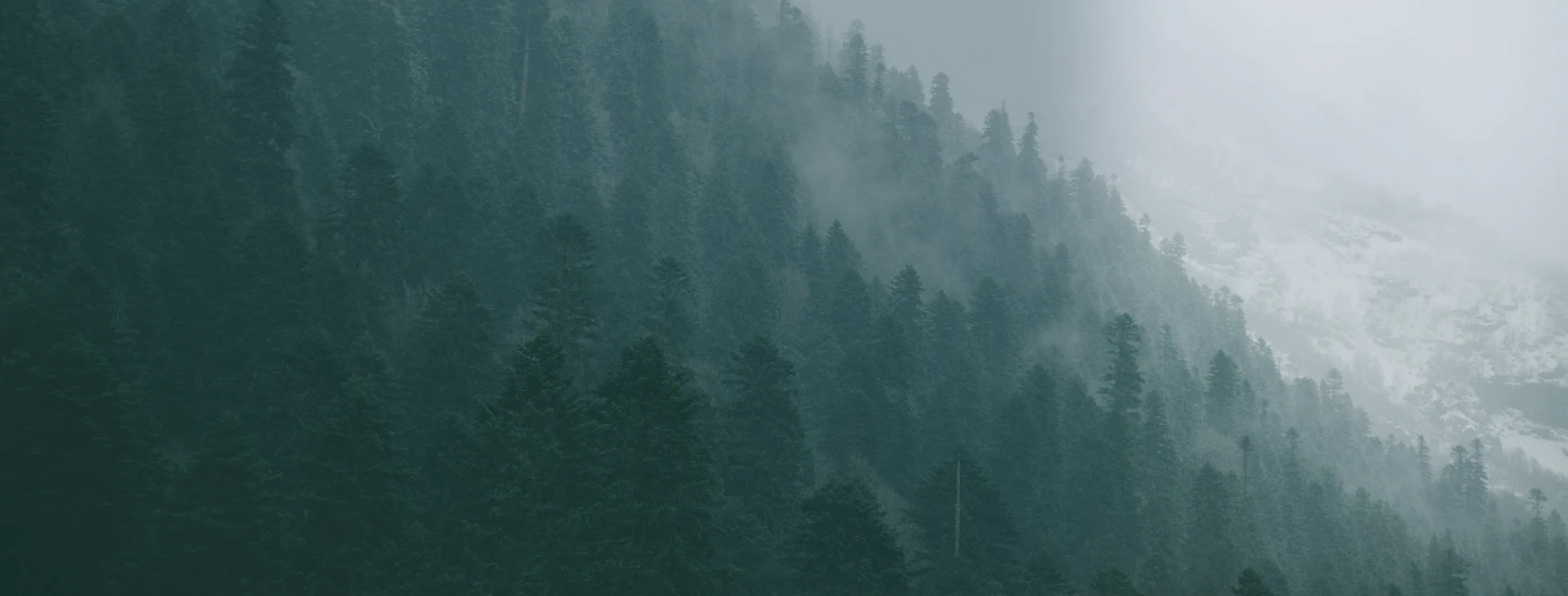
Sign up to our newsletter
For more travel inspiration delivered straight to your inbox just fill in your details here
- +61 7 3368 1966
Autumn Rural Japan Private Tour
Tour overview.
This 14-Day Autumn Rural Japan Private Tour is our ultimate off-the-beaten path itinerary. You will travel quieter parts of Japan, where the gorgeous autumn colours will accentuate your holiday. The tour takes you north of Tokyo, including UNESCO World Heritage listed Nikko and former feudal towns of Aizu-Wakamatsu as well as gorgeous Kakunodate. To enjoy the wonderful nature at this time of the year, Urabandai and Naruko Gorge should not be missed.
The rural tour also includes a luxurious traditional ryokan at Akiu Onsen. Along the way, you can take in many traditional cultures such as craft making and regional food. This itinerary is an ideal trip for those looking for something different and would love to dive into the deep end of authentic culture.
This model itinerary suggests a range of accommodation from luxury to rustic, and a lot of private guide escorts to help get the best from your remote rural adventure. These can be adjusted to suit your preference like all of our other model itineraries.
Important notes about our model itineraries:
Our model itineraries are developed to show viewers the ideas for an itinerary and price guide. The itineraries can be further customized, and the accommodation and guide time can be adjusted to suit you. The number of people in your group will affect the price, too. We will give you more firm quotation once we develop your personal itinerary.

Welcome to Japan! On arrival at one of Tokyo’s international airports, our escort will meet you and take you to your hotel in Tokyo.
This morning you will meet your guide at your hotel lobby after breakfast and have a private guided tour of Tokyo. The day's program will be completely customised for your interests and preferences. You can visit old parts of Tokyo such as Asakusa, fashionable Shibuya and Omotesando, the political and commercial centre of Japan, Marunouchi, or anything in between. The afternoon is set aside for you to explore the city at your will. Lunch and dinner are not included but we will make recommendations if you require.
Today, you leave Tokyo with your guide and take a train to the UNESCO World Heritage site of Nikko. Nikko Toshogu Shrine complex is as aesthetically magnificent as it is historically significant. You can visit the historical monuments and walk the beautiful grounds framed by autumn foliage. Tonight, we suggest you stay at a Japanese style accommodation, called ryokan and enjoy onsen bath and kaiseki dinner. Some properties have western style bedrooms, so let us know if you prefer a bed rather than sleeping on futon.
Nikko is well-known for its magnificent autumn scenery. Today, we suggest you take a bus or taxi to go even further into Oku-Nikko. It is a part of Nikko National Park, and has many impressive lakes, waterfalls and mountains. We will provide you with a list of places to see and things to enjoy today.
This morning you will take a quaint local train and travel northward to Aizu Wakamatsu. The train ride is popular amongst railway fans and it goes through spectacular gorges ablaze with autumn colours. At Aizu Wakamatsu, you meet your guide for an afternoon guided tour. Aizu Wakamatsu is a former feudal town with Tsuruga Castle, samurai residences and Japanese gardens. Tonight you have a choice of staying at a western-style hotel (basic business hotel) or a ryokan.
This morning you will continue the guided tour of Aizu Wakamatsu. Some streetscapes here are preserved for their historical value, and you can stroll the street and check out some traditional businesses such as a sake brewer. You then will take a local train from Aizu Wakamatsu to Urabandai. Your guide will travel with you to your hotel in Urabandai and assist you with the check-in. The guide will also explain the walking and cycling tracks, and help you to plan for the next day.
Awesome Urabandai is a part of Bandai Asahi National Park, and is famous for its natural beauty, especially in autumn time. Today is a day to relax amidst pristine nature of Urabandai. A walking track along the Goshikinuma (literally translates to "five coloured lakes") is highly recommended where you can immerse yourself in the brilliant colours of the lakes and forest. The water colour of the lakes differs because of the minerals contained in the water. Enjoy the magic of pristine nature for the day. Rental bicycles are available at your hotel, too.
There are literally thousands of onsen towns in Japan, but Akiu Onsen is somewhat special. With records dating back 1500 years where emperors and samurais rejuvenated in its waters, the healing power of Akiu hot springs have long been recognized as a go-to spot for rest and relaxation. Today, you will travel from Urabandai to Akiu Onsen via Sendai in Miyagi Prefecture. You will meet your guide at Sendai Station, travel with her/him in a private vehicle and have a guided tour of Akiu. One of the highlights of Akiu, apart from the onsen water, is an impressive 55 m high Akiu Otaki Waterfall. It is especially impressive against autumn foliage. Tonight you will stay at an exquisite Japanese style ryokan.
Today is yet another highlight. After an impressive Japanese style breakfast at your ryokan, you will take a local train to Yamadera. Yamadera is a favourite spot of Journey to the East as it is so authentic and rural. Originally founded in 860 AD and reconstructed in 1543, Yamadera or Risshakuji temple has been a subject of worship for many centuries. Going up to the top pagoda (1070 steps!) is a fair effort but well worth it. And we recommend you take time and go up slowly as there are so many interesting monuments and natural landscape views to be enjoyed on the way. Tonight, you will stay at the gorgeous town of Ginzan Onsen. This is an ultimate "good old onsen town" for many Japanese people.
Naruko Gorge is another sensational autumn spot. Today after breakfast, you will travel to Naruko by train. At Naruko Gorge there are some walking tracks and you can walk down to the bottom of the gorge through the Autumn colours. Naruko is also well-known for Japanese traditional kokeshi dolls. You can try painting your own kokeshi doll here. Tonight is another opportunity to try ryokan with onsen spa bath.
Kakunodate is another strong cultural town in Akita Prefecture. It is one of those places called "little Kyoto" as it possesses many traditional Japanese cultural elements. Flourishing as a castle town in the early 17th century, the samurai district homes in Kakunodate have been preserved in a marvelously unspoiled state. Stroll the streets in the old samurai quarter and see the best examples of Japanese residential architecture from the 17th and 18th centuries with your guide. Tonight you can try a regional cuisine of Akita Prefecture.
Today you can explore Kakunodate at your own pace. It is a compact town and you can walk around the town easily. How about walking around the merchant district today? Dating from 1620, Kakunodate's merchant district was separated from the samurai district, reflecting the division between the classes at the time. Stroll along the wide streets lined with historic buildings that remain largely unchanged. There are many stores selling traditional items such as miso and soy sauce. A famous craft of Kakunodate includes a timber ware made of cherry tree bark.
This is the end of your exciting Autumn Private Tour of Rural Japan and you will take the shinkansen back to Tokyo. It is like a time travel, coming from the 17th century to the modern city onboard the super high tech bullet train. You will have time to relax and unwind or do some last minute shopping in Tokyo.
Today you will transfer from your hotel to your exiting airport after breakfast. Tokyo has two international airports and we will arrange the transfer for you whichever you choose. And of course, you can extend your stay in Japan. Please browse our extension model itineraries on the Private tours page for ideas.
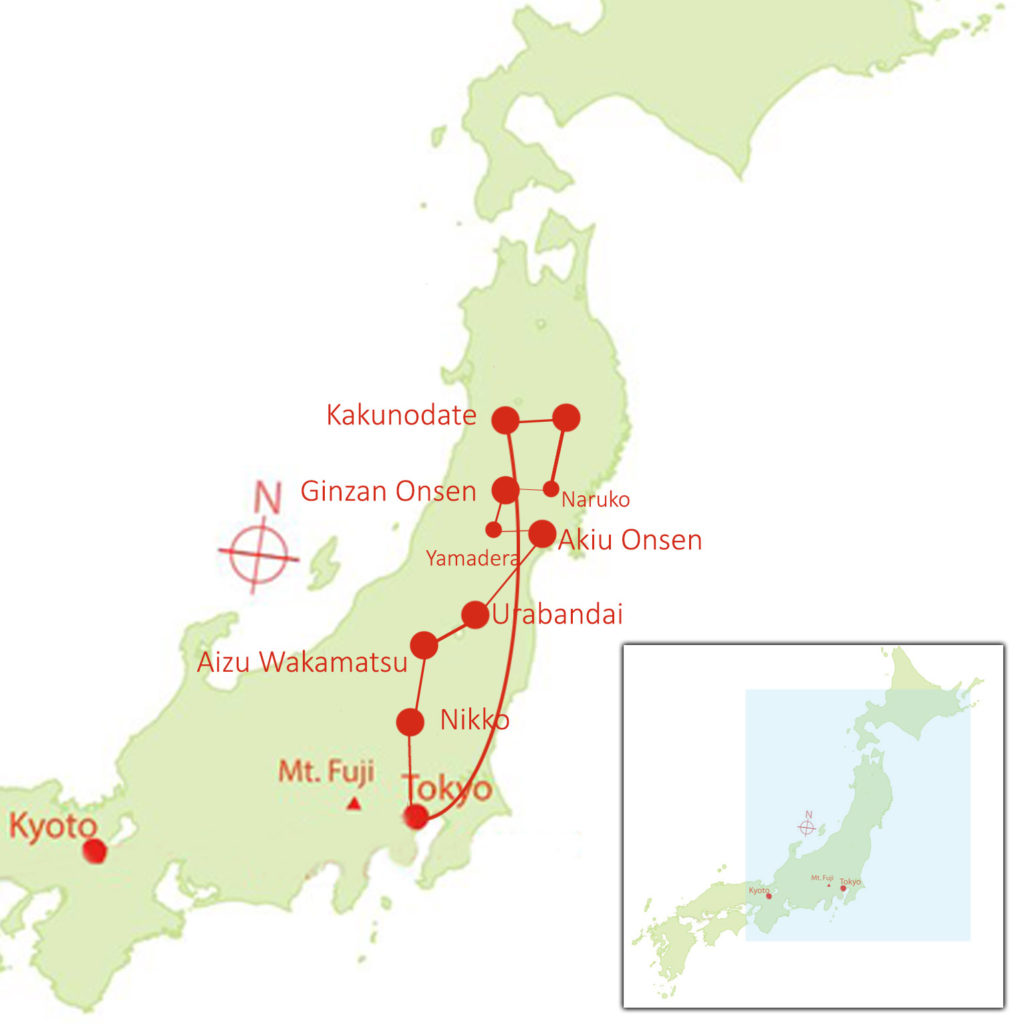
- 13 nights accommodation with daily breakfast
- Meals as specified
- Airport meet & greet and hotel transfer by public transport on arrival
- All the train transport where indicated
- Suica IC card with starter credit
- Locally licensed English speaking tour guides where specified
- International and domestic airfare (unless otherwise stated)
- Entrance fees to attractions
- Travel insurance
- Alcoholic and non-alcoholic beverages
- Tips and gratuities (not routinely expected in Japan)
- Personal expenses (laundry, internet, telephone, coin lockers etc.)
- Visa (if required)
Price Guide
Have a question about this tour get in touch with our staff directly., privacy overview.

Japan’s Countryside Wonders: 10 Must-Visit Rural Spots in Japan
Japan, with its seamless fusion of old and new , is world-renowned for its bustling metropolises like Tokyo and Osaka . These iconic cities, adorned with towering skyscrapers and glowing neon lights, represent the country’s rapid technological advancements and the relentless pace of urban life. Yet, beyond the concrete jungles , there exists another side to Japan—one that offers a completely different experience. The Japanese countryside , steeped in tradition, history, and natural beauty, is a serene escape where travelers can form a profound connection with both the land and its people.
This rural realm, shaped by ancient rituals and centuries-old architecture , moves to the natural rhythm of the seasons. For anyone looking to uncover the true essence of Japan, venturing beyond the urban centers is essential. It is here, along less-trodden paths , that the very soul of Japan reveals itself.
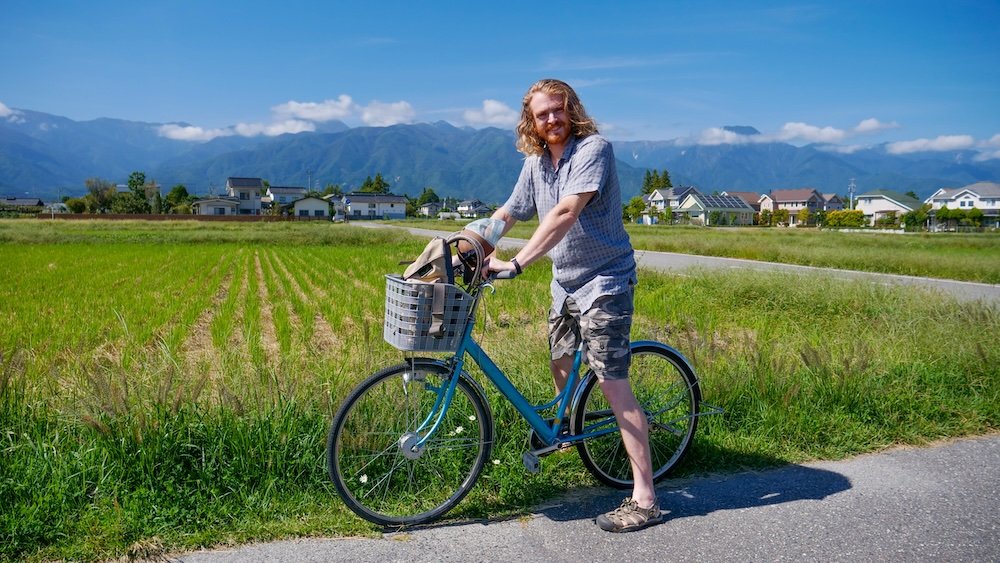
The Allure of Japan’s Rural Beauty
Away from the hustle and bustle of Japan’s cities lies a landscape defined by expansive rice fields , dotted with small villages seemingly untouched by time. The air is cleaner, the pace of life is slower, and the landscapes are refreshingly organic. Misty mountains , serene lakes , and babbling brooks paint a picture of tranquility that feels worlds away from the chaos of the city. The charm of rural Japan is further enhanced by the presence of old wooden houses , Shinto shrines , and local farmers tending to their crops—a testament to the deep connection the Japanese have with nature.
The countryside isn’t just visually stunning—it offers a multisensory experience . From the distant ringing of a temple bell to the fragrance of freshly brewed green tea , the taste of seasonal fruits plucked straight from the tree, and the tactile joy of handling handmade artisanal crafts , every sense is engaged in this journey of discovery.
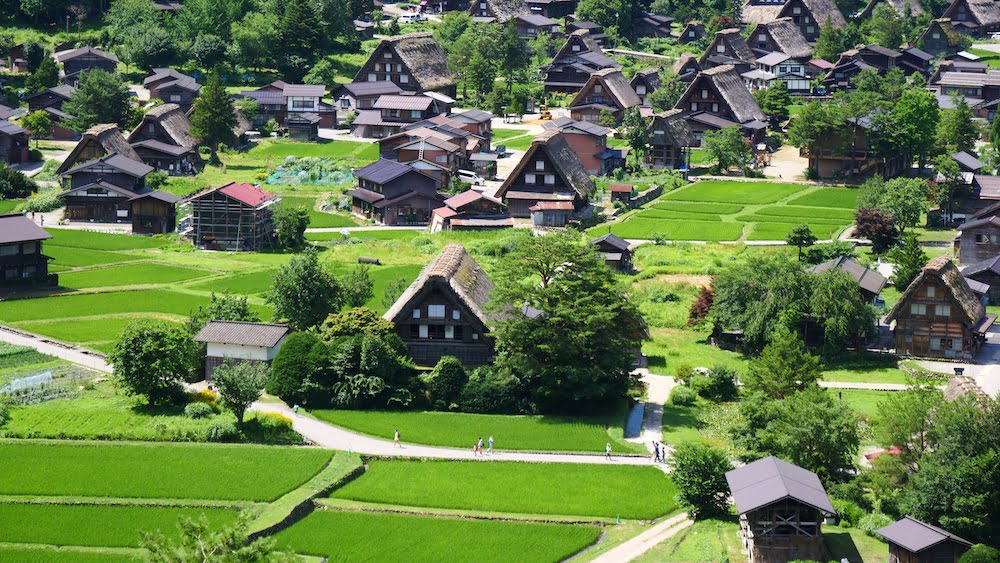
Venturing Beyond the Urban Sprawl
Visiting Japan’s rural areas is like flipping through the pages of an ancient history book . Every village, temple, and even rice field tells a story of the generations that have thrived there. These tales speak of resilience , harmony , and the uniquely Japanese philosophy of wabi-sabi —finding beauty in imperfection and the transient nature of life. By moving beyond the urban sprawl, travelers can experience authentic Japan , learning about the cultural practices, beliefs, and traditions that often get overshadowed by the bright lights of the cities .
Moreover, exploring rural Japan isn’t just an enriching experience for the traveler—it’s also a way to foster sustainable tourism . Many rural areas are experiencing a population decline as younger generations migrate to cities, leaving behind aging communities and, in some cases, abandoned villages . Tourism can play a crucial role in revitalizing these regions, bringing economic support and helping to preserve the rich cultural heritage of these rural communities for future generations.
As we unveil 10 must-visit rural spots in Japan, get ready for an adventure that promises breathtaking landscapes , soulful encounters , and memories that will last a lifetime. This journey into Japan’s countryside offers not just picturesque views, but a chance to rediscover the joy of simplicity , the beauty of nature , and the timeless wisdom embedded in Japanese culture .
The Allure of Rural Japan
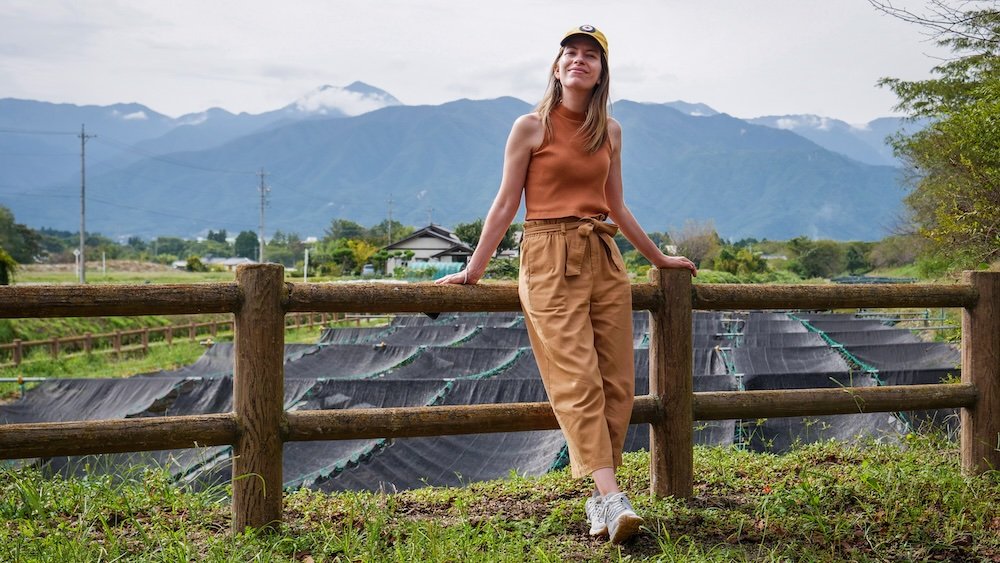
Historical Significance
A deep dive into the Japanese countryside is akin to traveling back in time. The historical significance of these regions is palpable, with every structure, every path, and every tree echoing tales from the past.
- Samurai and Feudal Villages: Rural areas like the town of Hagi in Yamaguchi Prefecture or the little village of Tsuwano in Shimane are reminiscent of old samurai towns. With well-preserved samurai residences, old streets lined with white-walled buildings, and traditional establishments, these regions offer a peek into Japan’s feudal era. The very stones of the streets seem to whisper the valorous tales of samurai who once walked on them.
- Ancient Pilgrimage Routes: The Kumano Kodo pilgrimage route in the Kii Mountain range, a UNESCO World Heritage site, traces its origins back to over a thousand years. Wandering along these sacred trails, pilgrims are reminded of the spiritual journeys of emperors and aristocrats who once sought enlightenment here.
- Historical Preservation: Towns like Shirakawa-go and Gokayama are famous for their traditional gassho-zukuri farmhouses, some of which are more than 250 years old. Recognized as UNESCO World Heritage sites, these villages encapsulate the essence of rural Japanese life from centuries ago.
Natural Beauty and Serenity
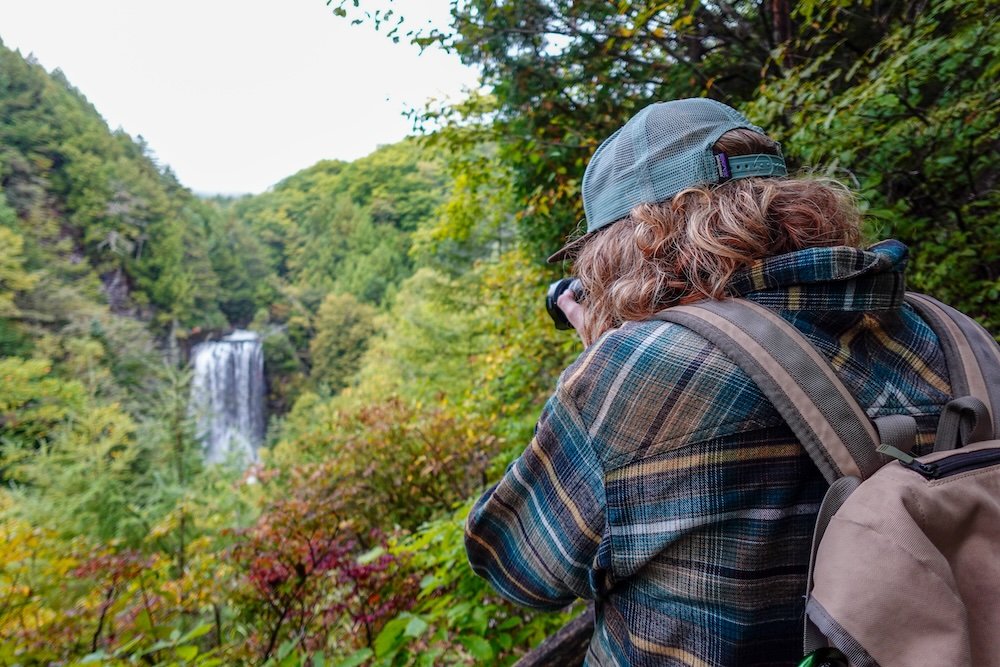
The countryside of Japan is a testament to the country’s incredible geographical diversity and its profound respect for nature.
- Diverse Landscapes: From the snow-capped mountains of Hokkaido to the lush forests of Kyushu, the natural beauty of rural Japan is both varied and mesmerizing. Places like the Japanese Alps offer breathtaking vistas, while the terraced rice fields in areas like Kyushu change with every season, reflecting nature’s ever-evolving palette.
- Seasonal Splendors: Japan is globally renowned for its cherry blossoms, but rural areas magnify this beauty manifold. Regions like Tohoku offer unparalleled views during the sakura season, while places like Nagano become a colorful tapestry during autumn.
- Quiet Retreats: The Iya Valley, often termed Japan’s “Tibet”, is one of the most remote and tranquil areas of the country. With its deep gorges, pristine rivers, and ancient vine bridges, it’s a haven for those seeking peace and tranquility.
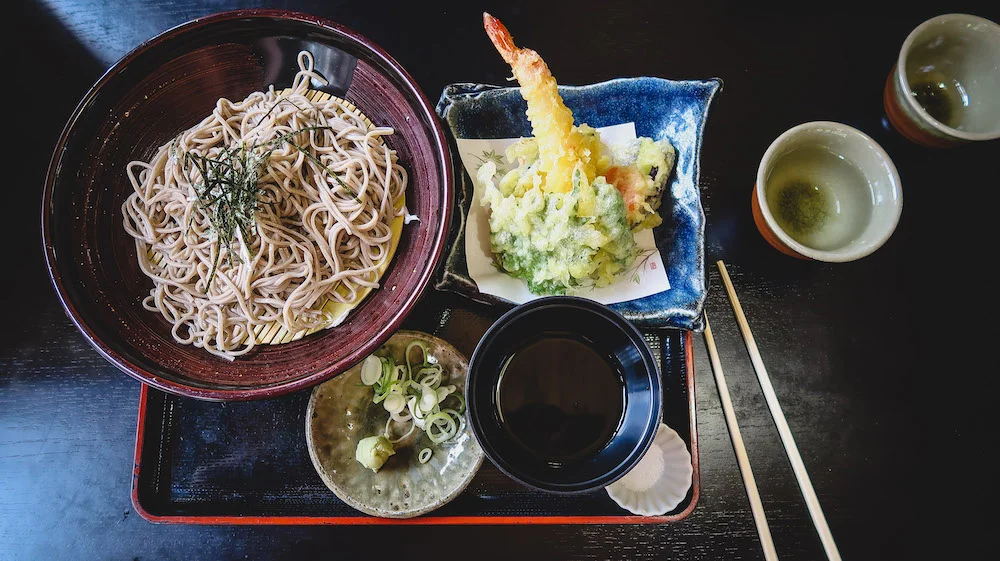
Authentic Cultural Experiences
Rural Japan is where the heart of Japanese culture beats strongest, unobstructed by the cacophony of modern life.
- Traditional Crafts: Areas like Kanazawa are rich in traditional crafts, from gold leaf artistry to intricate silk dyeing techniques. Engaging with local artisans offers a deep appreciation for Japan’s enduring craftsmanship.
- Time-Honored Festivals: Rural festivals, like the Nebuta Festival in Aomori or the Gion Matsuri in Kyoto’s outskirts, offer a vibrant display of Japan’s cultural heritage. Rooted in ancient customs, these festivals provide a profound connection to Japan’s spiritual and artistic essence.
- Culinary Delights: The Japanese countryside is a treasure trove of gastronomic experiences. Be it the fresh seafood of coastal villages or the seasonal delicacies of mountainous regions, rural Japan offers a culinary journey that tantalizes the palate while revealing age-old recipes and cooking techniques.
The allure of rural Japan lies in its deep-seated history, unmatched natural beauty, and authentic cultural immersion. It beckons travelers to step off the beaten path and discover a Japan that’s profound, timeless, and endlessly enchanting.
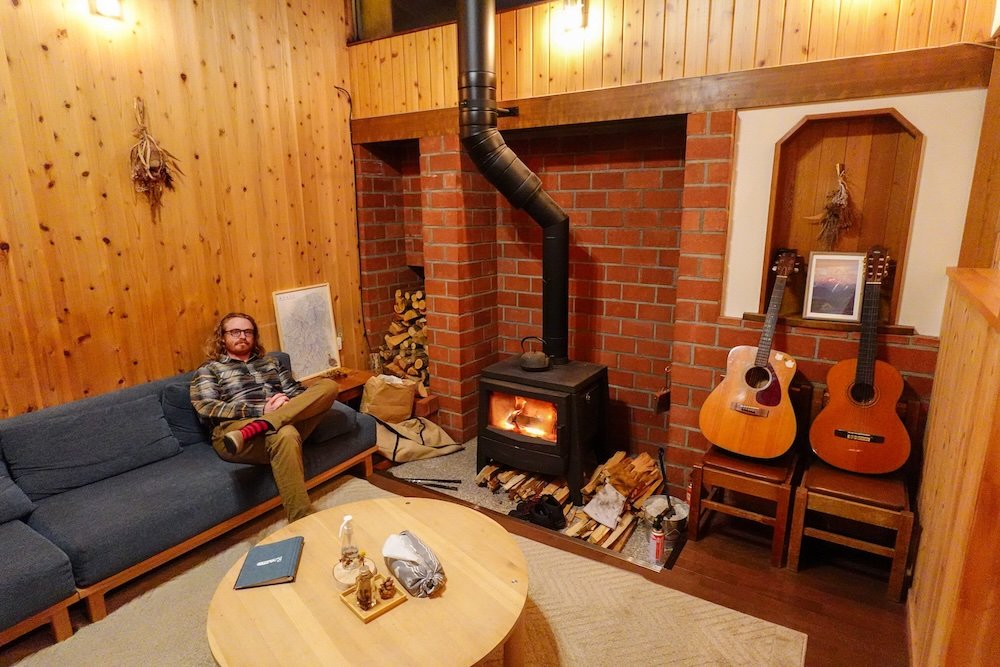
Ten Must-Visit Rural Spots In Japan For Visitors
Here is a list of the top 10 rural destinations worthy of visiting in Japan:
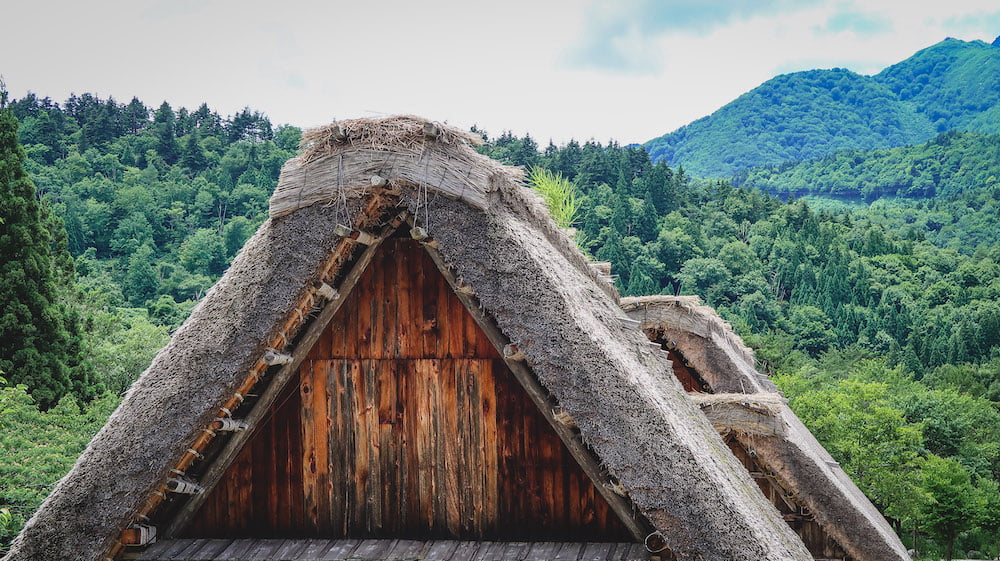
Shirakawa-go (Gifu)
Nestled in a remote valley surrounded by the rugged high mountain peaks of the Northern Japanese Alps, Shirakawa-go is a picturesque village that seems to have sprung straight from the pages of a fairy tale. Recognized as a UNESCO World Heritage site since 1995, it is celebrated for its distinctive gassho-zukuri farmhouses. This style of architecture, with its steep thatched roofs, is reminiscent of two hands brought together in prayer, which is the very essence of the word ‘gassho’.
These homes, with their steeply sloping roofs designed to withstand heavy snowfalls, are an architectural marvel and a testament to Japan’s ingenious traditional design. Their rustic charm is amplified by the intricate wooden beams, which are constructed without the use of nails. Each farmhouse stands as a symbol of the harmonious relationship the villagers of Shirakawa-go have nurtured with nature, adapting to and thriving in the harsh conditions of this secluded region.
The village’s landscape transforms with every season. The pristine white snow during winter turns these homes into magical snow domes, while spring brings forth a burst of cherry blossoms, painting the village in soft pinks. The lush greenery of summer gives way to a splendid display of autumn colors, making Shirakawa-go a year-round destination of mesmerizing beauty.
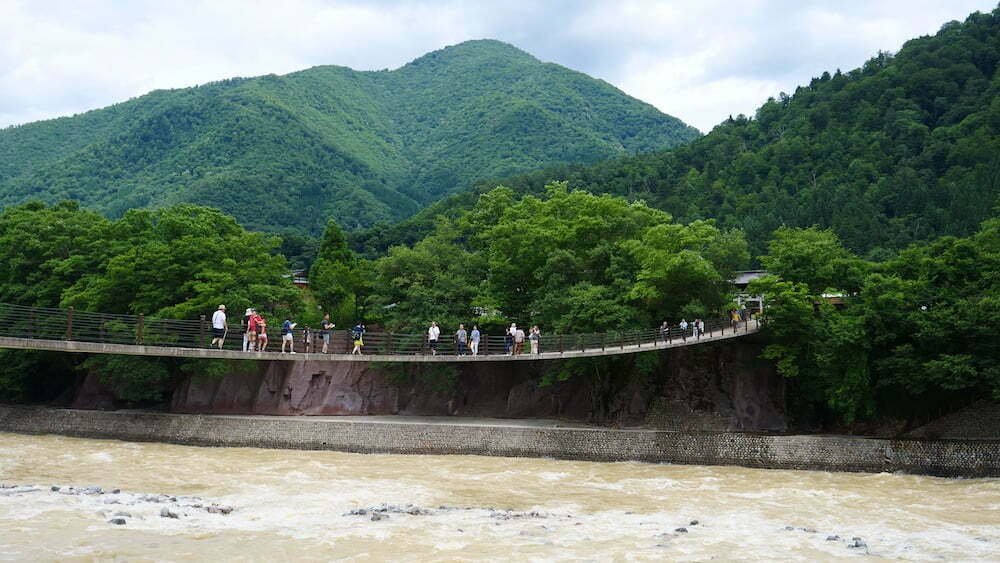
Activities:
- Seasonal Festivals: Shirakawa-go is renowned for its festivals that celebrate the unique culture and traditions of the region. One of the most iconic festivals is the Doburoku Festival , held at Shirakawa Hachiman Shrine. This festival celebrates the autumn harvest with performances, dances, and the serving of doburoku (a type of sake). Another not-to-be-missed spectacle is the Winter Light-Up event. During this time, the gassho-zukuri houses are illuminated, casting a warm, ethereal glow against the snowy backdrop, creating a dreamy, almost magical atmosphere.
- Traditional Guesthouses (Minshuku): Staying in a traditional gassho-zukuri house is an experience that transports visitors back in time. Many of these homes have been converted into minshuku, or traditional guesthouses. Here, guests can experience authentic Japanese hospitality, sleep on futons laid out on tatami mats, and savor home-cooked local dishes. Waking up in such an ambiance, especially when the village is veiled in morning mist or blanketed in snow, is truly surreal.
- Open Air Museums: The Gassho-zukuri Minkaen open-air museum offers a deep dive into the heritage of Shirakawa-go. Here, visitors can explore various relocated and preserved farmhouses, watch demonstrations of traditional crafts, and learn about the daily lives of the villagers in times gone by.
- Observation Decks: For those who wish to capture the panoramic beauty of Shirakawa-go, the Shiroyama Viewpoint is the place to be. This observation deck offers a bird’s eye view of the village, with its cluster of thatched roofs and the Shogawa River flowing gracefully in the backdrop.
In essence, Shirakawa-go is more than just a destination; it’s a journey into Japan’s rich architectural legacy, cultural traditions, and its people’s indomitable spirit. It stands as a reminder of the beauty that emerges when humans live in harmony with nature. Whether you’re a history enthusiast, a nature lover, or a traveler in search of serenity, Shirakawa-go promises memories that will be cherished for a lifetime.
Noto Peninsula (Ishikawa)
Jutting out into the Sea of Japan, the Noto Peninsula in Ishikawa Prefecture is an untouched jewel, a place where the rhythm of the waves meets the echoes of history. Characterized by its rugged coastline, serene beaches, dense forests, and picturesque rice terraces, Noto offers a landscape that is both wild and invitingly serene.
As one of the most remote and rural regions in Japan, the peninsula has managed to preserve its age-old traditions, customs, and way of life. Its isolation, both geographical and cultural, is its strength. While the majestic cliffs and roaring waves represent the wild beauty of nature , the warm-hearted locals symbolize the undying spirit of a community that has weathered storms and celebrated sunrises for generations.
What’s captivating about the Noto Peninsula is the palpable sense of history. From the ancient salt-making techniques still practiced on its shores to the rustic, thatched-roof houses dotting its landscape, Noto stands as a testament to Japan’s enduring connection to its roots.
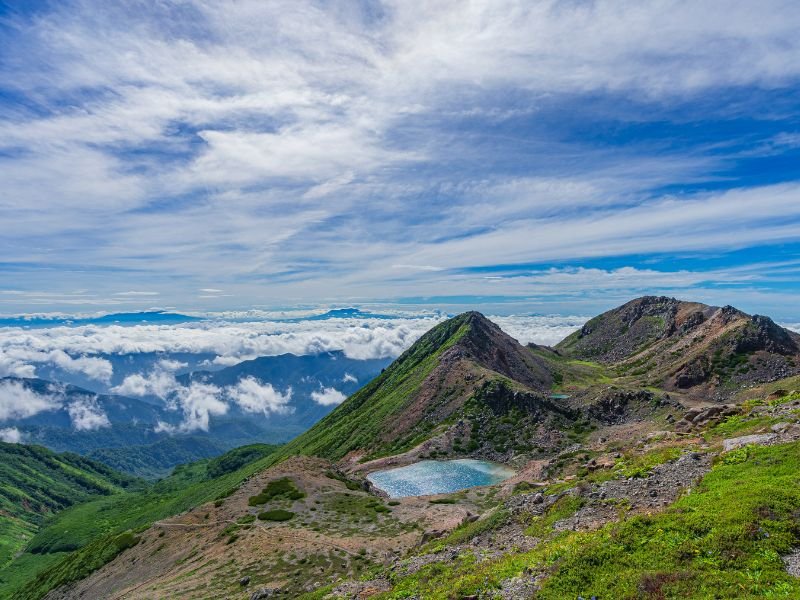
- Wajima Morning Market: As dawn breaks over the Noto Peninsula, the Wajima morning market, locally known as Wajima Asaichi , comes to life. This market has been a hub of activity for over a thousand years. Wander through its vibrant lanes, and you’ll be enveloped in a sensory experience: the fresh aroma of seafood caught just hours before, the vivid hues of locally-grown vegetables, and the inviting scent of freshly-prepared local delicacies. But beyond the produce, it’s the handcrafted lacquerware, known as Wajima-nuri , that steals the show. Meticulously crafted using age-old techniques, these pieces are a fusion of functionality and artistry, making them coveted souvenirs.
- Notojima Aquarium: Situated on Notojima Island, the Notojima Aquarium is a window into the marine world of the Sea of Japan. Home to over 40,000 marine creatures spanning 500 different species, it offers visitors a chance to marvel at the diverse aquatic life. From playful dolphins and graceful sea lions to the mesmerizing jellyfish displays, the aquarium is a celebration of marine biodiversity. Interactive programs, like the dolphin and sea lion shows, not only entertain but also educate visitors about the importance of marine conservation.
- Coastal Exploration: The rugged coastline of the Noto Peninsula is perfect for exploration. Sites like the Ganmon Rock, with its naturally carved sea cave, are a testament to the relentless power of nature. Additionally, the terraced rice fields of Shiroyone Senmaida, illuminated at night, offer a surreal landscape that juxtaposes man’s agricultural prowess with nature’s grandeur.
- Traditional Experiences: Delving into the age-old traditions of the Noto Peninsula can be a transformative experience. Witnessing the ancient salt-making methods at Agehama-style salt farms or participating in local festivals, such as the dynamic Kiriko festivals with their massive lantern floats, provide a deep connection to the region’s cultural tapestry.
In its essence, the Noto Peninsula is a sanctuary where time slows down, and the cacophony of the modern world fades away. It invites visitors to immerse themselves in its timeless beauty, indulge in its authentic experiences, and forge a bond with a land where traditions aren’t just remembered; they’re lived. Whether you’re standing on its cliffs with the sea breeze ruffling your hair or chatting with a local artisan in Wajima market, Noto ensures that its melodies linger in your heart long after you’ve left its shores.
Yakushima (Kagoshima)
Majestically rising from the azure waters of the East China Sea, south of Kyushu, lies Yakushima. A UNESCO World Heritage site since 1993, this verdant island is often referred to as the “Alps of the Ocean” due to its mountainous terrain. But beyond its topography, Yakushima’s true allure lies in its primordial cedar forests, some of which have stood tall and proud for thousands of years.
The island is cloaked in a rich tapestry of biodiversity, with the forests housing trees that have witnessed millennia, often referred to as “Yakusugi.” The most famous among them is the Jomon Sugi , a cedar tree believed to be over 7,000 years old. This ancient tree, with its gnarled bark and sprawling canopy, stands as a silent testament to the passage of time.
The island’s unique ecosystem is a result of its varied altitude, ranging from warm coastal areas to cooler mountainous regions. This gradient has endowed Yakushima with a fascinating array of flora and fauna, with subtropical and subalpine zones. As the mists roll in, they weave a gossamer blanket around the island, further enhancing its ethereal beauty and nurturing the moss-covered forests that seem straight out of a fantasy realm.
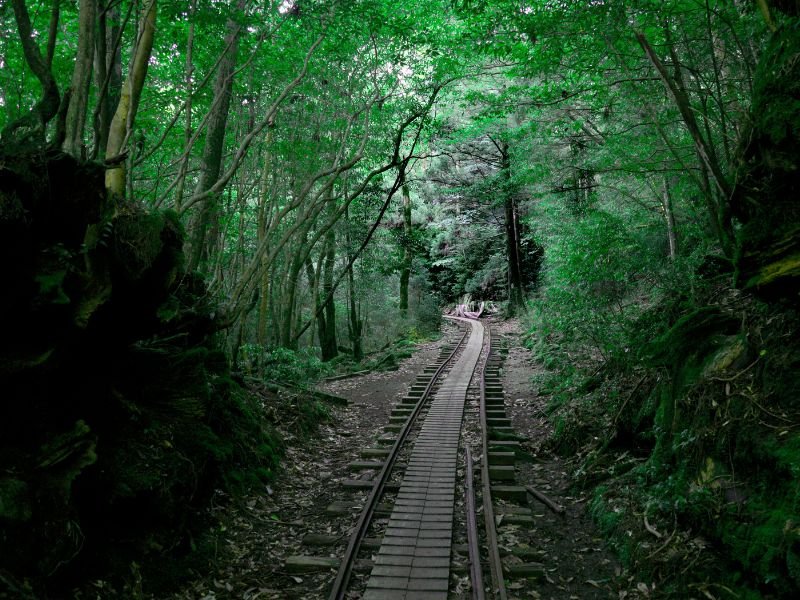
- Trekking: Yakushima is a trekker’s paradise. The trails here range from gentle walks amidst the cedar forests to challenging hikes up the island’s peaks. The path leading to the venerable Jomon Sugi is particularly popular, taking hikers through verdant landscapes and offering glimpses of the island’s ancient trees. Every step on these trails brings with it the aroma of the dense forest, the chirping of endemic birds, and the timeless aura of the ancient cedars.
- Visiting Waterfalls: The island’s abundant rainfall gives life to several stunning waterfalls. The Oko no Taki waterfall, one of the tallest and most majestic on the island, cascades gracefully, creating a misty spectacle. Another gem, the Senpiro no Taki , is framed by a vast granite backdrop, showcasing nature’s artistry at its finest. These waterfalls, with their pristine pools and surrounding greenery, offer tranquil spots for reflection and relaxation.
- Exploring the Coastline: While the forests are Yakushima’s crowning glory, its coastline is equally captivating. The coastal areas, with their unique rock formations and tide pools, provide an opportunity to witness marine life and appreciate the island’s geology. The ethereal Hirauchi Kaichu Onsen is a seaside hot spring that’s accessible only during low tide, offering bathers a therapeutic experience with panoramic ocean views.
- Wildlife Watching: The dense forests of Yakushima are home to the Yaku deer and Yaku macaque, both endemic to the island. Observing these creatures in their natural habitat, undisturbed by the urban sprawl, is a magical experience. The island’s biodiversity extends to its skies and streams, with varied bird species and creatures like the loggerhead turtle frequenting its shores.
Yakushima is where nature’s grandeur unfolds in every nook and cranny. It beckons travelers to disconnect from the outside world and form a deep connection with the earth and its ancient tales. From the whispers of the age-old cedars to the rhythmic cadence of its waterfalls, Yakushima offers a symphony of experiences that resonate with the soul and leave an indelible mark on the heart.
Nikko (Tochigi)
Situated in the mountainous heart of Tochigi Prefecture lies Nikko, an enchanting blend of rich history and breathtaking nature. For centuries, it has been a spiritual and cultural center, drawing pilgrims and travelers alike with its grandiose temples, serene landscapes, and the resonant mantra, “Never say ‘kekkou’ until you’ve seen Nikko,” meaning one should not use the word ‘beautiful’ until witnessing the beauty of this place.
Nikko’s historical significance is intertwined with its spiritual heritage. The mausoleums of the Tokugawa shoguns, surrounded by a complex of shrines, bear testimony to Japan’s feudal history, while the vast, pristine wilderness that envelopes these structures stands as a testament to nature’s eternal splendor. The juxtaposition of meticulously crafted wooden structures, adorned with intricate carvings and gold leaf, against the backdrop of towering cedar trees and the distant murmur of waterfalls encapsulates the harmonious coexistence of man and nature.
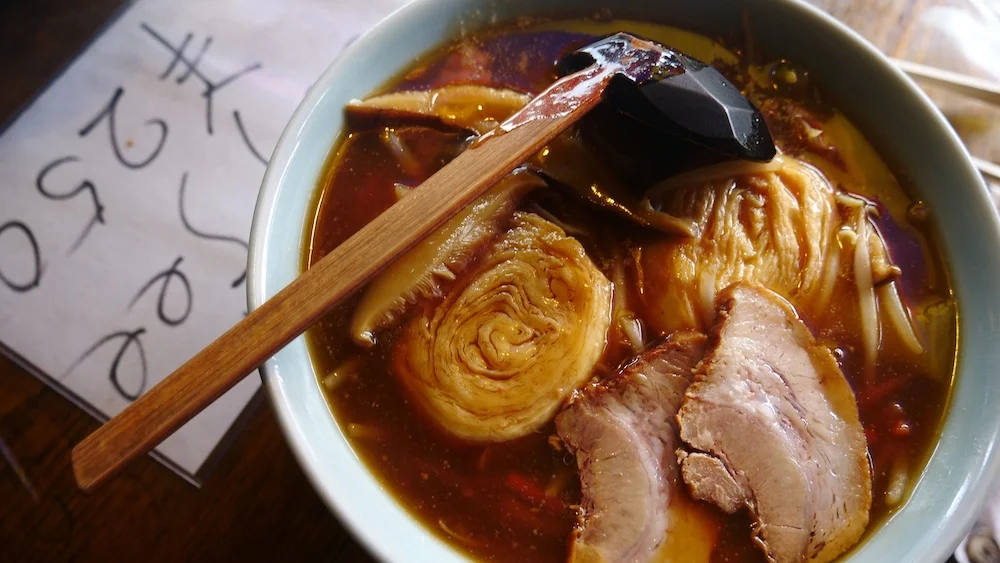
- Visiting Toshogu Shrine: At the heart of Nikko’s historical district stands the Toshogu Shrine, the final resting place of Tokugawa Ieyasu, the founder of the Tokugawa Shogunate that ruled Japan for over 250 years. The shrine complex is a masterpiece of Japanese craftsmanship and architectural prowess. With its lavishly decorated gates, like the renowned Yomeimon Gate, and intricate wood carvings, including the famous “See no evil, speak no evil, hear no evil” monkeys, Toshogu offers a journey into Japan’s rich past. Each detail, from the vibrant colors to the ornate sculptures, tells tales of power, devotion, and artistic innovation.
- Hiking around Lake Chuzenji: A short drive from the historic heart of Nikko takes you to the tranquil shores of Lake Chuzenji. Situated at the foot of Mount Nantai, this lake is a result of the mountain’s volcanic activity. Its calm, reflective waters provide a mirror to the changing seasons — cherry blossoms in spring, lush greenery in summer, vibrant autumnal hues, and a serene snow-clad landscape in winter. Hiking trails around the lake offer varying levels of difficulty, catering to both casual walkers and avid trekkers. Along the way, landmarks like the Kegon Falls, one of Japan’s highest waterfalls, add to the scenic beauty, providing picturesque spots to pause and soak in the view.
- Exploring Nikko National Park: Beyond the lake lies the expansive Nikko National Park, a haven for nature enthusiasts . Dense forests, mountainous terrains, hot springs, and an array of flora and fauna await discovery. The park’s trails lead to hidden gems, from secluded shrines to panoramic viewpoints. For those seeking tranquility, the park’s serene landscapes, punctuated by the sounds of chirping birds and rustling leaves, provide a meditative escape.
- Experiencing Onsen Culture: After a day of exploration, there’s no better way to relax than by indulging in Nikko’s onsen (hot spring) culture. The therapeutic waters, rich in minerals and sourced from the region’s volcanic activity, promise rejuvenation for both body and soul.
Nikko is a symphony of history and nature. It invites travelers to traverse the corridors of time, to stand where shoguns once stood, and to witness the timeless beauty of nature that has inspired poets and artists for generations. Whether it’s the solemnity of a centuries-old ritual at Toshogu or the first light of dawn reflecting on Lake Chuzenji, Nikko offers moments of profound beauty and reflection.

Iya Valley (Tokushima)
Hidden deep within the mountainous folds of Tokushima Prefecture on Shikoku Island, the Iya Valley is a verdant oasis of tranquility, often referred to as one of Japan’s “Three Hidden Valleys.” Its isolation has preserved not just its pristine natural beauty, but also a way of life and traditions that have remained largely untouched by the rapid modernization witnessed elsewhere.
The valley, with its steep rocky cliffs and the emerald-hued Iya River flowing below, paints a picturesque landscape. But among the many natural wonders of Iya, the most iconic are its vine bridges. These bridges, originally constructed as a means to traverse the valley, are made using woven vines and are periodically rebuilt to ensure their strength. With wooden planks spaced intermittently, they sway gently when crossed, offering both an exhilarating experience and unparalleled views of the river below.
The legend goes that these bridges were built by the Heike clan, who fled to the valley after a defeat in the 12th century. Their choice of such a secluded refuge and the creation of these bridges, which could be easily cut down in the face of an invasion, speaks volumes of the valley’s strategic significance in ancient times.
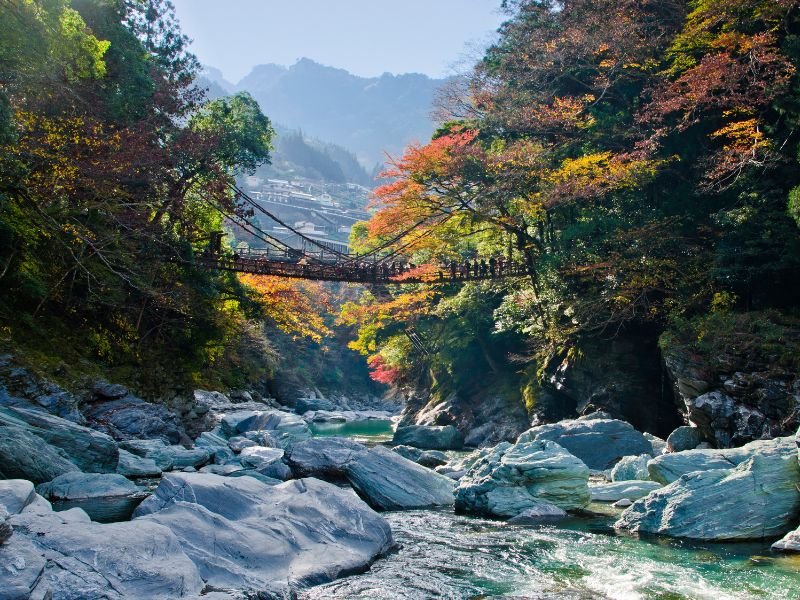
- Hot Springs: The seclusion of Iya Valley is reflected in its onsen (hot spring) culture. Tucked away amidst nature, these springs offer a therapeutic experience. The mineral-rich waters, heated by the earth’s geothermal activity, are believed to have healing properties. Bathing in these springs, with the mountainous horizon in the backdrop and the sounds of nature all around, rejuvenates both the body and spirit. The Iya Onsen , accessed via a cable car that descends down a steep mountain slope, is particularly notable for its riverside location and breathtaking views.
- Oboke Gorge Boat Rides: Further enhancing the valley’s allure is the Oboke Gorge, carved by the Iya River over millennia. The sheer rock faces, interspersed with verdant vegetation, create a mesmerizing landscape. Navigating this beauty, traditional boat rides offer a unique perspective of the gorge. As the skilled boatmen steer through the gentle rapids, they share tales and legends of the region, making the ride both scenic and informative.
- Exploring Traditional Villages: Scattered throughout the valley are quaint villages that have retained their traditional charm. A visit to these hamlets offers insights into the valley’s history and the lifestyle of its inhabitants. The Iya Kazurabashi , the most famous of the vine bridges, is located near one such village, and crossing it is akin to stepping back in time.
- Hiking and Sightseeing: For those keen on exploring the valley’s terrains, numerous hiking trails crisscross the region. These paths, ranging from gentle walks to more challenging treks, lead to vantage points offering panoramic views of the valley. The Manikin Peeing Boy statue, perched on a cliff overlooking a deep gorge, is one of the valley’s quirky attractions, symbolizing the depth and sheer drop of the valley below.
The Iya Valley is a reminder of the timeless beauty and serenity that still exists in pockets of the world. It’s a place where the mists of the past seamlessly blend with the present, where every vine bridge crossed and every mountain trail traversed tells tales of legends, of battles lost and won, and of the indomitable spirit of nature and humanity. Whether it’s the warmth of the hot springs or the gentle sway of a boat ride in the Oboke Gorge, the valley offers a retreat for the soul, a place to disconnect and find one’s bearings amidst nature’s grandeur.
Kiso Valley (Nagano)
Located in the heart of the towering Japanese Alps, Kiso Valley in Nagano Prefecture is a portal to Japan’s illustrious past. Characterized by its lush landscapes, meandering rivers, and rich history, the valley stands as a testament to an era when foot travel was the primary means of long-distance transportation. But, perhaps most emblematic of this bygone epoch are the valley’s meticulously preserved post towns, especially Tsumago and Magome, which once served travelers on the historic Nakasendo trail.
The Nakasendo, translating to “The Road Through the Mountains,” was one of the five routes connecting Tokyo and Kyoto during the Edo period. Of its 69 post towns, Tsumago and Magome are the most atmospheric and well-preserved, seemingly frozen in time. As you walk through these towns, the wooden facades, lantern-lit pathways, and stone-paved streets transport you back to a time when samurai, merchants, and travelers roamed these paths. With the prohibition of modern-day intrusions like power lines and private cars, the authenticity of the Edo-period ambiance remains undisturbed.
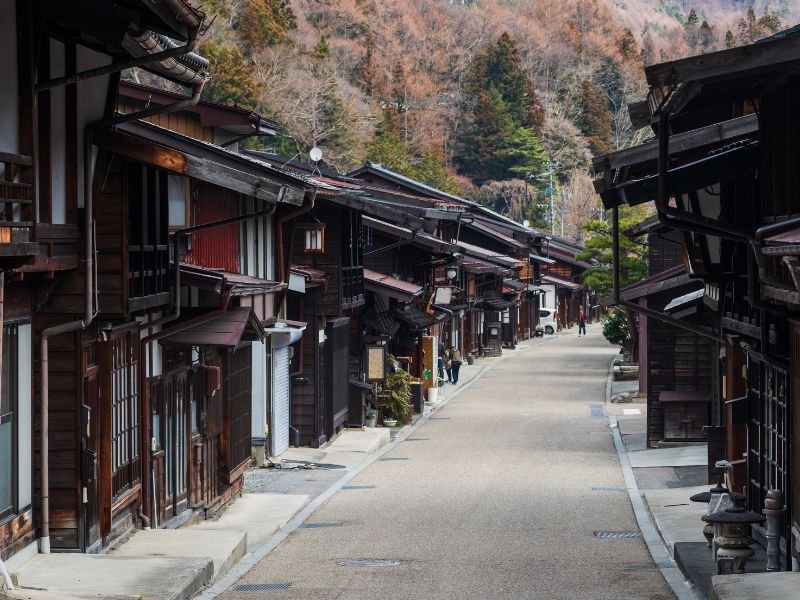
- Hiking the Nakasendo Trail: Among the most rewarding experiences in Kiso Valley is hiking the scenic stretch of the Nakasendo between Tsumago and Magome. Spanning approximately 8 kilometers, this segment of the trail offers a meditative journey through centuries-old cypress and cedar forests, cascading waterfalls, and picturesque rice terraces. Marked by centuries-old way markers and punctuated with teahouses offering respite to modern-day travelers, the trail provides both a physical journey through nature and a temporal journey through history.
- Sampling Local Cuisine: The culinary delights of Kiso Valley are as rooted in its history as the post towns themselves. As you traverse the region, indulge in traditional dishes like Gohei-mochi – skewered and grilled rice cakes glazed with a sweet and savory walnut or miso sauce. Another must-try is Kiso soba , buckwheat noodles unique to the region, often served cold with a dipping sauce or hot in a broth, a testament to the valley’s agricultural heritage.
- Visiting Historical Attractions: Beyond the main post towns, the valley is dotted with historical sites and museums. The Waki-honjin in Tsumago offers insights into the accommodations provided to high-ranking officials during their travels. With its original structure preserved, a visit here offers a glimpse into the architectural and cultural nuances of the period.
- Engaging with Traditional Crafts: Kiso Valley is renowned for its woodworking tradition, especially the crafting of lacquerware. The deep-hued, meticulously crafted pieces, often inlaid with gold or silver, are a reflection of the region’s artisanal heritage. Engaging with local craftsmen, witnessing their intricate processes, and even procuring a piece as a keepsake, makes for a memorable experience.
- Experiencing Stay in a Ryokan: To fully immerse oneself in the ethos of Kiso Valley, a stay in a traditional ryokan (inn) is imperative. With tatami-matted rooms, communal onsen baths, and traditional meals served in-room, it offers a holistic experience of Japanese hospitality and a sense of tranquility that aligns seamlessly with the valley’s ambiance.
Kiso Valley, with its preserved post towns and historical trails, offers a rare juxtaposition of nature and history. It beckons travelers not just to witness but to experience a way of life that thrived centuries ago. Each step on the Nakasendo, each bite of the region’s delicacies, and every interaction with its age-old traditions serve as a bridge between the past and the present, making a visit to this valley a poetic journey through time.
Naoshima (Kagawa)
Tucked away amidst the azure waters of the Seto Inland Sea, Naoshima is a beguiling blend of nature’s majesty and human creativity. Often dubbed the “Art Island,” Naoshima stands as a vibrant testament to the transformative power of art. What was once a tranquil fishing island with a declining population has metamorphosed into an unparalleled global art hub, thanks to the vision of a few art aficionados and the collaboration between artists, architects, and the local community.
The island’s unique identity is shaped by its intriguing juxtaposition of contemporary art installations and traditional Japanese life. As you amble through its settlements, it’s not unusual to stumble upon avant-garde sculptures seamlessly integrating with the island’s natural topography or traditional houses transformed into art spaces. This organic fusion of art, architecture, and landscape not only redefined Naoshima’s narrative but also posed a profound meditation on the relationship between nature, art, and humanity.
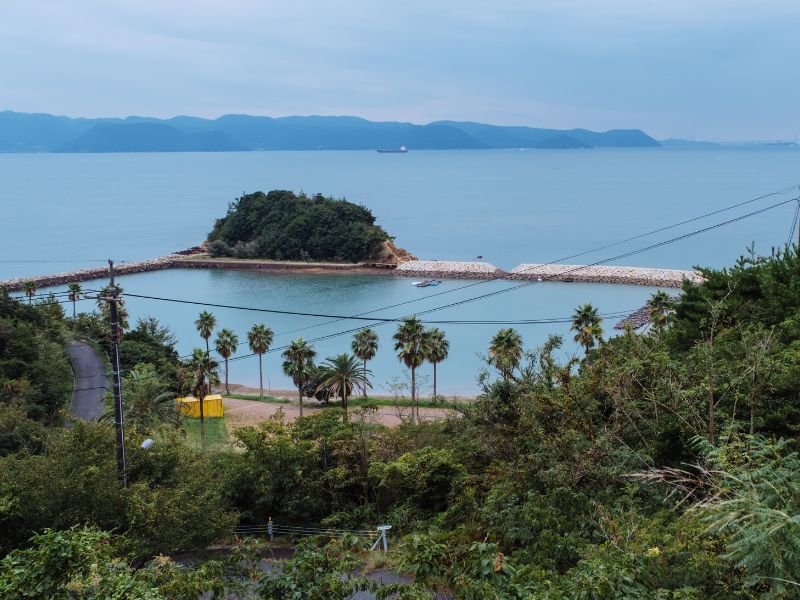
- Exploring the Chichu Art Museum: Perhaps the most iconic of Naoshima’s art destinations, the Chichu Art Museum, designed by the renowned architect Tadao Ando, is a masterclass in architectural innovation. Entirely subterranean, the museum utilizes natural light to illuminate its exhibits, ensuring that the viewing experience changes with the shifting position of the sun. The museum houses works by eminent artists such as Claude Monet, James Turrell, and Walter De Maria. Beyond the artworks, the museum itself is an artistic marvel, with its geometric forms and play of light and shadow offering a transformative experience.
- Beach Hopping: Naoshima’s beaches are a confluence of sandy shores and artistic flair. The most famous, Benesse House Beach , is punctuated with artworks that invite interaction. From the whimsical yellow pumpkin by Yayoi Kusama to the playful sculptures that pepper the landscape, each installation enhances the beach’s allure. These beaches provide both relaxation and contemplation, as the waves and art converse in silent harmony.
- Visiting the Benesse House Museum: An integration of a museum and a hotel, the Benesse House Museum showcases a diverse collection of contemporary art from both Japanese and international artists. Each piece is thoughtfully placed, ensuring that the art, architecture, and surrounding environment resonate with each other. Staying at the Benesse House allows visitors to immerse themselves fully in the art experience, with artworks extending from the museum into the rooms and surrounding areas.
- Exploring Art Houses and Installations: The Art House Project transformed abandoned houses and workshops into art installations. Scattered across the island, these spaces blur the boundaries between everyday life and art. Each house offers a unique encounter, be it the serene ambiance of Minamidera, which houses a James Turrell light installation, or the reflective waters of the Go’o Shrine.
- Riding the Art Buses: Naoshima’s local buses, adorned with colorful polka dots, reflect the island’s artistic ethos. Beyond their functional role of transporting visitors between key destinations, they add a touch of whimsy to the island’s landscape.
- Sampling Local Delicacies: While art is the soul of Naoshima, its culinary offerings provide a flavorful counterpart. The local cafes and eateries, some housed in artfully designed spaces, offer delicacies like fresh seafood from the Seto Inland Sea, ensuring that the island’s artistic journey also satiates the palate.
Naoshima challenges the traditional paradigms of where and how art should be displayed. It invites visitors to not just observe art but to live it — to feel the sun as it plays on a Monet, to hear the waves as they serenade a sculpture, and to contemplate art’s space in our lives and landscapes. It’s an island where every sunset paints a canvas and where the line between man-made and natural beauty is delightfully blurred.
Aso (Kumamoto)
Located in the heart of Kyushu, Aso in Kumamoto Prefecture is a testament to nature’s raw and magnificent power. Dominating the landscape is Mount Aso, one of the world’s most active volcanoes, which has shaped the region’s geography, history, and culture over countless millennia. The vast caldera, spanning approximately 120 kilometers in circumference, is one of the largest in the world, and within its expansive embrace lie thriving towns, fertile plains, and the resplendent Aso-san, the central volcanic complex.
Aso’s landscape is a testament to both the destructive and nurturing powers of volcanism. While eruptions have carved its rugged terrains and left ash-laden layers, they have also blessed the region with mineral-rich soils, making it an agricultural haven. The juxtaposition of verdant pastures, undulating hills, and the ever-smoldering crater offers a dramatic landscape that captivates both the eye and the soul.
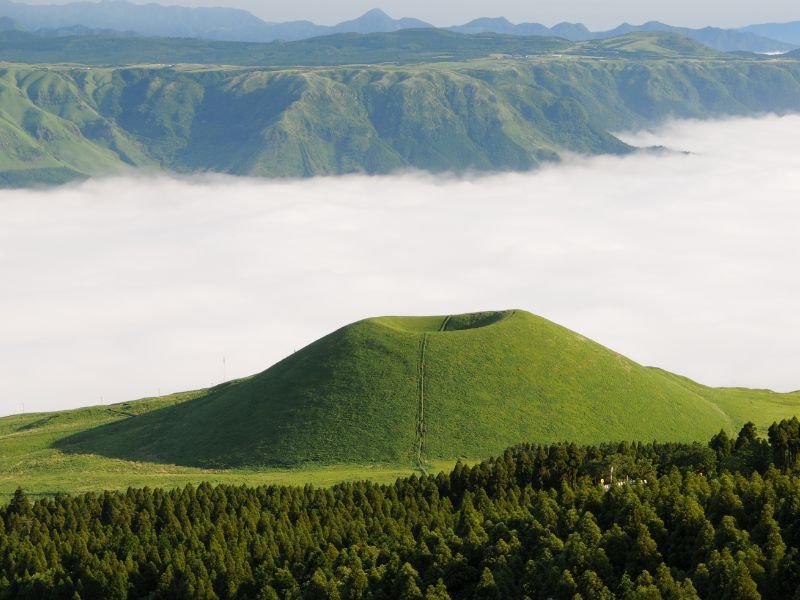
- Hiking: Aso offers myriad hiking opportunities that cater to both novice walkers and seasoned trekkers. The trails around the outer rim of the caldera offer panoramic views of the expansive interior, while those venturing closer to the central crater are rewarded with views of fuming vents and the cerulean-blue Komezuka, a beautifully symmetrical volcanic cone. Each path provides unique vantage points of Aso’s multifaceted beauty, from its lush grasslands to its smoky summits.
- Visiting Aso Volcano Museum: Delving deep into the geology, history, and cultural significance of Mount Aso, the Aso Volcano Museum offers a comprehensive understanding of the region’s volcanic activity. Interactive exhibits detail the formation of the caldera, the different types of eruptions, and the flora and fauna nurtured by this unique ecosystem. A visit here not only educates but also offers context to the landscape visitors witness, making it an essential stop for those keen on understanding the intricacies of this geothermal marvel.
- Exploring the Aso Shrine: A symbol of the region’s spiritual heritage, the Aso Shrine is believed to be over 2,500 years old and pays homage to the deity of Aso-san. Though the original structures were damaged in earthquakes, the restored shrine continues to be a beacon of the region’s cultural and spiritual identity. Festivals, rituals, and ceremonies here often intertwine with the volcanic landscape, reflecting the deep reverence and respect the locals have for the mountain’s power.
- Horse Riding: The grassy plains of the caldera, known locally as Kusasenri, offer a unique equestrian experience. Riding amidst this vast green expanse, with the looming presence of the volcanic peaks in the backdrop, is both tranquil and invigorating. The gentle trot of the horses complements the serene ambiance, making it a favorite activity for those looking to experience Aso’s beauty at a leisurely pace.
- Sampling Local Cuisine: The mineral-rich soils of Aso, nurtured by centuries of volcanic activity, yield crops of exceptional quality. Delight in local specialties like Akaushi (Aso beef), celebrated for its tenderness and flavor, or savor the freshness of locally grown vegetables in a traditional hot pot. The region’s culinary offerings are a reflection of its fertile landscapes, ensuring that every meal is a flavorful journey through its terrains.
Aso is a celebration of nature in its most primal form. It’s a place where the earth rumbles, where steam hisses from crevices, and where life thrives in the shadow of a smoldering giant. It’s a reminder of our planet’s dynamic core, of the forces that shape our world, and of the delicate balance between destruction and creation. Whether you’re gazing into the depths of a crater or savoring the bounty of the land, Aso offers an encounter with nature that’s both humbling and exhilarating.
Kamakura (Kanagawa)
Nestled between the sparkling waters of Sagami Bay and the verdant hills of Kanagawa, Kamakura is a delightful blend of history, spirituality, and natural beauty. Once the de facto capital of Japan during the Kamakura Shogunate, this coastal city has retained its historical charm and continues to beckon visitors with its array of venerable temples, storied shrines, and serene landscapes. The city’s timeline, spanning centuries, is palpably felt in its cobbled streets, ancient structures, and the tales whispered by the towering trees that have stood sentinel through ages.
A significant chapter of Japan’s feudal history was written here, and its legacy manifests in the myriad architectural wonders and cultural landmarks. But beyond its illustrious past, Kamakura is also a tale of timeless beauty – of cherry blossoms painting landscapes, of the majestic Buddha casting his benevolent gaze, and of the waves serenading its sandy shores.
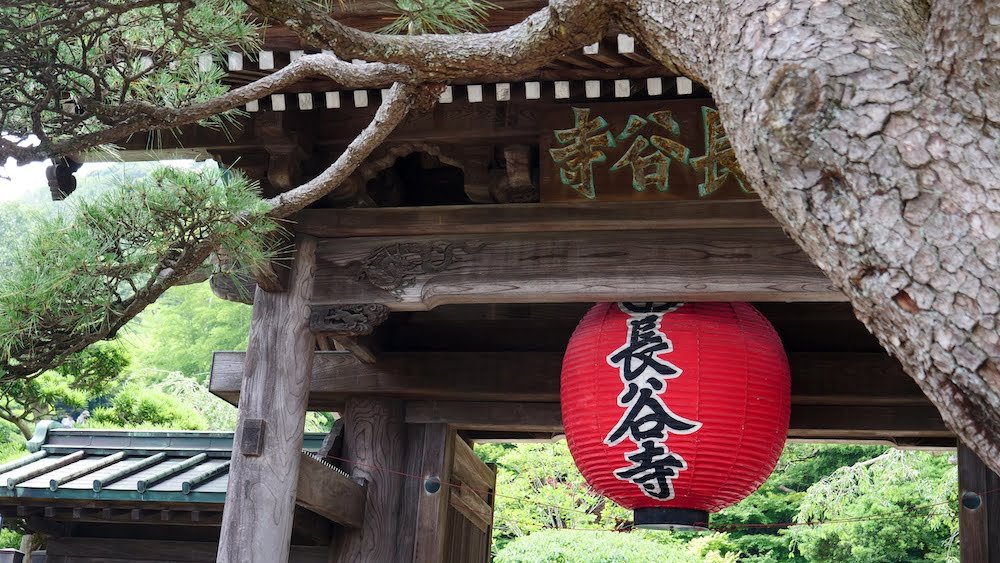
- Visiting the Kotoku-in Temple: Home to the iconic Great Buddha (Daibutsu), the Kotoku-in Temple is a must-visit pilgrimage for any traveler in Kamakura. This colossal bronze statue, standing over 11 meters tall, is not only a marvel of ancient craftsmanship but also an embodiment of serenity and introspection. Cast in the 13th century, the Daibutsu braved earthquakes and tsunamis, its tranquil expression unaltered by the tests of time. Visitors can even venture inside the statue, witnessing the intricate interior framework that supports this massive icon.
- Beach Strolls: Kamakura’s coastline is a delightful tapestry of sandy beaches and azure waters. Yuigahama and Zaimokuza Beaches are popular retreats, especially in the summer months. Strolling along the shoreline, with the rhythmic cadence of waves accompanying one’s thoughts, is a therapeutic experience. As the sun sets, these beaches morph into vibrant hubs, with cafes, food stalls, and surfers savoring the ocean’s embrace.
- Hiking in Kamakura’s Hills: The city’s hills, carpeted in dense forests and crisscrossed by ancient trails, are a hiker’s paradise. One of the most popular trails is the Daibutsu Hiking Course, connecting the Kotoku-in Temple to the Kuzuharaoka Shrine. Along the way, travelers are treated to panoramic views, secluded temples, and the serene ambiance of nature. The trail, echoing with birdsong and the whispers of ancient trees, is a journey through both nature and history.
- Exploring Other Temples and Shrines: Kamakura boasts a plethora of spiritual sanctuaries. The Tsurugaoka Hachimangu Shrine, with its vibrant torii gates and serene lotus ponds, stands as a testament to the city’s Shinto heritage. Engaku-ji and Kencho-ji, Zen Buddhist temples, invite contemplation with their pristine gardens, koi-filled ponds, and age-old structures.
- Savoring Local Delicacies: Kamakura’s culinary landscape is as diverse as its history. From traditional Japanese sweets like Hato Sable (dove-shaped cookies) to fresh seafood caught from Sagami Bay, the city offers a gastronomic journey that tantalizes the palate. Street food stalls, especially around Komachi Street, serve everything from squid ink ice cream to savory rice crackers.
- Bamboo Grove at Hokokuji Temple: A lesser-known gem, the Hokokuji Temple, is often referred to as the ‘Bamboo Temple’. Beyond its main hall lies a mesmerizing bamboo grove, where slender bamboo stalks soar towards the sky, creating a canopy of green. A walk here, with the sun filtering through the bamboo and the soft rustling of leaves, is a meditative experience, further enhanced by a cup of traditional matcha tea served within the temple premises.
Kamakura, with its juxtaposition of the ancient and the timeless, offers a respite from the frenetic pace of urban life. It’s a place where the past dialogues with the present, where nature intertwines with history, and where every corner, be it a temple alcove or a beachside cafe, narrates tales of bygone eras and eternal beauty.
Takayama (Gifu)
Takayama, often referred to as “Little Kyoto” due to its beautifully preserved historical streets, is a delightful town situated in the mountainous Hida region of Gifu Prefecture. Its charm is encapsulated in its old town, where narrow lanes, lined with Edo-period (1603-1868) wooden merchants’ houses, craft shops, and sake breweries, transport visitors back to a bygone era. The town’s location, ensconced amid the Japanese Alps, provides a picturesque backdrop, further accentuating its historical allure. The fusion of natural beauty with cultural richness makes Takayama an embodiment of the quintessential Japanese experience, seamlessly blending the past’s rustic elegance with nature’s serenity.
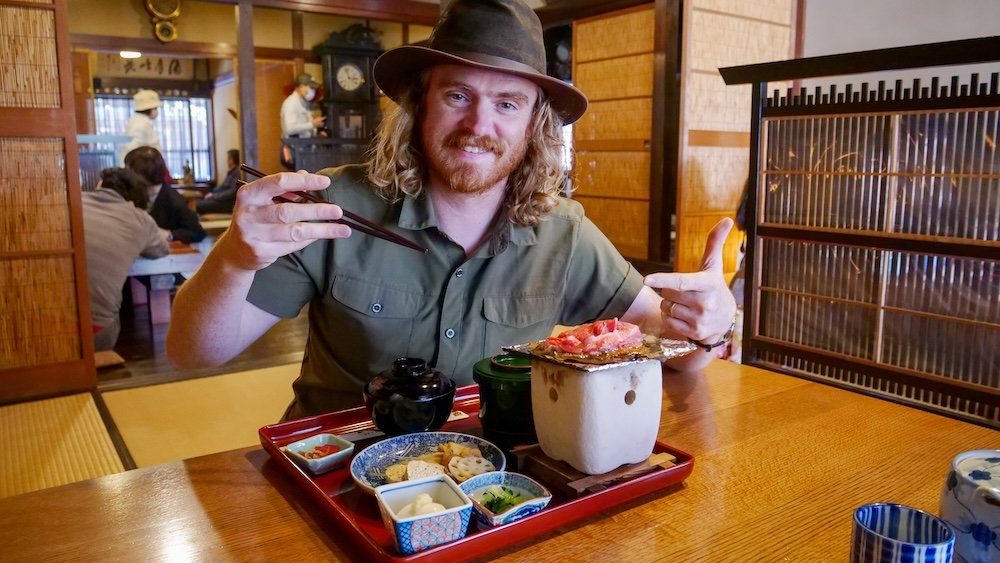
The air here carries the gentle scent of cedar, while the soundscape is a serene melody of rustling leaves, distant temple bells, and the soft murmurings of the Miyagawa River that flows gently through the town. Takayama, with its slower pace and rich tapestry of traditions, offers an escape from modern urbanity, reminding visitors of the nuanced beauty of simplicity and heritage.
- Exploring Sanmachi Street: The heart of Takayama’s historic district, Sanmachi Street, is a living museum of the Edo period. This well-preserved area consists of three narrow lanes filled with wooden buildings, sake breweries, boutiques, and cafes. Each structure, with its lattice-fronted facades and carved wooden accents, narrates tales of the town’s merchant history. As visitors meander through the lanes, they can sample local specialties, from Hida beef skewers to sake tastings offered by age-old breweries. Each step taken on the stone-paved paths is a step back in time, making Sanmachi Street an immersive historical journey.
- Visiting Morning Markets: Takayama’s morning markets, particularly the Jinya-mae and Miyagawa markets, are a vibrant testament to the region’s agricultural bounty. Local farmers and artisans gather every morning, offering a myriad of fresh produce, homemade pickles, crafts, and delightful snacks. The markets, with their lively ambiance and colorful displays, offer a delightful sensory experience, allowing visitors to engage with the local community and savor the region’s flavors.
- Hida Folk Village: A short distance from the town center lies the Hida Folk Village (Hida no Sato), an open-air museum showcasing traditional mountain farming life. Over 30 authentic gassho-zukuri (thatched-roof) farmhouses, salvaged and relocated from remote areas, dot the landscape. Each structure, with its steeply pitched roofs designed to withstand heavy snowfalls, offers insights into regional architecture and rural life. Demonstrations of traditional crafts, such as weaving and lacquer work, further enrich the experience, allowing visitors to engage with Japan’s age-old artistry.
- Savoring Hida Beef: Takayama is renowned for its Hida beef, a marbled delicacy that rivals Kobe beef in flavor and tenderness. Many local restaurants offer dishes showcasing this regional specialty, from succulent steaks to melt-in-the-mouth sushi. Dining in Takayama often becomes a culinary journey, where each bite resonates with the rich flavors of the Hida region.
- Exploring Temples and Shrines: Beyond its historic streets, Takayama is home to numerous temples and shrines, each radiating spiritual tranquillity. The Takayama Jinya, once a government house, now stands as a museum detailing the town’s administrative history. The nearby Shiroyama Park, apart from offering panoramic views of the town, is dotted with several temples and shrines, providing a tranquil setting for contemplation.
- Attending Takayama Festivals: If timed right, visitors can witness Takayama’s renowned festivals, held in spring and autumn. These festivals, with their ornate floats, puppet performances, and processions, are a vibrant display of the town’s cultural heritage, drawing visitors from across the globe.
Takayama, with its juxtaposition of the historical and the natural, is more than just a destination—it’s an experience. Whether one is strolling along Sanmachi, sipping sake beneath wooden eaves, or marveling at the architectural splendor of gassho-zukuri houses, the town weaves a spell, encapsulating the soul of Japan in its cobbled paths and timbered facades.
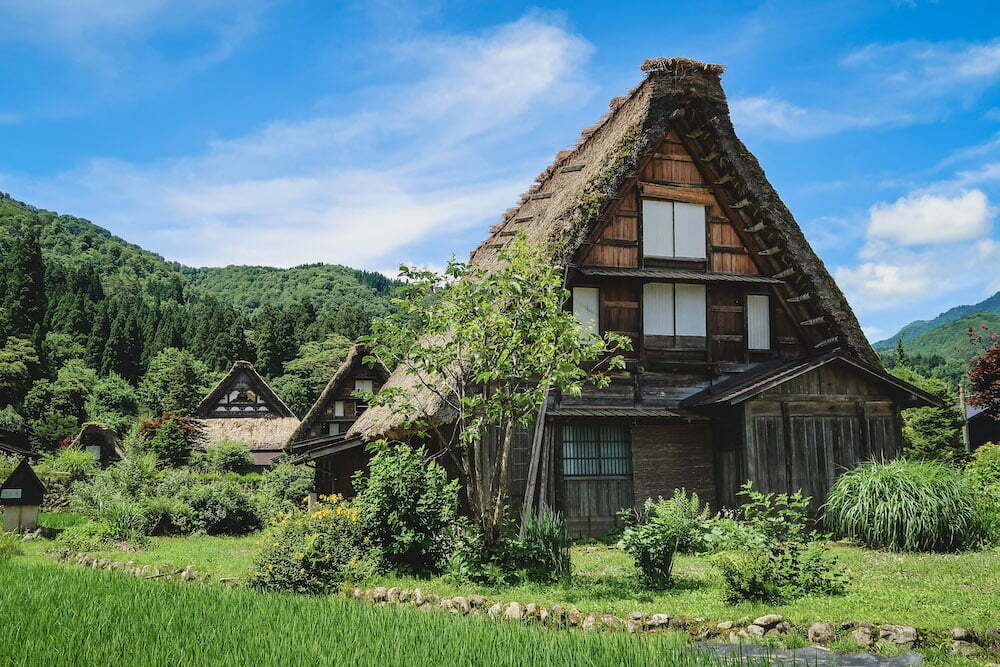
Tips for Traveling in Rural Japan
Public transportation considerations:.
- Schedules and Timing: While Japan is renowned for its punctual and efficient public transport system, rural areas may have less frequent services than metropolitan cities. It’s imperative to check schedules in advance, especially the last train or bus timings, to avoid being stranded.
- Japan Rail Pass: For those planning to travel extensively by train, consider investing in a Japan Rail Pass. It offers unlimited travel on JR trains over consecutive days, making it economical and convenient for tourists. Note that this must be purchased before arriving in Japan.
- Local Passes and Cards: Some regions offer their own travel passes for unlimited or discounted travel within a specific area. Researching these options can lead to savings. Additionally, IC cards like Suica and Pasmo, which are used in urban areas for seamless transactions, might be accepted in some rural transportation networks.
- Language Barrier: While urban transport often has announcements in English, rural areas might not. Having a translation app or a phrasebook can be beneficial. Additionally, taking screenshots of your destinations in Japanese can help in asking for directions.
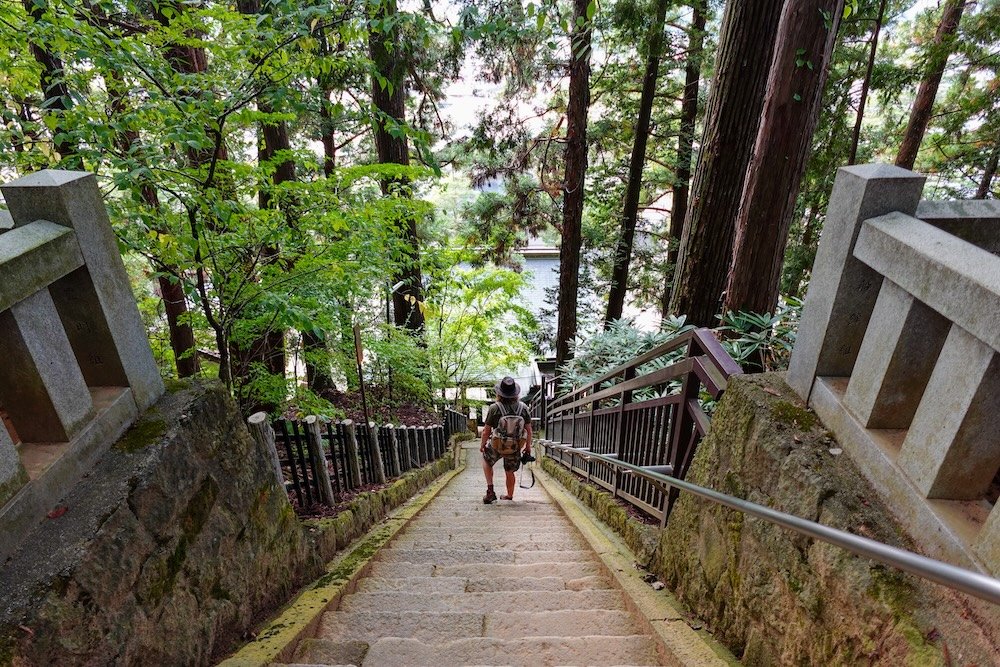
Etiquette and Respect for Local Traditions:
- Behavior at Shrines and Temples: Before entering sacred places, observe and follow local customs. This might include cleansing at a purification fountain, bowing, or refraining from loud conversations. Some areas might also require removing shoes before entering.
- Photography: Always ask for permission before taking photos, especially in rural areas where residents might not be accustomed to tourists. Some religious sites and private properties may also have restrictions on photography.
- Dress Appropriately: Especially when visiting religious sites, dressing modestly is appreciated. This can mean covering shoulders and wearing longer skirts or trousers.
- Avoid Littering: Japan is known for its cleanliness, and trash bins might be rare. Always carry a small bag to keep your trash and dispose of it at your accommodation or when you find an appropriate disposal area.
- Local Norms: Each region might have its own set of customs. For instance, in onsen (hot spring) towns, it’s common to see people walking around in yukatas (casual summer kimono). Embracing these traditions can enhance your experience.
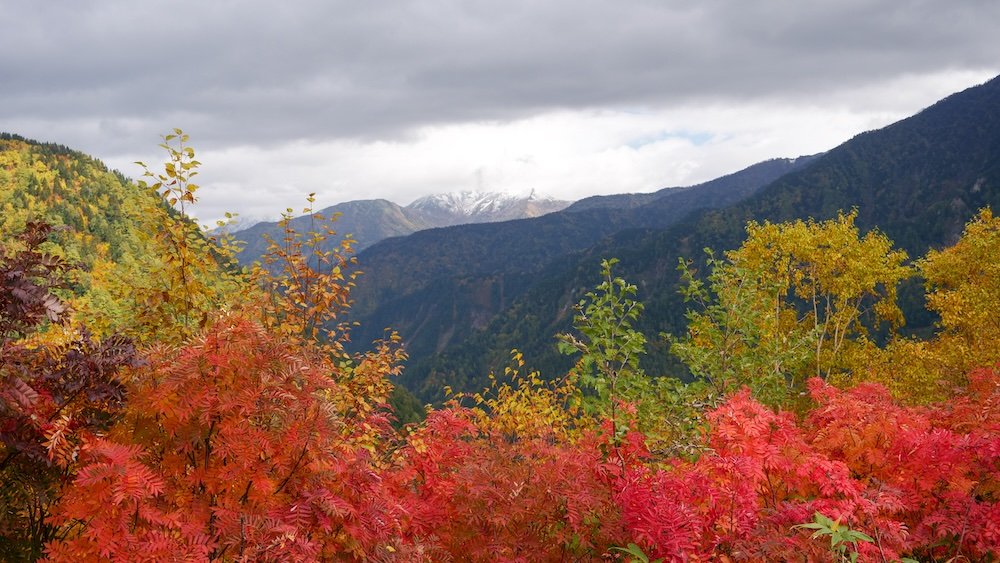
Best Seasons to Visit Each Destination:
- Shirakawa-go (Gifu): Best visited during winter when the gassho-style houses are blanketed in snow, creating a picturesque winter wonderland. Alternatively, autumn offers a palette of colors with the changing foliage.
- Noto Peninsula (Ishikawa): Spring and autumn are ideal for enjoying the coastal beauty without the summer crowds or winter chills.
- Yakushima (Kagoshima): Late spring, when the island’s rhododendrons are in bloom, or autumn, for cooler trekking conditions.
- Nikko (Tochigi): Autumn is renowned for its brilliant fall colors, making it a popular season. However, spring offers cherry blossoms juxtaposed against historic structures.
- Iya Valley (Tokushima) & Kiso Valley (Nagano): Both valleys are particularly stunning in autumn with their vibrant foliage. Spring is also a lovely time with fresh greenery and blooming flowers.
- Naoshima (Kagawa): Spring and autumn are pleasant for outdoor art exploration, avoiding the summer heat and the winter chill.
- Aso (Kumamoto): Spring, when the Aso caldera’s vast grasslands are lush and green, or autumn, when hues of brown and gold dominate the landscape.
- Kamakura (Kanagawa) & Takayama (Gifu): Both destinations are attractive year-round. However, spring offers cherry blossoms, and autumn brings vibrant fall colors. Takayama also has its famous festivals in these seasons.
Traveling in rural Japan offers a deeper dive into the nation’s heart and soul. While it requires a bit more planning and sensitivity towards local norms, the rewards in terms of experiences and memories are unparalleled. Embrace the journey with an open heart, respect for traditions, and a genuine desire to connect, and rural Japan will unfold its wonders in myriad, unforgettable ways.

Conclusion: Rural Destinations In Japan
In a world that often moves at breakneck speed, there’s a quiet call to slow down, to step away from the hustle of modern life and seek solace in the simpler, quieter corners of the earth. While Japan is famed for its neon-lit streets and bustling cities like Tokyo and Osaka , it also holds within its embrace hidden gems —places of pristine beauty , rich with tradition and tranquility . These rural landscapes, often overlooked by the hurried traveler, offer experiences that are deeply personal and profound .
Journeying through the Japanese countryside is like stepping back in time. It’s not just about seeing the sights; it’s about feeling the world around you. The gentle breeze rustling through ancient cedar forests, the warm sunlight filtering through autumn leaves, the silent stories whispered by old wooden buildings—all of these create moments that linger long after you’ve left. Traveling here becomes more than just a vacation—it’s a journey of self-discovery , a chance to capture and cherish meaningful moments .
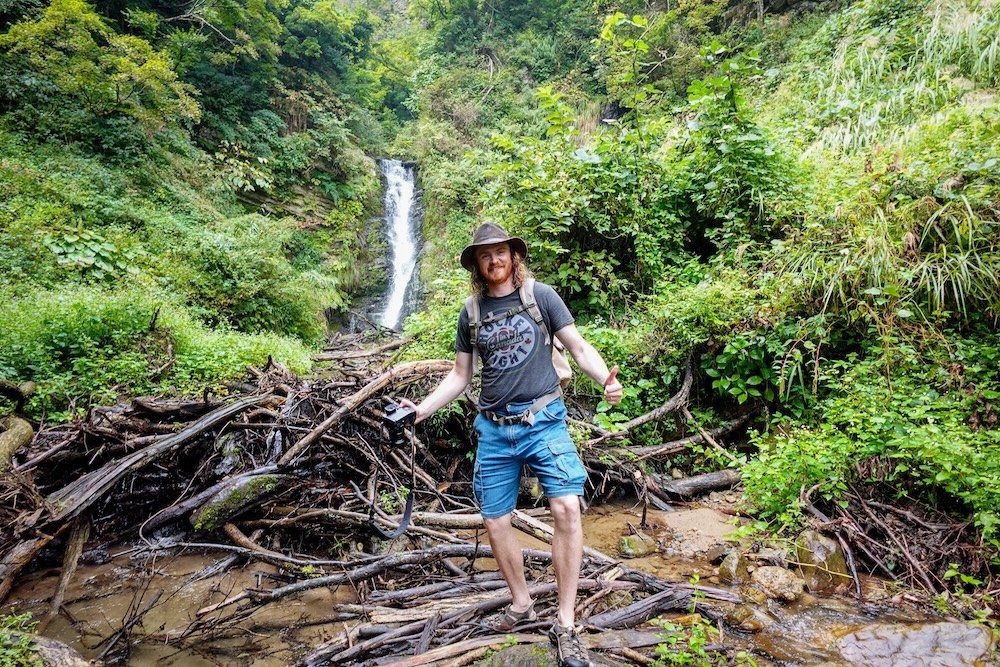
Japanese Countryside: Final Thoughts
In every hidden valley , along every winding trail , beside each murmuring stream , lies an invitation. An invitation to step away from the constant hum of technology , to leave behind the distractions of modernity , and reconnect with a world that offers authentic simplicity . Here, amidst the untouched beauty of Japan’s rural landscapes , you don’t just find breathtaking views—you find pieces of yourself . It’s a chance to rekindle your love for nature, to remember the beauty of quiet moments and the joy of slowing down .
But the allure of rural Japan isn’t just about the scenery. It’s the people , the guardians of tradition, who make each visit special. Their warm smiles and age-old customs create memories that last a lifetime. It’s the local festivals , where every dance and every float tells stories from the past. And it’s the food , crafted from ingredients grown in the very soil you walk on, bursting with flavors as pure as the hospitality with which they’re served.
In rural Japan, you don’t just visit—you connect . You experience a world where tradition and nature meet, and in doing so, you may just find the peace and simplicity you’ve been searching for.
You may also like
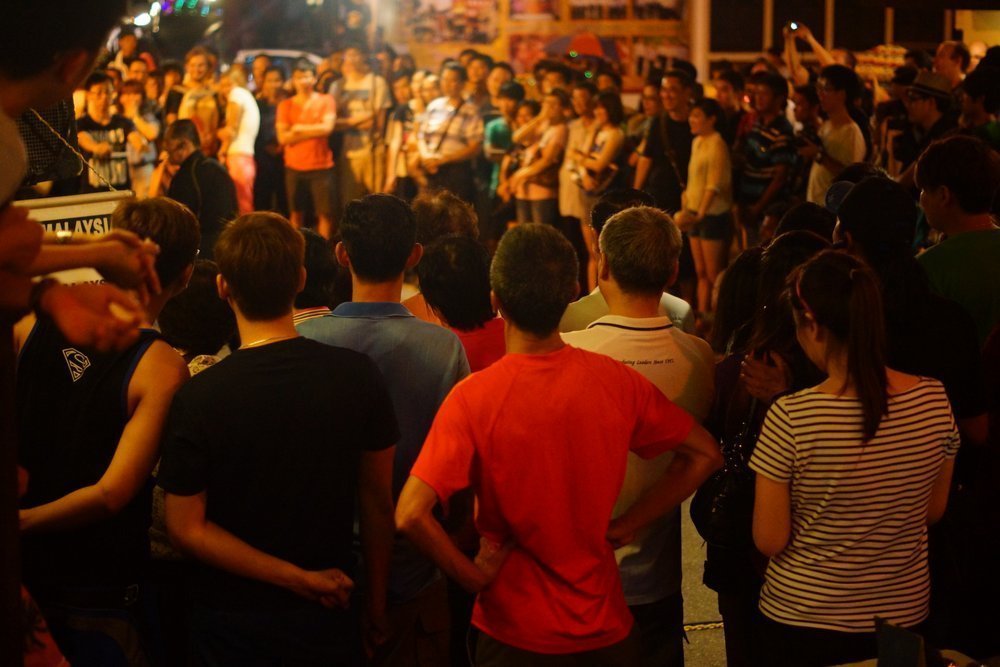
Jonker Street Night Market: Night Scenes From Malacca, Malaysia
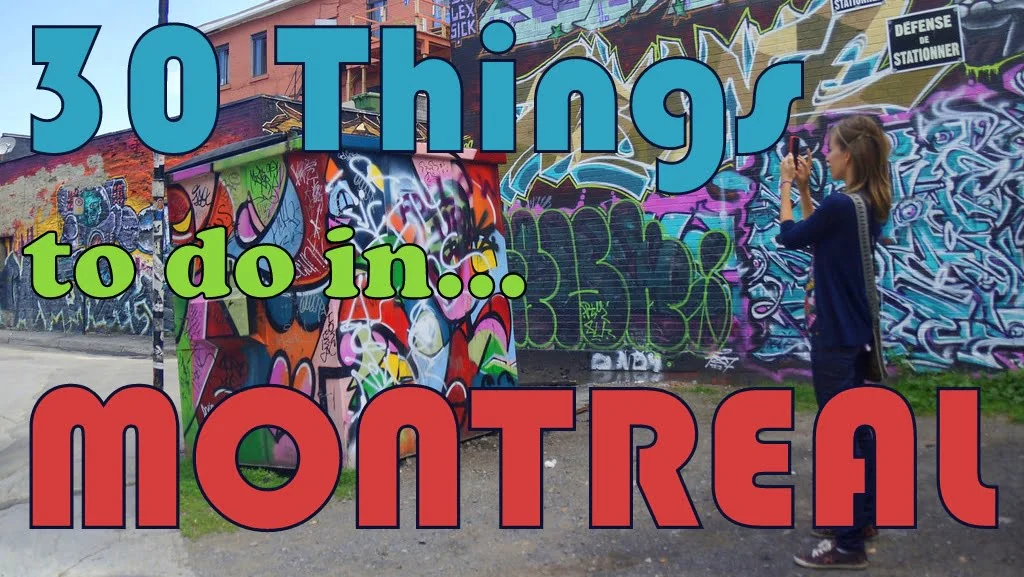
30 Things to Do in Montreal, Quebec: Montreal Summer Travel Guide

What To Eat In Munich, Germany: Savoring Bavarian Traditions
Your email address will not be published. Required fields are marked *
- Tours & Experiences
- Tailor-made Trips
- Bahasa Indonesia
We are happy to see you again!
Continue with
Or use email.
No Account? Create one
Create account
Already have an account? Sign in
Quickly Sign up with
I agree to Japan Travel's Terms of Service and Privacy Policy . Terms of--> and acknowledge that Japan Travel's Privacy--> applies to me.-->
Email reset password link
Please check your inbox and click the link we will send to you.
- Accommodation
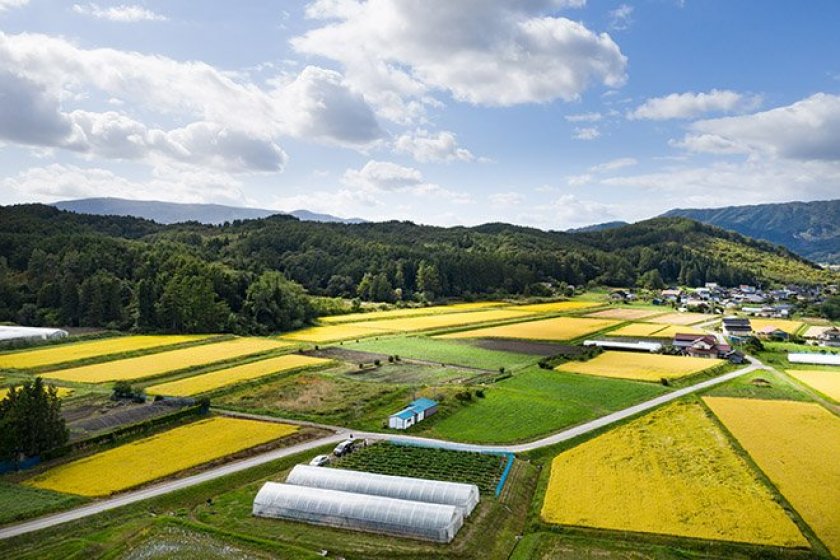
Top 10 Traditional Stays in Rural Japan
Discover a new way of life in the lush countryside

With the busyness of modern life, it’s easy to get caught up in a monotonous cycle of living–always looking forward or ruminating on the past, instead of living in the present.
Japan’s countryside, much of which is frozen in times past, is the perfect environment to pause and look inward. The abundant nature, traditional agricultural lifestyles, authentic people, and cultural opportunities offer invaluable memories built upon new perspectives. Whether you are harvesting local produce, cooking with a friendly stranger, or exploring a new neighborhood, it is difficult to be anywhere, but the present.
Listed below are ten traditional lodging experiences that are guaranteed to stay with you long after you leave.
Farm Guesthouse Agriturisimo Omori
Our first stop is Farm Guesthouse Agriturismo Omori in Tono, Iwate Prefecture. This traditionally designed wooden building, nestled among rice fields, farmland, and mountains, creates a scenic retreat that embodies simpler times. Join the Omori family, with matriarchy Tomoko Omori as your guide, and immerse yourself in their rural lifestyle.
Start your adventure by picking seasonal vegetables from the family’s farms, including peppers, tomatoes, corn, melon, potatoes, and more. Then, with Tomoko’s tutelage, transform the freshly picked produce into a delicious dinner that reflects local Iwate cuisine. Share the fruits of your labor with the Omori family, and refuel physically and mentally as you converse with your hosts. Tomoko is more than happy to share her knowledge of the area, which is steeped in Japanese folklore. End the day with a full stomach and enlightened mind as you drift to sleep on a futon in a tatami floored bedroom.
Learn more: Farm Guesthouse Agriturismo Omori
Farm Inn Sakekoshimai
Farm Inn Sakekoshimai, located in Odate City, Akita Prefecture, is a welcoming, family-centered inn that offers insights into the local culture. The traditional building, complete with tatami mats for sleeping, makes travelers feel as if they have stepped into the past. Foodies will not want to pass up a stay at this establishment, as its primary activity is cooking with the owners Mr. and Mrs. Yamauchi.
Start your food escapades by creating tanpo rice skewers, which are unique to Akita. Pound freshly cooked rice, mold it onto skewers, roast it on hot coals, slather it with a sweet miso paste, and then enjoy! Afterwards, with help from the Yamauchi’s, fill the dinner table with roasted fish, kiritanpo-nabe (a type of hotpot), and local vegetables.
The next morning, explore the rural neighborhood and refuel with a filling breakfast. If you are staying mid-September to early October, try your hand at rice harvesting with a machete! After a hard day’s work, visit the nearby onsen, Yatate Heights, to soothe your weary body in hot waters encircled by the countryside.
Learn more: Farm Inn Sakekoshimai
Gonbo no Ie Farmhouse
Gonbo no Ie Farmhouse in Shinano, Nagano Prefecture truly embodies the area’s agricultural spirit thanks to its wide variety of hands-on farming activities. The husband and wife team, Keizou and Chisato Kurata, take guests on a journey through a day in their life. The traditional farmhouse itself acts as an extension of the rural atmosphere and features an earthen genkan entryway and a historically accurate irori stove.
After admiring the atmospheric charm of the farm, prepare yourself for a day of manual activities. Harvest vegetables, such as eggplant and carrots, collect eggs from the chicken coop, and then follow Keizou to his bee hives and gather fresh honey! Return to your home away from home, as Chisato presents a lovingly crafted meal using the vegetables you picked that day. Gather around the irori stove with the family and other guests, and cook skewered fish and vegetables, enjoy glasses of sake, and listen to the Kurata’s as they regale you with their life stories.
Before you leave, be sure to purchase a jar of Keizou’s fresh honey for a sweet taste of the memories you will carry indefinitely.
Learn more: Gonbo no Ie Farmhouse
Moshi Moshi House
Kamijo, a quaint village nestled in the mountains of Yamanashi Prefecture, is culturally renowned for its fukusuke architecture. These buildings feature thick, thatched roofs and wooden facades. Architectural and history enthusiasts will be excited to know that they can lodge at one of the oldest houses in the area–the Moshi Moshi House. This 150-year-old structure includes sliding doors, futons, tatami mats, and even a kotatsu (quilt-covered table with a heater underneath).
Moshi Moshi House’s manager, Ayumi Uchida, often takes guests on a tour through the town’s shrines, temples, and nature, which are frozen in the past. After your exploration on foot, join Ayumi in the kitchen and learn how to make hoto , a popular stew of flat noodles and seasonal vegetables. The hearty stew, coupled with the welcoming atmosphere of the Moshi Moshi House, is guaranteed to warm your heart.
Learn more: Moshi Moshi House
Wan de En, in the small region of Kawada, Fukui Prefecture, is a guesthouse that offers visitors relaxed, yet authentic cultural experiences. The 150-year old building has roots in the lacquerware industry and is located near multiple lacquerware studios. The structure itself stays true to times past with a preserved wooden facade, tatami mat floors, decorated sliding doors, patterned lights, and more. The guesthouse’s traditional atmosphere is complemented by the mountainous nature of Kawada.
The main event at Wan de En is the chaji experience, which is a specialized type of tea ceremony. This formal event is run by the guesthouse’s amiable owner, Mayumi Araki, who encourages guests to take part in her version of the event, which is free from the pressures of a true chaji . After dressing in a kimono, you are ready to go. During the ceremony Mayumi instructs you how to light a hearth and prepare tea. She also provides a delicious meal of local ingredients and explains the ritualized steps of the ceremony. A stay at Wan de En is a wonderful way to gain insights into Japan’s cultural practices.
Learn more: Wan de En
Farmhouse Tennyo Sanchi
Farmhouse Tennyo Sanchi, located in Echizen City, Fukui Prefecture, is a 140-year farmhouse brimming with traditional Japanese charm. The old homestead is equipped with a traditional stone kiln, wood stove, and irori sunken hearth, and features tatami floors and an open air bath for relaxing. During your stay, spend the day hiking through the mountainous environment or picking vegetables at one of the many nearby farms. For food oriented activities, learn how to make soba noodles or mochi rice cakes from the owners, Mr. and Mrs. Watanabe. After a fulfilling day, enjoy a homemade meal of local ingredients, pickled vegetables, and fresh fish.
Learn more: Farmhouse Tennyo Sanchi
Akizuno Garten Guesthouse
For a unique lodging experience, spend the night at Akizuno Garten, a converted elementary school in Tanabe, Wakayama Prefecture. This repurposed building architecturally maintains its schoolhouse charm and is surrounded by lush nature. This nostalgic theme continues with the guest house’s lunches which are prepared daily by local mothers.
However, Akizuno Garten is more than just a place to recharge with food and rest. Thanks to its collaborations with nearby farms, the guest house also offers seasonal hands-on experiences such as fruit picking, a juice factory tour, hiking, and more.
Be sure to check out the sweets shop onsite, Valencia Batake, which holds jam, marmalade, roll cake, fruit tart, cream puff, and mikan juice making classes. This shop is the perfect place to create a sweet souvenir.
Learn more: Akizuno Garten
Origin Guesthouse
If you are looking for a relaxing countryside getaway, look no further than Origin Guesthouse in Ayabe City, Kyoto Prefecture. The guest house, with its quaint farmhouse vibes and ubiquitous natural beauty, is the picture of a traditional Japanese stay. The guest house’s operator, Yasuko Kashiwabara, is no stranger to the allure and simple integrity of rural life as she gave up her busy city life for its rewarding blessings.
The authentic vibes of the abode, complete with futons, tatami-mat flooring, and warm kotatsu tables, perfectly complement the rural farmside. During your stay, enjoy the family’s lovingly prepared meals filled with home grown and local ingredients. For a leisurely farm activity, accompany Kashiwabara to her azuki bean fields, and help her harvest the small legumes. Later, recharge with the family’s homemade azuki sweets and enjoy a chat with your hosts. A stay at Origin Guesthouse is guaranteed to refresh your mind, body, and soul thanks to its all encompassing atmosphere of relaxation and harmony.
Learn more: Origin Guesthouse
Komoda IL SOGNO Guesthouse
For a homey island retreat, stay at Komoda IL SOGNO Guesthouse on Tsushima Island. This family run guest house offers a variety of meals and experiences that encapsulate seaside life. Don your best fishing attire and hit the piers for some fishing. Then learn how to prepare your catches and cook them the Tsushima way on a heated stone. For mealtimes, your host father prepares unique Italian dishes crafted with fresh seafood and seasonal vegetables. Try sea bream carpaccio and blue-swimming-crab soup.
The guesthouse also holds traditional Japanese workshops, such as wooden coaster-making and origami. The onsite flower garden, lovingly tended to by the host mother, blooms brilliantly with roses in spring and summer and supplies rose petals for aromatic baths after a day of activities by the sea.
Learn more: Komoda IL SOGNO Guesthouse
Euchi Shizen Chiyu-no-sato
For a wholesome farm stay, visit Euchi Shizen Chiyu-no-sato in Izumi, Kagoshima Prefecture. The hosts Fumio and Hiroko Ideue are more than happy to share their slice of paradise with curious passersby. The husband and wife’s personalized home includes a traditional irori sunken hearth and open kitchen, perfect for sharing their love of food with hungry guests.
Spend the day picking seasonal fruit or vegetables, and then take a break with a visit to Wakimoto beach for spectacular sunset views.
The couple truly comes to life during dinnertime. Help them craft dishes using local produce and learn the secrets of pickling and preserving. All the while, sample the family’s creations, including pickled shiso (Japanese basil) and green garlic paste. After preparing the food, sit around the hearth, and enjoy sashimi, salad, tempura, hotpot, and more. Of course, the next morning, the family also serves you a delicious and filling Japanese breakfast to start your day.
Learn more: Euchi Shizen Chiyu-no-sato
For more rural Japanese experiences, check out Countryside Stays Japan .
- Share on Facebook
- Share on X (Twitter)
- Copy link to share
By Veronica Carnevale
Sponsored content

Book your trip
Find a nearby hotel, top articles.
- Recommended

Sakura-tei: The World's Largest Okonomiyaki Restaurant

Princess Adachi Festival

APARTMENT HOTEL MIMARU

Post-quake Support for Noto

Culture and Beauty In Ishikawa Prefecture

Discover Kanazawa: A Golden Journey

Fairytale Experiences at Nukumori-no-mori

Fūrin, the Symbol of Japanese Summer

A Foot Bath Path In Kaminoyama

Guided Tour for Foreign Visitors to Experience Traditional Japanese Performing Arts and Learn About the History of Ginza!

Guide to Bringing Medicines Into Japan

A Guide to Japanese Visas

Your Name: Real-Life Locations in Tokyo

The Ultimate Guide to Thrifting in Tokyo

Daikoku Car Meet

September Grand Sumo Tournament (Tokyo)

Japanese Urban Legends

Hachiko Statue in Shibuya

Tokyo Auto Salon

Iwatayama Monkey Park
More from this category.

Guide to Japan's Love Hotels
By JJ Nakao

The Bathhouses of Shibu Onsen
By Linka Wade

Pokémon Sleep Comes to Grand..
By Tom Roseveare
Join the discussion

Let us know how we can help.
Help us improve JapanTravel.com
We welcome any suggestions regarding this content. Your feedback is confidential and will be used to help improve this page.
Suggest an edit
https://en.japantravel.com/article/top-10-traditional-stays-in-rural-japan/68517
Thank you for your support!
Your feedback has been sent.
Boutique Japan
Luxury Ryokans & the Japanese Countryside (13 Days)
An immersive 13-day itinerary featuring essential highlights along with beautiful off-the-beaten-path destinations in the Japanese countryside. Visit the ancient capital Kyoto, charming and historic Kurashiki, the remote Ise Shima National Park, rural Shuzenji Onsen in the Izu Peninsula, and the Tokyo metropolis.
Let us create your trip completely from scratch.
Our sample itineraries are here to inspire, but this is not a fixed itinerary and is designed to be customized around you.

Andra Smith, Connecticut
We absolutely loved our trip. I fell in love with Tokyo and am secretly hoping I can convince my sister or friend to visit soon so I can go with them to see more of the neighborhoods we missed this time around. Each guide was very, very well-matched with the type of tour they gave.… Read More
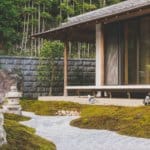
Paula Alsher, Marietta, Georgia
Boutique Japan did a fantastic job of planning an itinerary that completely matched our vision. Our group of 4 came away feeling that for 2 weeks, we had the opportunity to become immersed in the daily life of the Japanese. The guides, the hotels, and the experiences were all expertly planned. The app they provided… Read More
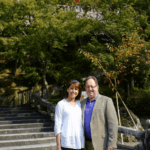
Lyn & Peter, Australia
We are very experienced, independent, international travelers but we found trying to plan and book a personalised holiday in Japan in late 2015 to be very challenging. That is until we discovered the wonderful team at Boutique Japan. After describing our areas of particular interest in art, architecture, culture and fitness, Andres and his team… Read More
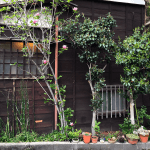
Brett & Kirsten, California
My wife and I just got back from our Boutique Japan trip, and it was fantastic. Andres has excellent attention to detail, and the information they put together was tremendously helpful along the way. Some say Americans will never feel as foreign anywhere in the world as they do when they're in Japan, but all… Read More
Sample Trip Highlights
- An immersive private itinerary, crafted with love by Boutique Japan
- Kyoto , the heart and soul of traditional Japan
- Impeccable hospitality and kaiseki cuisine in charming Kurashiki
- Stunning art and architecture on Naoshima , including a stay at Benesse House
- Luxurious accommodations, rugged landscapes, and ancient shrines in Ise Shima
- The quaint hot springs village of Shuzenji Onsen
- Tokyo , one of the world’s most exciting cities
- All your accommodations, in boutique and luxury hotels and ryokans to match your taste and priorities
- Unique private tours and experiences with fun and knowledgeable local experts
- Seamless logistics and in-country transport via the shinkansen (bullet train) and more
- Extensive pre-departure information to help you prepare for your trip
- Access to our in-depth Japan expertise, relationships, and firsthand experience
- A Japan specialist to answer your questions, and thoughtful customer service

Itinerary Overview
Fly into either of Osaka’s airports, Kansai (KIX) or Itami (ITM).
This sample itinerary can also be customized to begin in the Kanto region (where Tokyo is located), flying into either of Tokyo’s airports, Narita (NRT) or Haneda (HND).
Day 1: Arrive in Kyoto, Japan Day 2: Unique Highlights of Kyoto (On & Off The Beaten Path) Day 3: Fushimi Inari Shrine & Luxurious Ryokan Stay in Kurashiki Day 4: Private Tour of Historic Kurashiki Day 5: Visit Naoshima, Japan’s Wonderful Art Island Day 6: Teshima Island & the Teshima Art Museum Day 7: Travel to the Remote Ise Shima National Park Day 8: Spiritual and Historic Ise Jingu, Japan’s Most Sacred Shrine Day 9: Travel to the Traditional Hot Springs Town of Shuzenji Onsen Day 10: Enjoy Onsen and Kaiseki at Your Luxurious Ryokan Day 11: Travel from Shuzenji to Tokyo & Old Tokyo Stroll Day 12: Tsukiji Market, Modern Tokyo Highlights & Evening Izakaya Outing Day 13: Depart Japan
Depart from either of Tokyo’s airports, or customize this trip to end with departure from Osaka or elsewhere in Japan.
Itinerary Details
Day 1: arrive in kyoto, japan.
Welcome to Japan! On arrival in Osaka, you’ll be met and transferred by private vehicle to your lovely accommodations in neighboring Kyoto.
Depending on your flight’s scheduled arrival time we typically recommend keeping your first evening free, both in case of unexpected flight delays, and also to account for possible fatigue from the long journey.
Settle in, adjust to your exciting new surroundings, and get ready for your adventure ahead!
Your Kyoto hotel : The Ritz-Carlton, Kyoto or Hotel Kanra Kyoto

Day 2: Unique Highlights of Kyoto (On & Off The Beaten Path)
Ohayou gozaimasu (good morning)!
Today is your first full day to begin taking in the ancient capital Kyoto. You’ll begin with an immersive half-day tour introducing you to the city, and end with a fascinating evening in one of the city’s atmospheric geisha districts.
After a delicious breakfast at your hotel, you’ll be met by your insightful private guide. While Kyoto can certainly be enjoyed without a guide, exploring with a fun and knowledgeable expert by your side will dramatically enhance your experience.
At Boutique Japan, we have exceedingly high standards when it comes to private guides, and carefully design each private tour to cater to your unique priorities and interests.
Kyoto is one of the most culturally rich cities in the world, and the place most travelers dream of when envisioning Japan. Home to 17 UNESCO World Heritage sites, Kyoto was the capital of Japan for over a thousand years and remains the heart and soul of traditional Japan.
Today it is a large modern city of over a million residents, and at first glance looks almost like any other Japanese town. But the city retains many of its long-established traditions, and despite the neon and concrete prevalent in many parts of town, Kyoto is teeming with beautiful and well-preserved pockets where time seems to move more slowly.
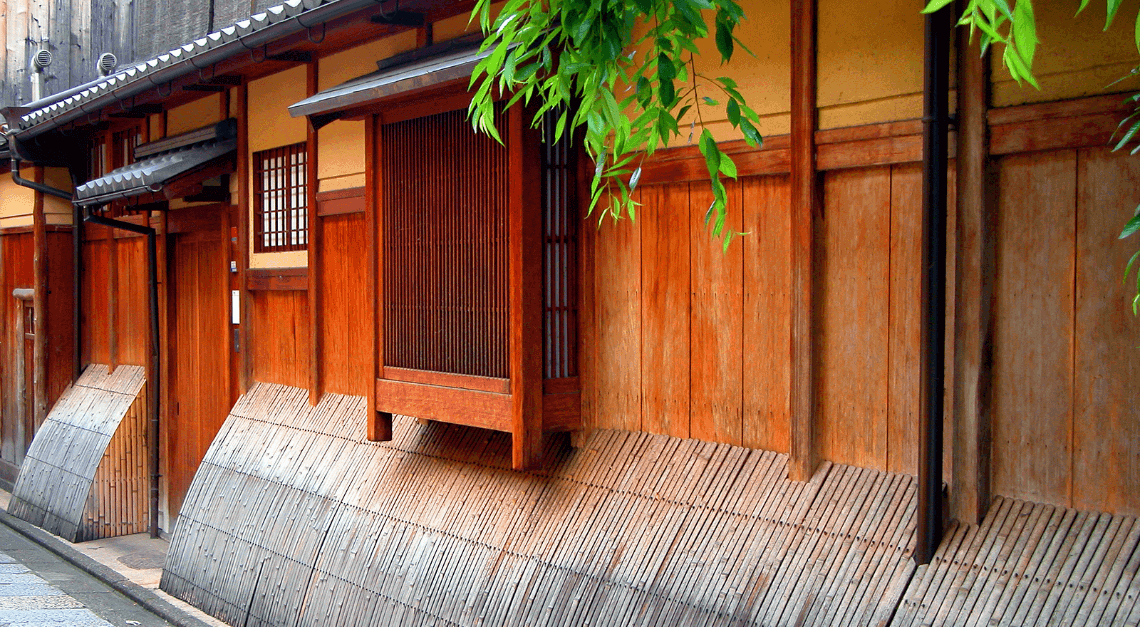
Explore highlights such as (for example) the historic Higashiyama district, the charming Philosopher’s Path, and the picturesque Arashiyama district, along with off-the-beaten-path strolls through lesser-known Kyoto areas with your expert guide.
Kyoto is also rightly renowned for its cuisine and artisans. The colorful Nishiki Market is crowded but a must-visit for food and market lovers. For travelers interested in the arts and traditional crafts, the chance to visit with a shokunin (master craftsperson) in their private workshop is an unforgettable experience.
Beyond the extraordinary sights and wealth of traditional culture, Kyoto is also home to a booming creative scene, and throughout the ancient capital you’ll also find stunning modern design in museums and galleries, along with shops and cafes.
Following your private tour, you’ll have some time to relax at your hotel and recover from any remaining jet lag you may have, or continue exploring independently. For your free time, you’ll be able to take advantage of the pre-departure materials we provide to each of our travelers.
In the early evening, you’ll head out on a fascinating private walking tour through the backstreets of Kyoto’s best-known geisha district, Gion. As you slowly meander your way through the narrow lanes and hidden alleys of this enigmatic district, your expert guide will teach you about the history and reality of Kyoto’s geiko (as geisha are called in Kyoto) and maiko (apprentice geisha).
This is a great way to learn about Japan’s most misunderstood traditional profession, and it’s likely you’ll come across geiko or maiko en route to their evening appointments. Following your immersive stroll, your guide will leave you at a great local restaurant. Kanpai!

Day 3: Fushimi Inari Shrine & Luxurious Ryokan Stay in Kurashiki
This evening you’ll have a sublime ryokan experience, but before leaving for Kurashiki you’ll have one last adventure in Kyoto.
An early start is necessary, as you’ll be visiting Fushimi Inari Taisha, one of Japan’s most famous sightseeing spots. Fushimi Inari is worth visiting even for people who generally avoid “touristy” places, and the easiest way to avoid crowds is by arriving early!
In the early afternoon you will make the easy journey to charming Kurashiki.
When it’s time to depart, you’ll be picked up at your hotel for your private transfer to Kyoto Station. Before leading you to your train, your guide will help you find beautiful bento box lunches to enjoy on the journey (major train stations in Japan offer an astounding variety of delicious seasonal bentos).
Then you’ll be escorted right to your departure platform for your first experience on Japan’s remarkable trains . Today you’ll be speeding west via Japan’s iconic shinkansen (bullet train), a wonderfully pleasant way to travel.
There is nothing quite like staying at a ryokan (traditional Japanese-style inn) , and you’ll have the afternoon and evening to slowly settle into the relaxed pace of life in laid-back Kurashiki.
Located along the scenic canal in the heart of Kurashiki’s beautifully preserved historical district, the wonderful Ryokan Kurashiki is one of Japan’s best traditional ryokans and is rightly renowned for its extraordinary Japanese hospitality and fantastic cuisine.
Dinner tonight will be a magnificent kaiseki feast featuring seasonal and local specialties.
Your Kurashiki ryokan : Ryokan Kurashiki
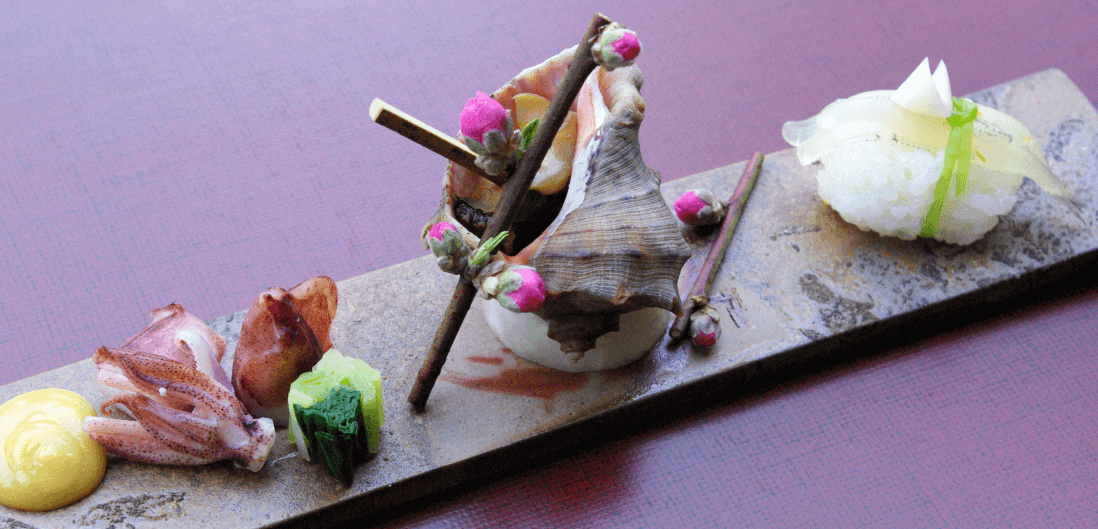
Day 4: Private Tour of Historic Kurashiki
Early morning at leisure to relax in your calming Japanese-style surroundings and enjoy a beautiful Japanese breakfast. After breakfast you’ll be met by a local expert who will take you on a private walking tour of Kurashiki.
During the Edo Period , Kurashiki was an important rice distribution center and today the old merchant district, known as the Bikan Historical Quarter, is lined with attractive kura (storehouses) that have been lovingly preserved and converted into charming galleries, boutiques, and cafes.
Kurashiki’s lovely old streets are best explored slowly and on foot, and throughout the town you’ll find important landmarks and museums, traditional temples and shrines, a historic sake shuzo (brewery), and countless small shops featuring regional textiles, pottery, crafts, and foods.
For active travelers, the Kibi Plain in the rural outskirts of Kurashiki offers an idyllic setting for a leisurely bicycle ride through the Japanese countryside, passing fields, quaint farmhouses, temples, and shrines.
Part of the joy of a ryokan stay is doing nothing, and you’ll have some time this afternoon to relax in your gorgeous Japanese-style suite over over tea or sake.
This evening enjoy another splendid kaiseki feast in traditional surroundings.

Day 5: Visit Naoshima, Japan’s Wonderful Art Island
Today you’ll travel to the art island, Naoshima, a must-visit destination for art and architecture lovers. The island offers a truly beguiling combination of beautiful natural scenery, charming fishing villages, and cutting-edge modern art and architecture that blend into the coastal landscape.
The journey from Kurashiki to Naoshima is easy, with an effortless private transfer to the tiny Uno Port, and a short ferry across to the island. As a guest of the one-of-a-kind Benesse House, which doubles as a hotel and museum, you’ll have access to the convenient hotel shuttle making the rounds of the island’s various art sites.
Enjoy the full afternoon taking in the island’s museums, galleries, and installations. Among Naoshima’s many highlights are the stunning Chichu Art Museum, the Art House Project, the Lee Ufan Museum, and Benesse House itself (fans of Japanese architect Tadao Ando will be particularly delighted).
You’ll spend the night at the Ando-designed Benesse House, which overlooks the Seto Inland Sea. Guest rooms in each of the hotel’s unique buildings (Museum, Oval, Beach, and Park) feature different works of art, and — among other perks — guests of the hotel enjoy special after-hours access to Benesse House Museum.
Enjoy a peaceful evening in the laid-back Setouchi region of Japan.
Your Naoshima hotel : Benesse House
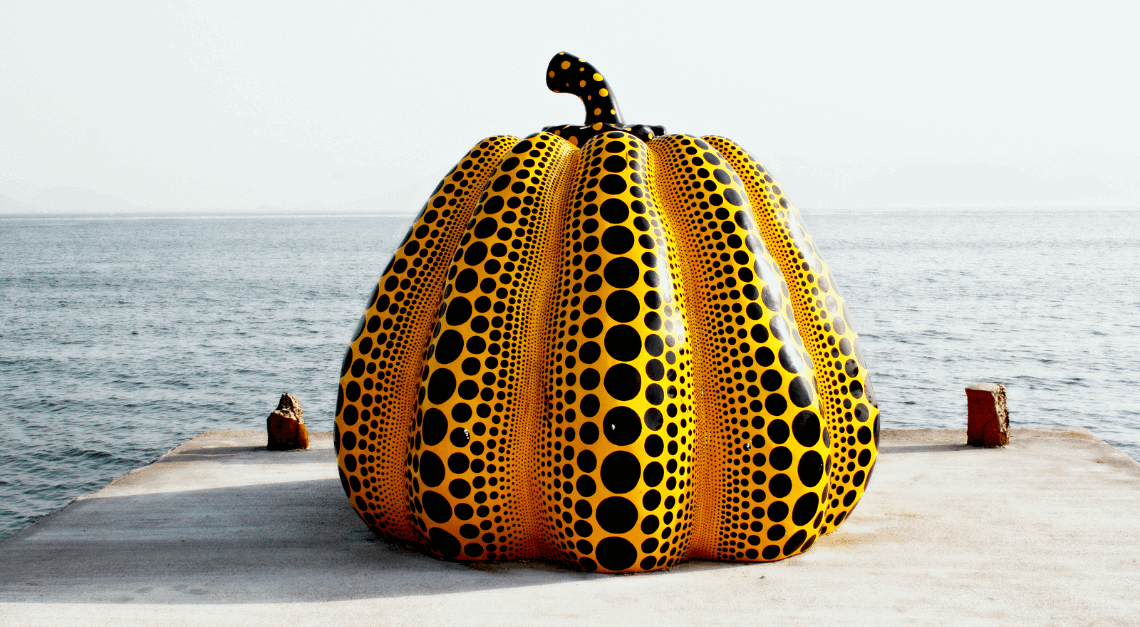
Day 6: Teshima Island & the Teshima Art Museum
You’ll have another full day in the art islands, and today have the opportunity to visit the nearby art island of Teshima.
Teshima is part of the greater Benesse Art Site (Inujima is another of the main art islands), located just thirty minutes by ferry from Naoshima.
The sleepy island’s standout is the incredible Teshima Art Museum , an awe-inspiring structure shaped like a drop of water by architect Ryue Nishizawa and artist Rei Naito.
You’ll have the remainder of the day to enjoy Teshima — home to galleries, installations, tiny cafes, and charming rural landscapes — or continue taking in Naoshima’s many highlights.
Enjoy another night at the one and only Benesse House.

Day 7: Travel to the Remote Ise Shima National Park
Enjoy a final early morning on Naoshima before departing for your next destination deep in the Japanese countryside, Ise Shima National Park.
Leaving Benesse House you’ll retrace your steps by ferry and private transfer, and then begin the rail portion of today’s travels to Ise Shima. On arrival following the journey, you’ll be rewarded with luxurious accommodations and have the remainder of your afternoon and evening to settle into Amanemu.
Aman Resorts’ take on the Japanese ryokan, Amanemu features natural onsen (hot springs), views of the scenic Ago Bay, seasonally inspired cuisine, and an award-winning spa and wellness program.
Relax in your spacious accommodations, soak in your rejuvenating private onsen, and this evening enjoy a sumptuous dinner featuring exquisite local ingredients.
Your Ise Shima hotel : Amanemu
Day 8: Spiritual and Historic Ise Jingu, Japan’s Most Sacred Shrine
Sleep in or enjoy an early morning yoga session, followed by a healthy and delicious breakfast. Then you’ll venture out on a fascinating private tour of nearby Ise.
Ise has long been one of Japan’s most important historical and spiritual destinations, and is home to Ise Grand Shrine (Ise Jingu), the country’s most sacred Shinto shrine.
The ancient Ise Jingu is a vast forested shrine complex home to over a hundred shrines. Jingu’s main shrines are Naiku (the Inner Shrine), dedicated to the sun goddess Amaterasu, and Geku (the Outer Shrine).
In keeping with tradition, the breathtaking shrines — constructed from cypress, and built without nails — are completely rebuilt every 20 years.
Oharaimachi, the old-fashioned street leading to the Inner Shrine, is lined with quaint shops and restaurants, many dating back generations.
The coastal sanctuary of Ise Shima National Park offers a wealth of memorable experiences, including the chance to learn from and dine with one of Ago Bay’s legendary Ama female freedivers, or the opportunity to fish with a local expert angler and savor fresh sashimi prepared by a master chef.
Tonight enjoy an unforgettable sunset cruise and a final evening in this lovely region of Japan.

Day 9: Travel to the Traditional Hot Springs Town of Shuzenji Onsen
Today you will travel from one part of the Japanese countryside to another as you make the journey from Ise Shima to Shuzenji Onsen.
Your journey by rail will take you north and then east as you speed through central Japan, culminating with your arrival in charming Shuzenji.
Located in Japan’s lush Izu Peninsula, Shuzenji Onsen is famed for its healing hot springs, traditional atmosphere, and refined traditional ryokans.
The Izu Peninsula is one of our favorite places to experience a luxury ryokan in Japan.
This afternoon settle into your sophisticated Japanese-style surroundings, or head out for a leisurely stroll through the picturesque Shuzenji, a quintessential hot springs town.
In Shuzenji, you’ll stay at a luxurious traditional ryokan renowned for its kaiseki cuisine and soothing onsen.
Your Shuzenji Onsen ryokan : Asaba or Yagyu no Sho
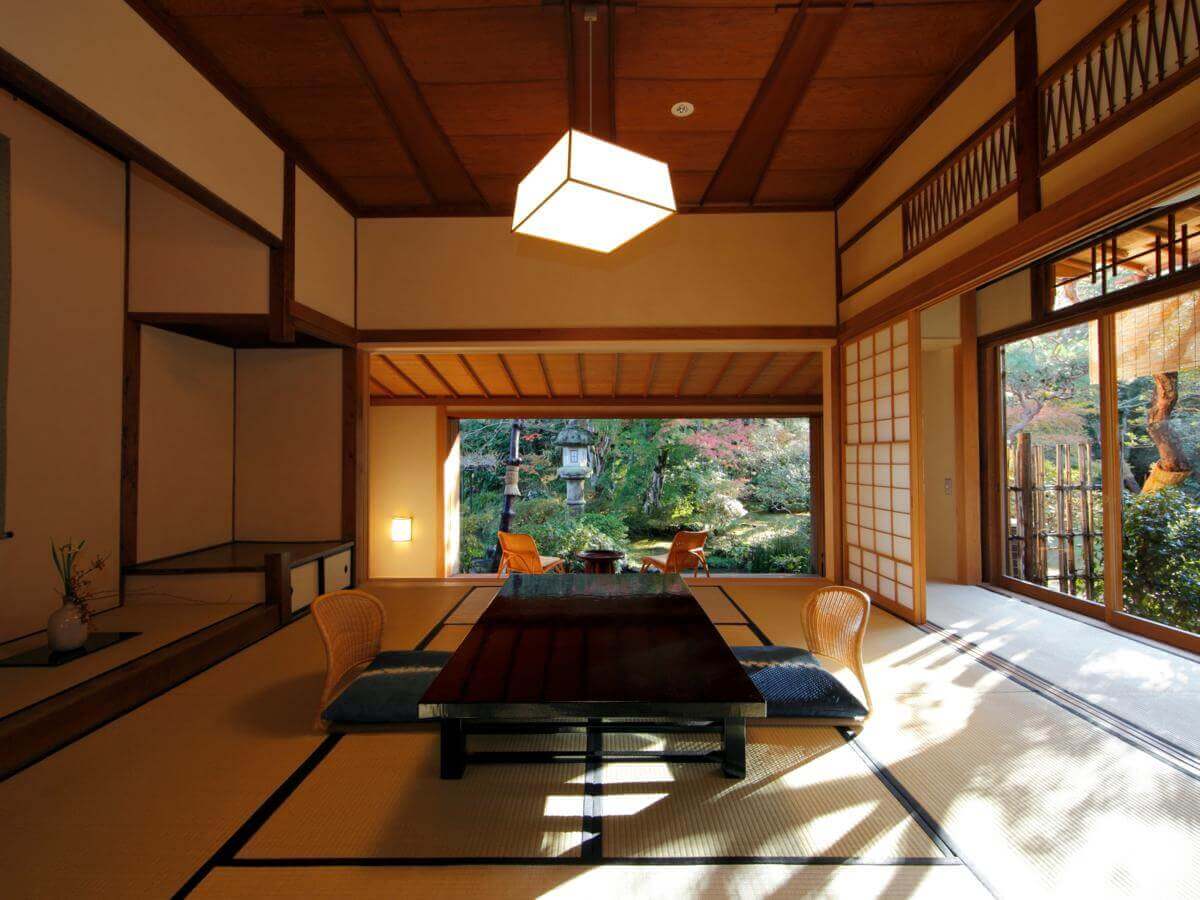
Day 10: Enjoy Onsen and Kaiseki at Your Luxurious Ryokan
Before your adventures continue to Tokyo tomorrow, take a day to decompress amidst your serene traditional surroundings.
Linger over an amazing Japanese breakfast and savor the tranquil pace of life in rural Japan. The Shuzenji area offers plenty to see, do, and eat, though you’ll experience plenty of excitement tomorrow in Tokyo!
Luxuriate in your final evening in the Japanese countryside, with one last kaiseki feast.
Day 11: Travel from Shuzenji to Tokyo & Old Tokyo Stroll
Take it slow this morning and relax with another soak in the onsen. Following an unhurried breakfast at your ryokan, you will depart by rail for the easy journey to nearby Tokyo.
On arrival at the massive Tokyo Station, you’ll be met right on your train’s arrival platform and escorted to your hotel. After dropping off your bags, your insightful guide will lead you on an immersive private tour designed to give you an authentic yet off-the-beaten-path experience of Tokyo.
Tokyo is one of the world’s liveliest cities, full of amazing restaurants, beautiful gardens, stunning modern architecture, charming backstreets, and a glittering neon-filled cityscape. Beyond the city lights and crowds, Tokyo is also full of quiet neighborhoods where you’ll find locals going about their daily lives, and countless hidden gems in the form of unsung yet wonderful little shops and restaurants.
Begin in Yanaka, one of Tokyo’s most well-preserved historical districts, and an up-and-coming area for young creatives. It was largely spared during World War II, and today is home to quaint streets, small temples and shrines, and a plethora of traditional shops selling Japanese sweets, rice crackers, paper, and other goods. Yanaka is also home to galleries, such as the renowned SCAI the Bathhouse.
From Yanaka, walk to nearby Ueno, a bustling yet old-fashioned district best known for Ueno Park, which is home to various museums including the excellent Tokyo National Museum. You’ll come upon Ameyoko-cho, a boisterous outdoor marketplace where you can find everything from groceries and clothing shops to open-air yakitori stalls and more.
End with an early evening stroll through the backstreets of Asakusa, Tokyo’s best-known historical district. After taking in Senso-ji, Tokyo’s oldest and most famous temple, wander with your expert guide into the area’s off-the-beaten-path side streets, which remain full of atmosphere and hidden gems.
Your Tokyo hotel : HOSHINOYA Tokyo or Hotel Ryumeikan Ochanomizu Honten
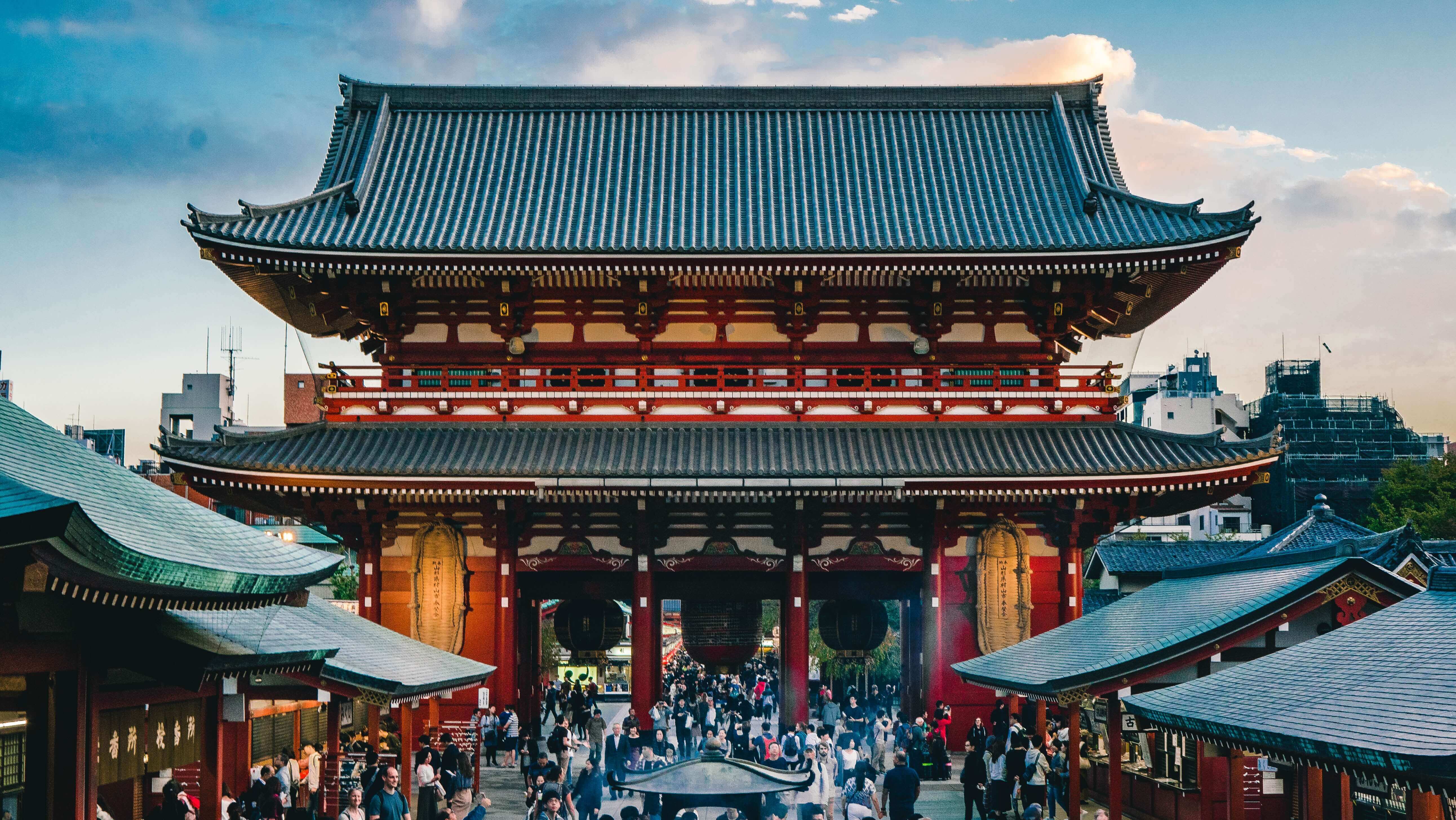
Day 12: Tsukiji Market, Modern Tokyo Highlights & Evening Izakaya Outing
Begin the day at Tokyo’s legendary Tsukiji Market .
While the wholesale section of the fish market moved to Toyosu in 2018, Tsukiji’s lively outer market remains an incredible place to immerse yourself in Japanese cuisine. You’ll find historic lanes and alleys packed with a colorful array of shops and small restaurants — not to mention atmosphere and charm to spare.
From Tsukiji, your guide will introduce you to a selection of unique Tokyo neighborhoods based on your interests and priorities. Explore charming neighborhoods such as (for example) Aoyama, Daikanyama, Naka-Meguro, and Kagurazaka; along with one or more notable galleries, shrines, or gardens such as Tomio Koyama Gallery, Meiji Jingu Shrine, and Koishikawa Korakuen Garden (explore more of our favorite Tokyo neighborhoods ).
Following your private tour you’ll have some time to take it easy at your relaxing hotel, or continue exploring independently making use of the pre-departure materials we provide to each of our travelers.
For a memorable farewell, this evening your private guide will take you to a casual and authentic izakaya (Japanese-style gastropub) , where you can enjoy a lively atmosphere and sample a delicious and eclectic variety of Japanese foods. Enjoy your final evening in Tokyo!
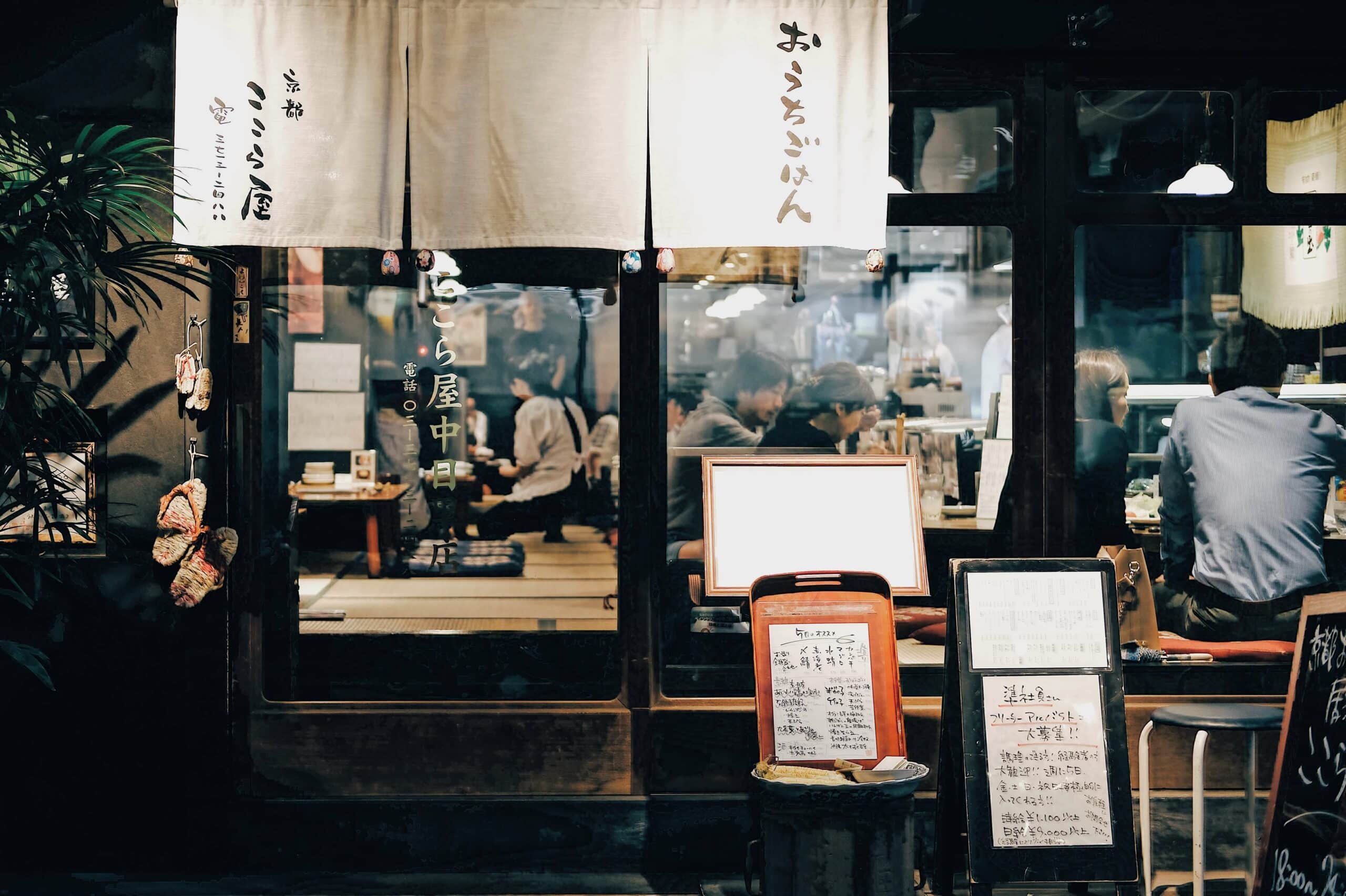
Day 13: Depart Japan
You’ll be free until departure. Depending on your flight time, you may have time for some last-minute explorations (and eating!).
In good time for your departure flight, you’ll be picked up at your accommodations for the comfortable private transfer to your departure airport.
Come back to Japan soon!
Plan Your Japan Trip
Learn more and contact us to discuss your unique trip.
Get Started
- The Process
- Testimonials
DEEPLY REGIONAL JAPAN

Authentic and personal experiences
What will be your next Japan travel experience?
Please note all our tours are suspended until further notice due to the covid-19 coronavirus outbreak around the world. please join our mailing list via the form below to receive our latest updates, thank you..

Discover authentic Japan! Customized private rural tours in Yamanashi.
Explore japans hidden nature & culture. choose your own unique adventure., customize your itinerary hiking, walking, cycling, wine tasting tours in rural yamanashi, travel the way you like & see rural japan your way with eco tours japan, hiking & walking tours in japan, cycling & mtb tours in japan, japan winery & wine tasting tours, welcome to japan - about our eco tours in yamanashi private rural japan tours and fun things to do in yamanashi & mt fuji world heritage area. cutomized nature & culture tours in rural yamanashi only 1.5 hours from tokyo., onsen - japanese hot springs relax tours, temples & shrines in yamanashi spiritual japan, customized private rural tours in japan, authentic rural japan tours in yamanashi, katsunuma & mt. fuji world heritage.
- Hiking Walking
- Cycling MTB
- Winery Wine Tasting
- Onsen Hot Spring
- Temples Shrines
Experience the hidden backcountry of the Minami Alps in Yamanashi with our Mount Kita overnight trek tour.
Enjoy the hidden nature of Japan with our special waterfall valley hiking & walking tour in Yamanashi.
Discover the deep backcountry of the Minami Alps in Yamanashi Japan. Our customized hiking tours in Japan are designed for everyone.
Explore the Minami Alps in Yamanashi Japan with our Mt. Kita overnight hiking tour.
Stunning scenery while hiking the ridgeline in the Minami Alps as part of our overnight alpine hiking tour in Yamanashi Japan.
Enjoy a cycling or mountain biking tour along the backroads and through the farmlands of Yamanashi.
Enjoy a cycling or mtb tour in Japan through the mountains of the Minami Alps in Yamanashi.
Enjoy a cycling or mountain biking tour through the forests in Yamanashi Japan.
Enjoy cycling or mountain biking tour in Japan around Mt. Fuji five lakes World Heritage site.
Enjoy cycling or mountain tour in Japan along the Fuji River in Kofu Yamanashi.
Enjoy many varieties of Japanese wine with our Koshu wine tasting and winery tour in Katsunuma Yamanashi.
Explore authentic and unique Japanese wineries with our authentic Japanese winery tours in Katsunuma Yamanashi and learn about the history of Japanese Koshu wine making.
Discover Japanese vinyards with our original winery tours in Katsunuma Yamanashi and learn about the history of Japanese Koshu wine making.
Explore authentic & unique Japanese wineries with our Japanese winery tours in Katsunuma Yamanashi and learn about the unique style of Japanese Koshu wine making.
Discover authentic & unique Japanese wineries with our winery tours in Katsunuma Yamanashi and learn about the heritage of Japanese Koshu wine making.
Relax in the soothing waters of a natural onsen Japanese hot spring with our onsen tour in Yamanashi.
Relax in a natural outdoor Japanese onsen hot spring with our onsen tour in the mountains of Yamanashi.
Experience the soothing mineral waters of a natural outdoor onsen Japanese hot spring in Yamanashi.
Immerse yourself in the soothing mineral waters of a natural onsen Japanese hot spring in Mt. Fuji.
Relax in a soothing onsen Japanese hot spring in the mountains of Mt. Fuji.
Explore beautiful temples and shrines in the hidden backcountry of Yamanashi.
Discover Japans hidden temples and shrines in Yamanashi Japan during the cherry blossom season.
Discover and explore ancient temples & shrines wiht our spiritual Japan tour in the forests of Yamanashi.
Discover unique temples and shrines in the mountains of Yamanashi with spiritual Japan tours.
Visit ancient temples and shrines with unique architecture in Yamanashi with Eco Tours Japan.
what are our guests saying about Eco Tours Japan
A glowing Five-star trip! It was our first trip to Japan and we were a little nervous about how well we would find our way around. Plus, it was February and we weren't sure how the weather at that time of year might affect this trip. That's why we booked a private guided tour with "Eco Tours Japan" and it was one of the best ideas we've ever had. Our private guide Morey was an excellent guide who showed us a variety of hidden and wonderful places that we would never have seen otherwise. He adapted wonderfully to our physical capabilities and also reacted very flexibly to the unexpectedly snowy weather. His lunch spots were unique and a highly valued asset and we thoroughly enjoyed his company. He was able to teach us so many new things and we are grateful to him for dispelling our initial hesitation about attending an "onsen". Europeans find it difficult at first, but once they have enjoyed an "onsen" they don't want to miss out on the bathing onsen culture in Japan. It was a great tour all around and when we come back to Japan at a warmer time, a tour with Eco Tours Japan will definitely be on the program again. Many thanks Morey for this unique experience!
Great experience! Lots of Koshu wine variety and LOTS of tastings! It was fun!
The wine tasting tour was a great experience I'm glad I went for it. We managed to visit 7 wineries and a nice lunch at a cool local restaurant with a quick stop at a lovely temple. It was a time and money well spent since these places are hidden gems I would have not been able to discover them myself otherwise. I came with little-to-no knowledge about wine and went home with a bunch of new wine vocabs & knowledge in addition to 3 bottles of gorgeous wines :) Would definitely recommend this tour!
Both of us had a only positive thoughts about the tour. You selected great wineries to visit and all had something special and unique about them (friendly winery dogs were also a nice bonus). Lunch was spot on and your knowledge about the Koshu wines, the Koshu valley and history was at the right level for us. Friendly and relaxed atmosphere, nice wines and beautiful views, what more do you need. Thanks for the tour. I’m already thinking about taking my spouse to Japan to see the Yamanashi area!
We had a fabulous time in Koshu Valley with Morey as our guide. He is knowledgeable and peppered his conversations with bite sized anecdotes about this wine making region. He was timely and made full use of time and was flexible when needed. We really enjoyed the experience and hope to come back soon.
The tour was absolutely fantastic. I loved the flexibility and hospitality. The lunch was incredible, I am still thinking about it. One of the tastiest lunches I've had in Japan, period. You were incredibly pleasant and fun to talk to. Japanese wine is delicious! I would recommend to anyone.
I had such a great time hiking with Eco Tours Japan! Morey is very knowledgeable and takes you to places that you would never have a chance of finding on your own. Whilst the hiking was fantastic, the tour was so much more than just hiking. You could almost say it was like an adventure wellness retreat! Amazing freshly grown produce, home cooked meals, in the most peaceful setting. I highly recommend Eco Tours Japan, you won’t be disappointed!
Eco Tours Japan recently guided myself, son and daughter on a 6 day tour of central Japan. Our stay at a traditional Japanese house in the rural wooded hills outside Kofu, in the Minami Alps area of Yamanashi. The accommodation was comfortable and we enjoyed traditional Japanese food for breakfast and dinner or we ate out. The purpose of our trip was relaxation but also to visit Japanese National Parks and record the flora of Japan. Morey knows the region intimately and took us each day to locations that combined cultural features including amazing Buddhist temples rarely visited by tourists with stunning natural areas. I lost count of the number of waterfalls we saw. We devoted on day to visiting Mt Fuji and after winding through mountains covered in Japans leafy green forest we suddenly emerged at a still lake with Mt Fuji towering behind, an unforgettable sight. Our guide was very informative about Japanese culture and he took us to the onsen at the end of each day for a soak with the local Japanese, a great experience particularly for me kids. All in all a great trip!
We had a great time with Eco Tours Japan - they went out of their way to accommodate us. We enjoyed hiking and biking and could see many places not available in other tours. Had a fantastic time. They were professional and fun to enjoy the tour with. I highly recommend them.
We had a wonderful time with Eco Tours Japan. They fulfilled our expectations about a tailor made two days trip; we had really nice hikes, we also enjoyed an incredible onsen and we visited great places. The accommodation was remarkable and the meals were very good.
I've just spent 3 days with Morey from Eco Tours Japan. I had a brilliant time. They welcomed me to their unique location up in the mountains around Kofu, away from the noise and bustle of the city. Our days consisted of hiking and site seeing up in the mountains. We had clear views of Mt Fuji, saw 1000 year old trees, temples in extraordinary places then had a relaxing hot-spring bath before dinner at the end of the day. We had a great guide, with loads of information about Japanese life and the out of the way places to visit in the mountains around Kofu. We ate out for some meals and others were cooked, both were delicious, as were the frozen banana smoothies after breakfast. All in all a thoroughly recommended unforgettable experience, thanks
We were 3 days hiking with Eco Tours Japan, and was really a great experience. First because Morey really knows the place and what to do, and he's really flexible with schedules (weather and so). We enjoyed so much not only the places visited but also the meals he prepared. Also gave us much information about the country, for this was our first time there. The price is right, should't be a problem. Definitely I'll recommend it and if I come back I'll try to contact ETJ again for a different excursion.
My friend and I did the Onsen and temple tours and were very impressed with the personalized, authentic experience we had. Great food and our guide was very experienced with the local areas in Yamanashi the home of Mount Fuji and the Japanese Alps. Would definitely recommend the experience to anyone wanting to have an authentic Japanese nature and cultural experience.
Our trip to Tibet last May went awry at the last minute when the Tibetan Tourist Bureau cancelled our visas the day before departure. We headed out anyway and spent spent 5 days in Kyoto and one night each in Nara and Kanazawa. We then had to figure out where to go'/what to do next and discovered Eco Tours Japan on the internet. It was a perfect choice for us. With very short notice, a stay of 5 nights/6 days was organized that included wonderful hikes in the mountains, hot springs every evening, great food and company. All so memorable! We appreciated most the flexibility - accommodating our individual interests and also having a view into Japanese culture that went well beyond that of tourists. We hope to return to Japan someday to continue our exploration. And we would certainly contact EcoTours Japan with full confidence.
The winery and wine tasting tour in Yamanashi was excellent. We could really learn about the many kinds of Japanese wine and were suprised at the quality of Koshu wine. Also the tour was well organized and our guide was friendly. The lunch at the Japanese winery was a really special part of the tour. We recommend this wine tasting tour for everyone.
If you are nature lovers, culture lovers, and sports lovers and would like to go on a trip that combines all these loves together, you have come to the right place. Many thanks to the Eco Tours Japan team for a rare and memorable experience.
About Eco Tours Japan
Eco Tours Japan is an English speaking customized private guide service founded in Yamanashi Japan. Since the inception of our vision, our goal has been to offer our clients an original first class authentic rural Japan tour in Yamanashi & Mt. Fuji area within a framework of environmentally friendly tourism. With our unique insight for the people, culture and bio-diversity of Japan, we are dedicated to showing you the fascinating beauty of rural Yamanashi Japan while respecting the land and its people.
Eco Tours Japan personally offers you a chance to discover Yamanashi Japans nature and culture in a comfortable, fun and safe environment. Together we can customize the style and type of tour, vacation & holiday activity in rural Yamanashi Japan that best suits your particular interest and ability.
Japan tours we specialize in: Hiking, trekking, walking, mountain biking, cycling, Japan winery, Japanese wine tasting, Koshu valley, hot spring, onsen, temples, shrines, sightseeing, camping, Kofu, Katsunuma Koshu wineries, Yamanashi, Mt. Fuji, Fuji 5 lakes, mountains, rivers, lakes and much more!
If you have a curiosity to discover our hidden treasure of nature and culture rural tours in Japan, please join us now!
Connect with us us and be a part of our community.
Our location
Kofu Yamanashi Japan
At Eco Tours Japan our priority is to satisfy every customer, every time, through outstanding, personalized service.
If you have questions about things to do in Japan or about our tours, travel and vacations in Japan, then please get in touch with us.
To make a tour reservation please go to our reservation page .
For general inquiry or questions about our tours in Japan, please contact us below.
Thank you ! We will be in touch soon.

Off the Beaten Path: A Comprehensive Guide to Visiting Rural Japan
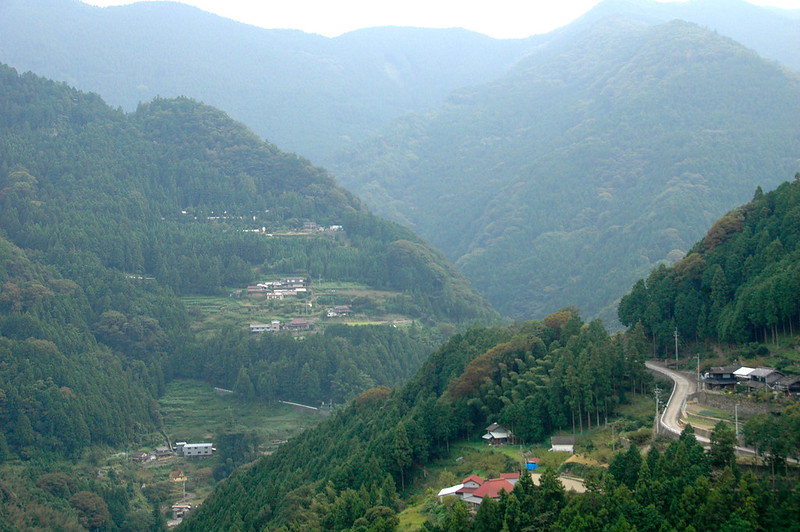
Back in our previous Japan post, we talked about what it’s like to travel to Japan on your own , particularly in Tokyo. We’ve covered the basic dos and don’ts when checking out the Land of the Rising Sun for the first time.
If you’re going to visit Japan, don’t settle for Tokyo. Although this place is amazing, this city doesn’t define the whole country. There’s a lot to see outside the capital.
Go off the beaten path and immerse yourself in Japan’s rural areas.
Why Visit the Countryside Areas of Japan

Japan is more than just Tokyo’s vibrant nightlife, seemingly endless energy and gastronomical delights. You’ll fall in love with what the countryside locations have to offer.
Here are great reasons to visit rural Japan:
Incredible Natural Scenery
Nature lovers, rejoice, as Japan has many breathtakingly beautiful nature spots to see. When you go on a nature vacation in this country, you’ll be amazed at the sights you’ll see on the way to the countryside.
You can look forward to seeing:
- A crystal-clear river coming down from the mountain
- A gorgeous field of flowers (especially the ones blooming in Hokkaido )
- A lush green bamboo forest
- Expansive rolling rice fields
Another great thing about this is that these areas aren’t typically crowded, as they’re not well-known to a lot of tourists. If you want a break from the urban sprawl, make sure to add exploring the Japanese countryside to your travel bucket list .
Tasty Seafood
There’s more to Japan’s cuisine than teppanyaki , Kobe beef and ramen. When you venture to Japan’s rural towns, you’re bound to stumble upon fresh and delicious seafood. Smaller cities, as well as villages, typically have a seafood specialty or two. Stopping by the Japanese countryside, therefore, will surely be worth your while.
One seafood you should give a shot is the formidable pufferfish, also known as fugu . This seafood is popular in Shimonoseki, a major fishing port situated in Yamaguchi Prefecture. Although Fugu is expensive, it’s a delicacy that has an exquisite and unique flavor — something you should try at least once when you travel to Japan’s rural areas.
Make sure you’re eating fugu only from reputable restaurants in Japan. The reason is that only licensed Japanese chefs are allowed to cook up a safe and delectable fugu dish. The wrong preparation or cut can poison or even kill a diner, as the internal organs of a pufferfish are more toxic than cyanide.
Great Culture and Friendly People
The culture of Japan in big cities can be a little difficult to see due to pop culture. When you check out the rural locations of the country, you get the opportunity to have an amazing cultural experience and learn about the history of that place.
What’s more, you’ll enjoy meeting the people in the countryside. When you’re exploring the city, you’re likely to come across busy people, such as salarymen in a rush.
Things are different in the countryside, though. The people in rural Japan seem friendlier. Plus, the pace of life feels slower and less intense. Don’t be surprised when a stranger you meet down the road smiles at you and greets you with a cheery “ Konnichiwa !” (Remember to greet back, OK?)
Little Surprises Along the Way
You’re bound to come across little treasures when you travel to Japan’s rural locations. You could, for instance, find a vending machine in the middle of a rice field. When you’re hiking along the mountains, you may stumble upon a hidden shrine that you can enjoy minus the crowds. These unexpected discoveries will make your trip more memorable.
Japan Rural Areas You Should Visit

Japan has so many countryside locations you can visit. Some are just a train ride or two away from Tokyo or Osaka. Others may take a whole day to get to your destination. Where you plan to go is ultimately up to you.
If you’re not sure where to begin, consider these lesser-known countryside areas of Japan:
You can find this rural location in Saitama, a prefecture neighboring Tokyo. Saitama prefecture has loads of simple and charming villages that serve as a testament to the area’s uniqueness.
One of these villages is Kawagoe. A trip to this rural area will transport you back in time, as this place retains the charm of the olden days. You’ll surely appreciate the old village vibes and historical structures that you won’t get when you stay in Tokyo.
Getting Here: You can get to Kawagoe by riding one of three different railway companies: JR, Tobu and Seibu. If you want the fastest route, ride a Tobu Toju train at Ikebukuro going to Kawagoe station. The journey should take approximately half an hour.
Situated in the mountainous region of Hida is Takayama, a tiny city in central Japan’s Gifu prefecture. This remote paradise is perfect for travelers searching for off-the-beaten rural paths in the country.
One activity you should include in your rural Japan travel itinerary is to check out Takayama’s Old Town. This scenic spot encompasses everything authentic and historical about the village. This town did a marvelous job of preserving historic buildings between the 1600s and the 1800s.
Getting Here: From JR Nagoya Station, transfer to the Takayama Main Line and take a train going to the JR Takayama Station. This trip is straightforward if you’re staying in the city of Nagoya.
Traveling to Takayama from other major cities, however, requires an additional step.
If you’re starting from Tokyo or Osaka, you’ll need to take the JR Tokaido Shinkansen ( Japanese bullet train ) traveling to Nagoya. The journey will take four hours if you’re coming from Tokyo. On the other hand, you’ll spend approximately over two hours if you start from Osaka. Given the lengthy travel times, make sure that you plan your trips wisely.
This countryside location is easily accessible from Osaka. This wonderfully tranquil town features the Minoo Waterfall, an excellent place to satisfy your Instagram fix and enjoy the beauty of nature.
Getting Here: From Hankyu Umeda Station, ride the train going to Ishibashi station. Then, transfer to the Hankyu Minoo Line and alight at Minoo station. The whole trip won’t take you more than an hour if you’re coming from Osaka.
Tips When Traveling to Japan’s Rural Locations
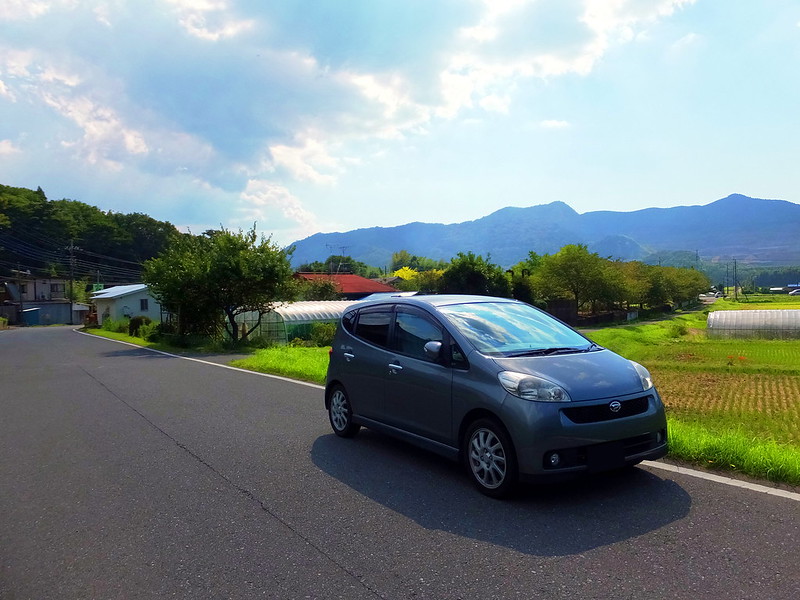
The way things run in Japan’s countryside areas is different from what you’ll find in big cities like Tokyo, Nagoya and Osaka.
When you’re going to explore rural Japan either by yourself or with someone else, keep these few important travel tips in mind:
Business Hours are Recommendations
When you see business signage that says “8:00 ~ 22:00” in a big city like Tokyo, you can safely assume that the establishment opens at eight in the morning and closes shop at ten in the evening.
Time, however, takes on a different meaning in Japan’s rural locations.
Sometimes, restaurant or shop owners need to close their establishment at any time without any advance notice. They could, for instance, have errands to run in the middle of the day or have sold out their goods or products earlier than expected.
If you’re unsure whether the establishment is open or not, look for the sign that says 営業中 (pronounced as eigyo-chu ). These words mean that the business is still serving customers.
Drive to Get to the Scenic Rural Spots
Unlike Tokyo where you can access tourist destinations by hopping on a train or a bus, many scenic spots are either hidden or far from public transportation stations or terminals. If you want easy access to these off-the-beaten rural paths, you’ll want to go with private transportation.
Take note, though, that Japan (just like the UK) drives on the left side of the road. You’ll also need an international driver’s license if you want to rent a car.
Accept the Generosity of the Locals
The locals you may meet from the countryside are incredibly generous. They could give you anything, such as a free meal or drink from the vending machine, a free tour around the area or a handcrafted souvenir.
Graciously refusing, and later on accepting the gift, is the proper approach in this situation. When a villager hands you a gift, initially pretend that you don’t want it. If they keep on insisting, accept the gift with a smile and say thank you in Japanese .
Rural Japan offers tons of undiscovered beauty and fun to all sorts of travelers. When you visit the land of the rising sun in the future, don’t just stay in the big cities. Get out of the urban sprawl and check out Japan’s hidden and less crowded countryside areas.
About the Author
Sallie strosin.
- Media & Industry
- Meetings & Events
- Select Language 简体中文 繁體中文(香港) 繁體中文(臺灣) India (English) Bahasa Indonesia 한국어 ภาษาไทย Tiếng Việt Singapore (English) Philippines (English) Malaysia (English) Australia/New Zealand (English) Français Deutsch Italiano Español United Kingdom (English) Nordic countries(English) Canada (English) Canada (Français) United States (English) Mexico (español) Português العربية Japan(日本語) Global (English)
- India (English)
- Bahasa Indonesia
- Singapore (English)
- Philippines (English)
- Malaysia (English)
- Australia/New Zealand (English)
- United Kingdom (English)
- Nordic countries(English)
- Canada (English)
- Canada (Français)
- United States (English)
- Mexico (español)
- Global (English)
- Fujiyoshida
- Shimonoseki
- Ishigaki Island
- Miyako Island
- Kerama Island
- Tokyo Island
- Koka & Shigaraki
- Hida Takayama
- Ginza, Nihonbashi
- Beppu & Yufuin (Onsen)
- Ginzan Onsen
- Nagasaki Islands

- Kumano Kodo
- Shikoku Karst
- Amami Oshima
- Hachimantai
- Omihachiman
- Aizuwakamatsu

- Diving in Japan
- Skiing in Japan
- Seasonal Flowers in Japan
- Sustainable Outdoors
- Off the Beaten Track in Japan
- Scenic Spots
- World Heritage
- Home Stays & Farm Stays

- Japanese Gardens
- Japanese Crafts
- Temple Stays
- Heritage Stays
- Festivals and Events
- Theater in Japan
- Japanese Tea Ceremony
- Cultural Experiences in Japan
- Culture in Japan

- Local Cuisine Eastern Japan
- Local Cuisine Western Japan
- Local Street Food
- Japan's Local Ekiben
- Japanese Whisky
- Vegetarian and Vegan Guide
- Sushi in Japan Guide
- Japanese Sake Breweries

- Art Museums
- Architecture
- Performing Arts
- Art Festivals
- Japanese Anime and Comics
- Japanese Ceramics
- Local Crafts

- Scenic Night Views
- Natural Wonders
- Theme Parks
- Samurai & Ninja
- Iconic Architecture

- Wellness Travel in Japan
- Japanese Ryokan Guide
- A Guide to Stargazing in Japan
- Relaxation in Japan
- Forest Bathing (Shinrin-yoku)

- Experiences in Japan
- Enjoy my Japan
- National Parks
- Japan's Local Treasures
- Japan Heritage
- Snow Like No Other
- Wonder Around Japan

- Visa Information
- Getting to Japan
- Airport Access
- COVID-19: Practical Information for Traveling to Japan
- Anime Tourism
- Countryside Stays
- Accessible Tourism
- Hokkaido Great Outdoors
- Scenic World Heritage in Tohoku
- Shikoku’s Nature and Traditions
- Southern Kyushu by Rail

- Traveling by Rail
- How to Travel by Train and Bus
- JR Rail Passes
- Scenic Railways
- Renting a Car
- Sustainable Travel in Japan
- Travel Brochures
- Useful Apps
- Online Reservation Sites
- Eco-friendly Accommodation
- Luxury Accommodations
- Traveling With a Disability
- Hands-free Travel
- How to Book a Certified Tour Guide
- Volunteer Guides
- Tourist Information Center

- Japanese Manners
- Spring in Japan
- Summer in Japan
- Autumn in Japan
- Winter in Japan
- Cherry Blossom Forecast
- Autumn Leaves Forecast

- Japan Visitor Hotline
- Travel Insurance in Japan
- Japan Safe Travel Information
- Accessibility in Japan
- Vegetarian Guide
- Muslim Travelers
- Safety Tips

- JAPAN Monthly Web Magazine
- Arts & Cultures
- Nature & Outdoor
- Festivals & Events
- Insider Blog
- Things to do
- Local Guides
- Food & drink
- Traditional
- Hokuriku Shinetsu

My Favorites
${v.desc | trunc(25)}
Planning a Trip to Japan?
Share your travel photos with us by hashtagging your images with #visitjapanjp
©Akitainutourism
- Heartwarming farm stays in rural Japan
Akita’s Odate region offers the perfect respite from hectic urban life
Get in touch with a different side of Japan in Odate, Akita Prefecture, home to the world-famous Akita Inu (dog). Experience the laid-back local life through a farmstay with a local agricultural family. Stay overnight, bond with your farm hosts, and experience a day in their life. Tend to the rice fields, pickle vegetables or harvest apples—even clear the snow off the roof in winter. There’s always something to be done (and you’ll be expected to help with the work and the cooking—and you’ll love it).
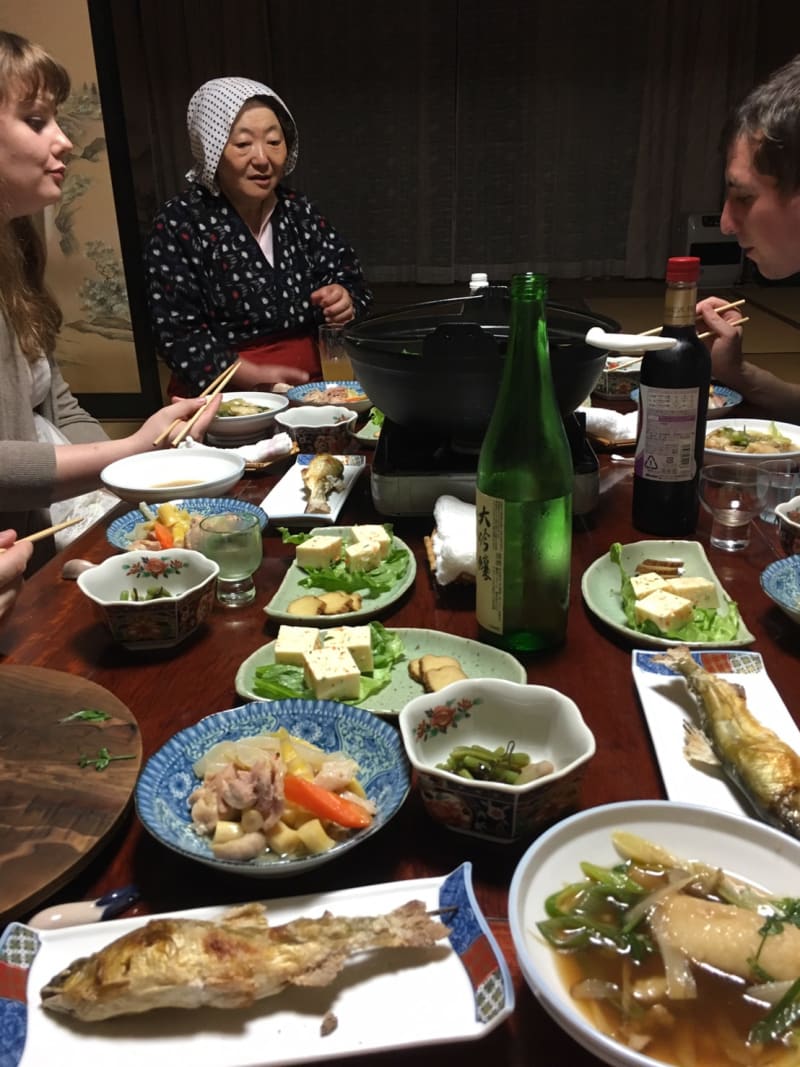
After sundown, as it grows cooler, learn how to make kiritampo nabe, a stew and local specialty. Kiritampo is made from freshly cooked rice which is then pounded into a paste, shaped around a skewer, and toasted, traditionally in an irori, or sunken hearth. The finished kiritampo is then added to the stew, creating something like a dumpling.
This is a wonderful opportunity to have a real family experience with Odate locals and to make lasting memories.
Access: From Tokyo Station, take the Akita Shinkansen to Morikoka Station (about two hours 12 minutes), then take the Shuhoku Bus to the Kosoku Odate stop (about two hours 12 minutes). By air, fly from Tokyo Haneda Airport to Odate-Noshiro Airport (about one hour 10 minutes), then take the limousine bus to Odate Station (about 50 minutes).
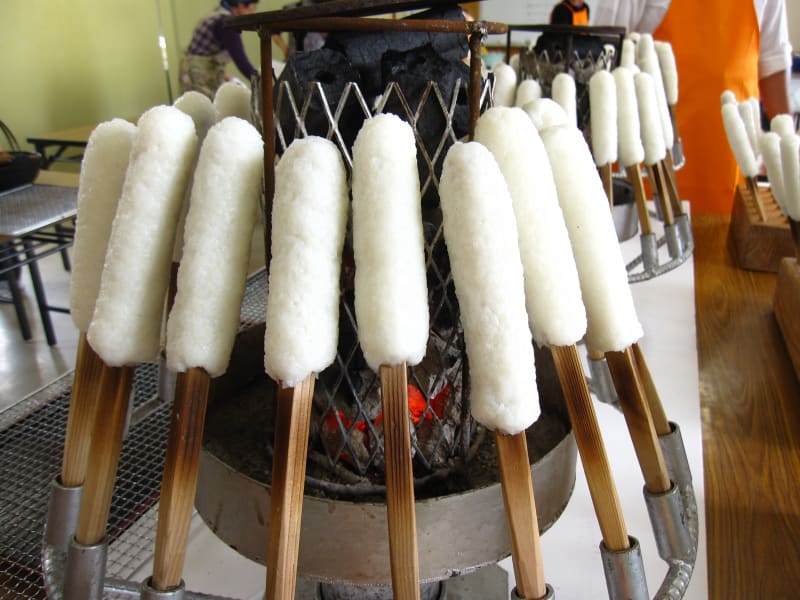
Contribution to Sustainability
Through an overnight stay, you can learn about Odate’s food culture while making an authentic kiritanpo , pickles, and so on. Enjoy farm-to-table food and dishes made with local ingredients both morning and dinner.
Authentic kiritanpo-making experience with mini farming (Odate Cultural Activity Promotion Committee)
Our recommendations, explore by interest.

Search by Area
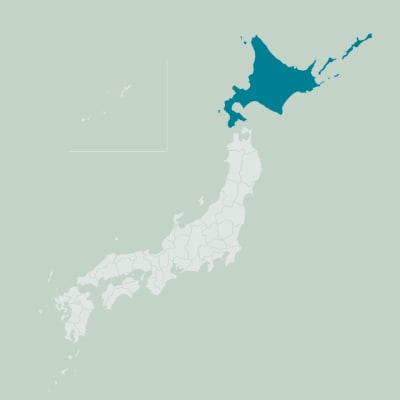
Please Choose Your Language
Browse the JNTO site in one of multiple languages

Experience Japan like a local
Upcoming tours 2025.

Kilns & Flowers
April 3 - 13, 2025 Few seats remaining
A 11-day kiln hopping tour amidst the blooming spring flower season, travelling through 5 prefectures in the Southern Island of Kyushu. Kyushu is a land full of energy and dramatic nature from mountains to seas. This third most prominent and southernmost of Japan's main islands is a dream destination for pottery lovers. Not only does it Read more
.jpg)
Northern Japan Food & Nature
May 7 - 16, 2025
Experience a 10-day immersive tour in northern Japan, perfect for nature and food lovers. Explore the beauty and taste of this region, often left unexplored. It is home to some of the finest foods and the most beautiful nature. The tour also includes a rare opportunity to learn about the natives of Japan, Ainu and Tokachi Millennium Forest, des Read more

Nakasendo & Japan Alps
April 27 - May 6, 2025 Few seats remaining
Join a 10-day walking tour of the historic Nakasendo and the spectacular Japan Alps. Let’s go back to nature with the Japanese way of forest bathing; it is soul-cleansing and healing. This tour takes you from historic Japanese walking trails to the majestic Japanese Alps during the colourful spring season. The tour includes four moderate walks Read more

Autumn Art Islands
November 4 - 14, 2025 Few seats remaining
Dive deep into the off-the-beaten path of Japan. Discover untouched places overgrown with time and new sights that transform culture and tradition. Spend an unforgettable 11 days in Shikoku and surrounding remote islands. This art tour begins with the Setouchi Art Islands. With scenic views blending landscape and imagination, the themed “ Read more

Why travel with us?
We are travel enthusiasts who have travelled to every corner of Japan. We love Japan.
We want to share our beautiful and delicious home country with you and are constantly exploring, discovering, learning, and contemplating how we can offer you a transcendent travel experience.
We design, curate, and lead authentic experience-focused Japan tours, all in-house.
We support sustainable communities and work with small local businesses as much as possible.
This way, you can also immerse yourself in Japan just like a local.
Our hearts glow when our customers fall in love with Japan.
The things we care the most

No language barrier
We believe interacting and connecting with locals is essential for an unforgettable trip. Throughout our tours, we don't just translate. We seamlessly switch between English and Japanese so you can understand and be understood.

Off-The-Beaten Path
All of Kuroko's tours travel to the unspoiled parts of Japan, which are difficult for individual travellers to access. Japan's ethos and aesthetics are often hidden in these places.

Care-free and Streamlined
We understand how a carefree holiday can powerfully uplift you. We also understand how precious everyone's time is. This is why we put the utmost focus on efficiency and effectiveness in our communication and travel arrangements.

What our tour guests say

Felicia Symonds
A truly memorable experience, the Food and Nature tour of Hokaido with the awesome Rika from Kuroko BoutiqueTours. Exceeding every expectation this tour delivered in spades. Amazing and varied meals in restaurants that the solo travel would never find let alone get a booking. Beautiful and varied accommodation. Onsen resorts large and small. Hikes in breathtakingly beautiful locations. All made possible by the knowledge and expertise of Rika, who, as the owner of Kuroko gives her clients 110%. Thanks Rika. Loved it all.
_edited.jpg)
Jenni Papst
We are SO THANKFUL to Rika for her thoughtful curation of the tour we recently returned from. The pace of the group we were placed with was perfect for us, and we were a wonderful bunch to travel with. There are so many beautiful memories we will treasure forever. We loved every moment of hiking, walking, exploring, eating and soaking with our fun team. Yuki was the best fun and so knowledgeable about everything we were interested in. Our tour has truly opened our minds and hearts to this country; sensing it’s beautiful nature, culture and creativity has been a privilege. We’ve returned home to our garden and house restoration projects inspired! We yearn now to experience Tokachi Millenium Forest in early September, Ashikaga Flower Park in April/May and Kyushu Onsens in November!
Other services

Custom Group Tour
.jpg)
Custom Itinerary

Be the first to know Kuroko's new stories & next destinations
Thanks for subscribing!

IMAGES
VIDEO
COMMENTS
5. TAKACHIHO GORGE IN MIYAZAKI JAPAN - A NATURAL WONDER OF THE WORLD. Sheer cliffs on the Gokase River make the narrow chasm of the Takachiho Gorge —the treasure of Miyazaki Prefecture. If you rent a rowboat, you'll come across the cascading Minainotaki Waterfall. You can also see it from above on a paved path.
Treat them simply as inspiration, because your trip will be created individually by one of our specialists to match your tastes and budget. Day 1- Welcome to Osaka. Day 2- Kameoka - Home Stay. Day 3- Explore Rural Japan. Day 4- Arashiyama. Day 5- Private Local Guide in Kyoto. Day 6- Day Trip to Nara. Day 7- Kyoto - Tour Ends.
Rural and Remote Tours of Japan. The 2024 & 2025 Remote Japan Tours will let you discover Japan's hidden rituals, unspoiled spectacular scenery and delightful local people. Japan is so much more than Tokyo, Kyoto, Takayama and Hiroshima. There are so many hidden gems and unexplored destinations in Japan's countryside.
This 3 week, comprehensive guided tour will take you on a journey through a Japan of contrasts, both historical and rural. After Tokyo, Kyoto, Mount Fuji and Koyasan, take a boat trip to discover the Japanese countryside on Kyushu. Finish off with the sacred island of Miyajima. Small group of 8 people, accompanied by an English-speaking guide and specialist. An unforgettable trip.
Our self-guided and small-group guided tours are carefully crafted by a team of experts with a passion for Japan. Select a destination and get started on planning your Oku Japan adventure today. All destinations. A focus on getting away from the crowds & into the real Japan, thoughtfully created itineraries by those with a passion for Japan.
Enjoy the relaxed pace as you travel through rural Japan to experience Japanese living first hand. Stay in a lovely country home built in traditional architecture away from the big cities. Visit 700-year-old temples and walk along the back streets of Kyoto to buy antique kimonos where the local people shop. Visit acclaimed pottery workshops and try your hand at pottery making and indigo batik ...
Come and experience rural Japan for a day. Visit the Dragon Taming Temple. Dine on the sneaky Iwana fish at Black Mountain Three Falls. Enjoy lunch on the summit of the mountains. Visit the temple of Sandals and end the day walking through Old Edo, Tokyo, Kawagoe. Learn more. ¥40,000- per person. (Lunch included)
Explore rural Japan in two weeks! This curated adventure covers off-the-beaten-path gems to uncover another layer of Japan rarely seen by tourists, and experience rural life in Japan, from Kyoto's ancient charm to Hiroshima's poignant history and Miyajima's iconic Torii Gate. Discover Shikoku's hot springs, Takamatsu's gardens, and art in Naoshima.
Rural Japan 15 day tour. An off-the-beaten-path adventure through Japan's countryside, from £12097 (15 days) ex flights. Toggle navigation. menu. 1-866-821-6866 . Call toll free. Destinations; ... Your stays in rural Japan will also be a chance to support local communities, as this tour includes an overnight stay at a monastery at Mount Koya ...
Craft & Culture Tours. The Ina Valley craft & culture tours the we offer are also pioneered by us. They offer you a chance to get deep inside of rural Japan and into undiscovered places rich in history and culture. Combinations. Many of the Ina Valley tours are half day experiences.
This 14-Day Autumn Rural Japan Private Tour is our ultimate off-the-beaten path itinerary. You will travel quieter parts of Japan, where the gorgeous autumn colours will accentuate your holiday. The tour takes you north of Tokyo, including UNESCO World Heritage listed Nikko and former feudal towns of Aizu-Wakamatsu as well as gorgeous Kakunodate.
The countryside of Japan is a testament to the country's incredible geographical diversity and its profound respect for nature. Diverse Landscapes: From the snow-capped mountains of Hokkaido to the lush forests of Kyushu, the natural beauty of rural Japan is both varied and mesmerizing. Places like the Japanese Alps offer breathtaking vistas, while the terraced rice fields in areas like ...
Welcome to Really Rural Japan. We are a locally-based, eco-tour operator in the Kiso Valley and Ina Valley of southern Nagano. I am the founder Mike, I specialize in hiking, nature, history, and rural life in the mountains of central Japan. I am also currently the only foreign master craftsman of wara-zaiku, a traditional Japanese craft that ...
Description of Rural Japan 15 day tour. If you're looking for a more authentic and off-the-beaten-path alternative to Japan's futuristic cities, then you need to head out to the rewarding landscapes, epic mountains and tiny islands which make up the majority of this diverse country. You'll start in Kyoto, a former ancient capital, with a Zazen ...
Cook up some delicious tanpo! (Photo: Countryside Stays Japan) Farm Inn Sakekoshimai, located in Odate City, Akita Prefecture, is a welcoming, family-centered inn that offers insights into the local culture. The traditional building, complete with tatami mats for sleeping, makes travelers feel as if they have stepped into the past.
Follow the tour with a trip to the local public hot springs and or choose from other experiences in the rural village. Contact us to book. Foraging culture is alive and well in rural Japan. When spring rears its beautiful head after the long cold winters of the Japanese mountains, the locals burst into life, picking shoots, buds, leaves and more.
Day 1: Arrive in Kyoto, Japan. Day 2: Unique Highlights of Kyoto (On & Off The Beaten Path) Day 3: Fushimi Inari Shrine & Luxurious Ryokan Stay in Kurashiki. Day 4: Private Tour of Historic Kurashiki. Day 5: Visit Naoshima, Japan's Wonderful Art Island. Day 6: Teshima Island & the Teshima Art Museum. Day 7: Travel to the Remote Ise Shima ...
Deeply Regional Japan specialises in small group and private tours to non-mainstream, regional destinations in Japan. Our rural and eco tours showcase the best of Japan's ancient culture and traditions, including crafts and food, and beautiful natural landscapes, for a personal and meaningful travel experience.
If you have a curiosity to discover our hidden treasure of nature and culture rural tours in Japan, please join us now! Connect with us us and be a part of our community. 35° 5' 52.987" | 138° 34' 08.5". Discover and explore the hidden beauty of rural Japan with our private customized eco tours in Yamanashi Japan & Mt Fuji World Heritage area.
Shiga-based Tour du Lac, for example, runs custom-made sustainable cycling tours along the shores of Lake Biwa, Japan's largest freshwater lake. Meanwhile, Gifu-based Satoyama Experience guides guests through some of the area's most scenic villages and cycling routes, as well as the castle town of Hida-Furukawa and off-the-beaten-path gems.
One activity you should include in your rural Japan travel itinerary is to check out Takayama's Old Town. This scenic spot encompasses everything authentic and historical about the village. This town did a marvelous job of preserving historic buildings between the 1600s and the 1800s.
Heartwarming farm stays in rural Japan Akita's Odate region offers the perfect respite from hectic urban life Get in touch with a different side of Japan in Odate, Akita Prefecture, home to the world-famous Akita Inu (dog). Experience the laid-back local life through a farmstay with a local agricultural family.
Experience Japan like a local with Kuroko Boutique Tours, your Japan travel experts. Discover our small group tour packages to Japan focusing on 'off the beaten path' experiences. Travel to Japan with our unique Japan tours for Kilns and Flowers, Nakasendo and Japan Alps, Northern Japan Food and Nature tours and Autumn Art Islands tours. We also offer custom Japan tours and itinerary for ...